[CES 2023] 삼성전자 부스 I Samsung booth
#삼성전자 #Samsung #CES2023
▶2023 OLED KOREA
https://oledkoreaconference.com
▶유비리서치 홈페이지
https://ubiresearch.com
▶OLED관련 최신뉴스가 궁금하다면?
https://olednet.com
▶비즈니스, 디스플레이 보고서 문의
marketing@ubiresearch.com
02-577-4391
#삼성전자 #Samsung #CES2023
▶2023 OLED KOREA
https://oledkoreaconference.com
▶유비리서치 홈페이지
https://ubiresearch.com
▶OLED관련 최신뉴스가 궁금하다면?
https://olednet.com
▶비즈니스, 디스플레이 보고서 문의
marketing@ubiresearch.com
02-577-4391
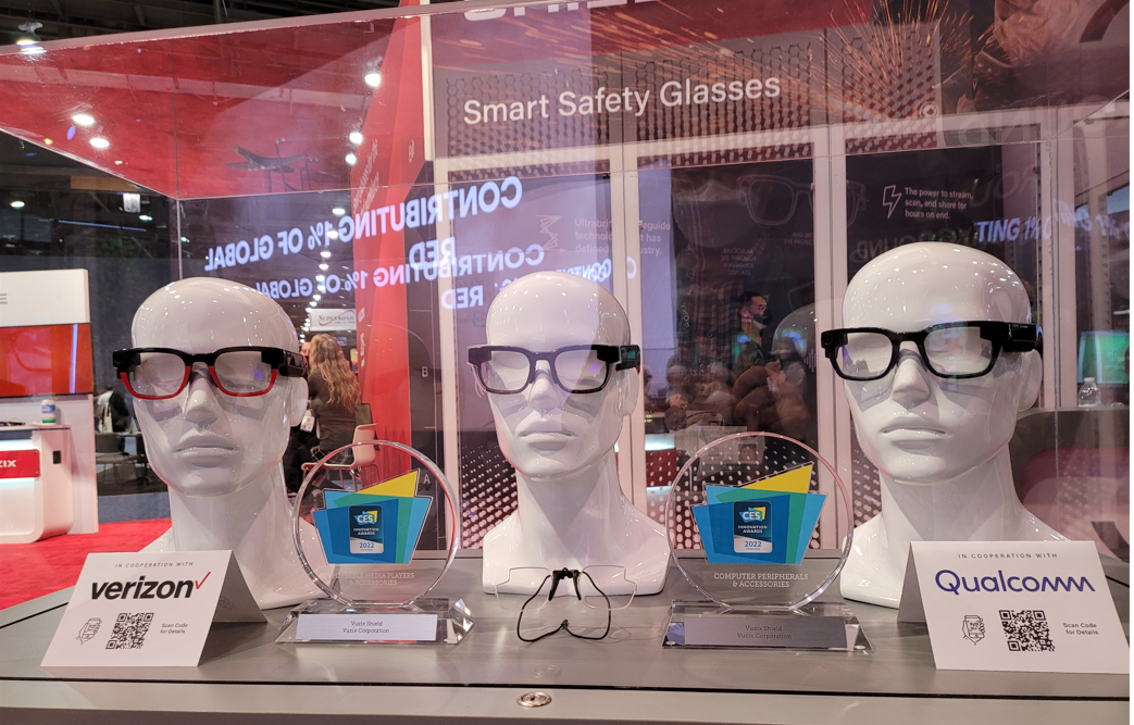
CES2022에 전시된 AR글라스
가상현실에 대한 관심이 날이 갈수록 뜨거워지고 있다. 구글, 메타, 삼성 등 국내외 테크기업들이 가상현실과 관련한 움직임을 구체화하면서 경쟁에 돌입했다.
구글은 지난 19일 자사 블로그를 통해 8월부터 구글의 AR글라스 시제품을 현실에서 테스트하겠다고 밝혔다. 2012년 AR글라스를 처음 선보인 뒤 10년 만이다.
구글의 AR글라스는 일상에서 실시간 번역을 가능하게 해준다. 안경처럼 착용하는 형태의 AR글라스를 통해 상대방의 언어가 번역되어 안경의 하단에 자막으로 표시된다. 다만 구체적인 제품명이나 판매 시점은 정해지지 않은 것으로 알려진다.
메타는 VR 기기 시장을 주도하고 있다. 2014년 오큘러스를 20억 달러에 인수하며 VR 기기의 대중화를 이끌었다. 지난해 기준 VR/AR 시장 점유율이 78%에 달한다. 메타는 지난 6월 망막이 구분하기 어려울 정도로 높은 해상도를 구현한 VR 헤드셋 ‘버터스카치’를 공개했다. 버터스카치는 시야각을 넓혀주고 사물을 정교하게 보여주는 VR 헤드셋이라고 설명했다. 이 밖에도 밝기가 1만 니트에 달하는 헤드셋(스타버스트), 가변 초점 렌즈를 장착한 연구용 헤드셋(하프돔 3) 역시 공개했다.
삼성전자는 최근 메타의 자회사인 오큘러스 VR 출신의 윤가람 상무를 삼성리서치 VR 책임자로 영입했다. 윤 상무는 오큘러스 VR에서 AR,VR의 모델링 작업 및 미광 현상 연구 등을 수행한 것으로 알려졌다. 삼성전자 역시 인재영입을 통해 AR글라스 사업을 확장하려는 것으로 해석 된다.
유비리서치 이충훈 대표는 유튜브를 통해 국내외 테크기업들이 VR 기기들을 준비 중이라고 설명했다. VR 장비에 적용되는 마이크로 디스플레이로는 OLEDos로 바뀌는 추세다. LCos보다 응답속도가 빠르고 색감이 좋고, Contrast Ratio 또한 높기 때문이다.
중국과 미국의 신냉전 시대에 들어서면서 한국 디스플레이 업계가 수혜를 받게 될 것이라고 예상했다. Micro OLED는 군사용으로 사용되고 있어 미국 기업들이 중국으로부터 공급을 배제할 가능성이 높기 때문이다.
LG디스플레이는 지난 6월 선익시스템으로부터 증착기를 발주했다고 전했다. 이 대표는 ‘국내 업체가 Micro OLED 장비 표준화가 되는 쾌거를 이루면 좋겠다고 덧붙였다.
관련 동영상 : VR이 TV와 모니터를 대체할 수 있을까? 업계 움직임은!?
관련 보고서 : 2022 Micro-display보고서
이번 영상에서는 혁신을 동반하는 기업 애플의 OLED 제품 로드맵에 대하여 다루었습니다.
애플 제품의 OLED는 삼성디스플레이와 LG디스플레이로부터 공급받습니다. 디스플레이 산업에서도 애플의 존재감은 대단합니다.
유비리서치가 예상하는 애플의 폴더블 노트북 모습은 영상과 같습니다. 애플은 또 한 번 어떤 혁신적인 제품을 준비하고 있을까요?
※ 본 영상은 UBI Research의 스페셜 보고서 ‘2022 Micro-Display 기술 보고서’ 를 바탕으로 제작되었습니다.
VR 기기를 사용해 보신 적 있으신가요?
VR은 몰입감과 임장감이 굉장히 중요합니다.
선명한 화질을 위해 Micro-OLED는 VR 장비에서 필수적입니다.
가까운 미래에는 VR이 모니터와 TV를 대체할 수 있을까요??
Micro Display 시장에서도 한국 기업이 중요한 역할을 할 수 있길 기대해 봅니다.
오늘도 시청해 주셔서 감사합니다.
※ 본 영상은 UBI Research의 스페셜 보고서 ‘2022 Micro-Display 기술 보고서’ 를 바탕으로 제작되었습니다.

<프로그램>
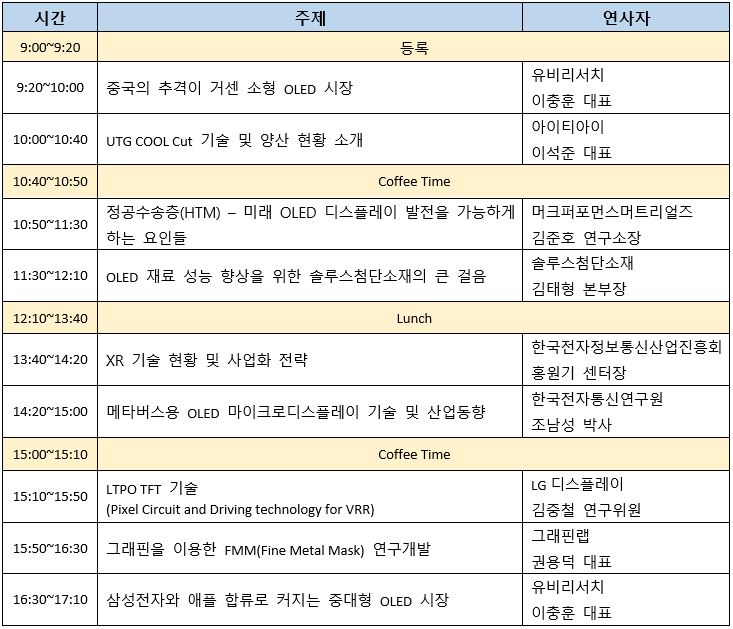
* 상기 일정은 연사자 사정에 의해 변경될 수 있습니다.
한국디스플레이산업협회에서는 올해 60주년을 맞은 “SID Display Week 2022(5.8-13)”의 주요 내용을 공유하고, 향후 디스플레이분야 국가 R&D 추진 방향을 모색하고자 “SID 2022 리뷰 심포지엄”을 5월 18일 삼정호텔 제라늄홀에서 진행되었다.
경희대학교 권장혁 교수는 SID2022 OLED 핵심제품 Trend와 OLED 핵심 기술에 대해서 발표했다.
■ OLED TV 대형화
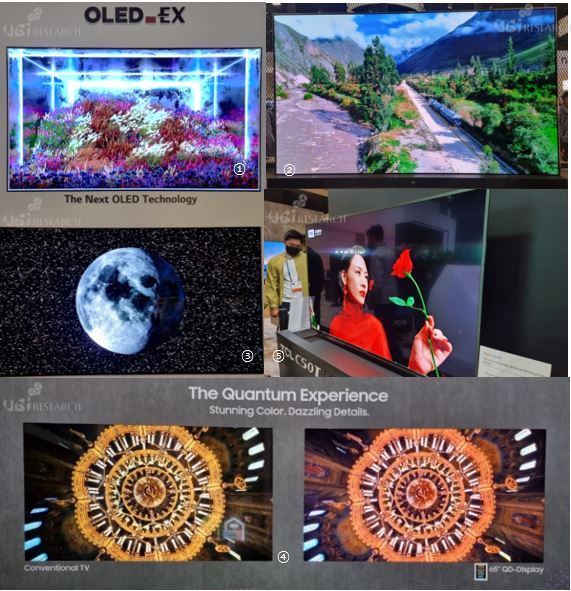
BOE 에서는 QD-OLED 65inch, TADF를 이용한 OLED TV를 전시하였으나. 줄이 나가 있었고, 다음날엔 패널에 불이 들어오지 않았다. 제품의 특성은 좋지 않았지만, 다양한 방식의 기술을 과시하면서 OLED 제품 개발에 힘을 쏟고 있다는 것을 보여주고 있다.
■ 다양한 Sensor 내장형 디스플레이 대거 등장
UPC(under display camera), Photosensor, Image sensor, Haptic기술, 곡면 Touch Sonsor 기술들을 적용한 제품이 전시되었다.
■ 다양한 Foldable 디스플레이 대거 등장
Samsung의 Z foldable, inside foldable, Foldable Note PC, 게임 디스플레이, LGD의 360도 foldable OLED, Foldable Laptop이 전시되었다.
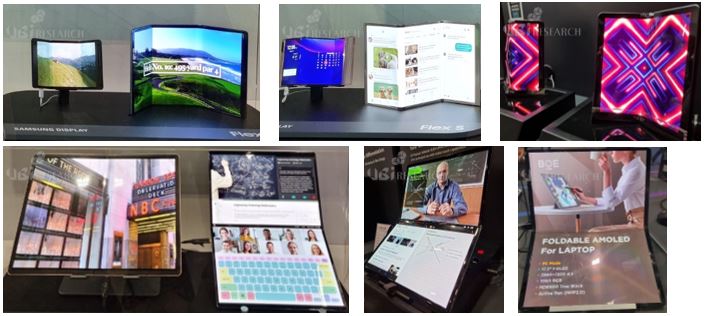
■ 다양한 Rollable 디스플레이 등장
Samsung은 확장형 디스플레이기술인 6.7inch 디스플레이와 좌우로 모두 확장가능한 rollable 디스플레이를 전시하였다.

■ 다양한 자동차용 디스플레이 등장
LGD의 곡면형 OLED 디스플레이와 BOE의 Sensor 일체형 OLED 디스플레이가 전시되었다.
■ LGD의 창문형 투명 OLED 디스플레이와 최고 해상도 OLEDos
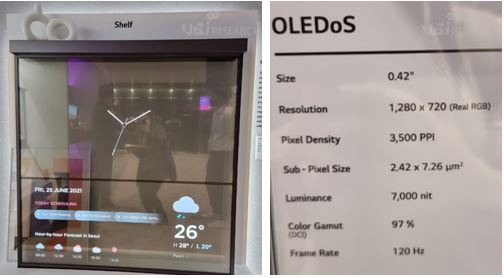
■ 인광 blue의 상용화 가능성
-Samsung에서는 장수명 Pt dopant와 우수한 특성의 Exciplex Host를 개발하였다. 인광 blue LT70 1000시간 수명을 달성했으며, TADF final dopant를 이용한 고색순도 및 장수명화를 추진중에 있다.
Idemitsu Kosan에서는 형광 blue 효율 향상시키는 논문을 Best paper상을 수상했으며, bottom Emission 기준으로 12%EQE를 달성하였다. Top Emission 기준으로 259BI 효율을 달성했으며, LT95 기준으로 50mA/㎠에서 195h 수명을 발표했다. 350BI, 17%EQE 달성을 추진 목표로 하고 있다.
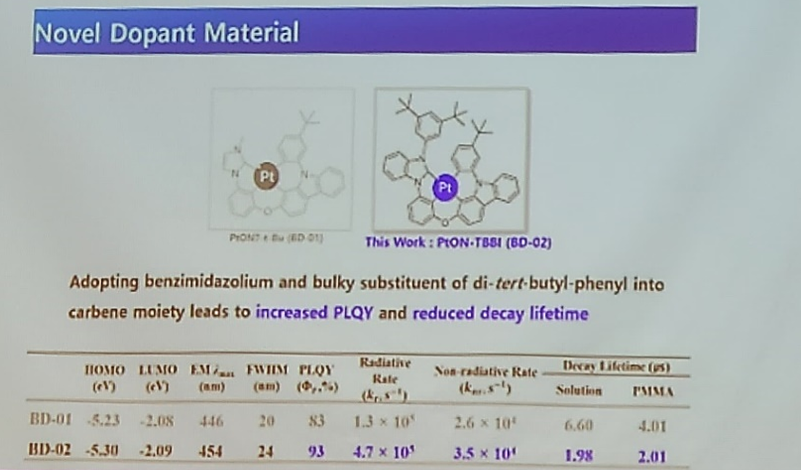
<Samsung의 사용 가능한 인광 blue 개발>
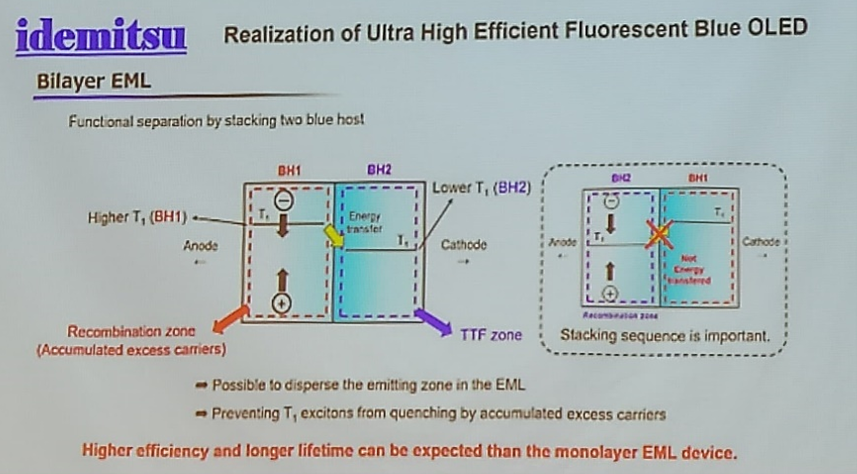
<Idemitsu Kosan의 형광blue 효율 향상 Best Paper 상>
■ 인광 재료의 Pt 재료로의 변경
인광 도펀트 Ir에서 Pt로 옮겨가는 추세이며, Pt 재료가 효율이 더 높고, FWHM이 좁고, 우수한 분광 특성을 나타낸다.
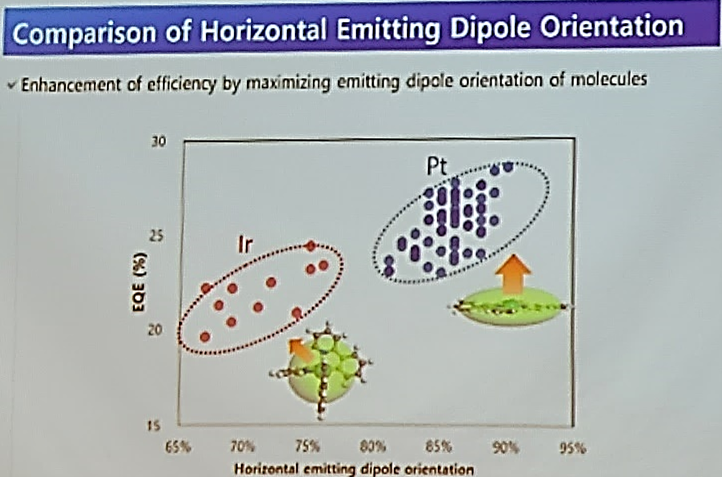
<인광 도펀트 Ir과 Pt 효율 비교>
결론적으로 권장혁 교수는 중국의 발 빠른 기술 추격으로 겉보기에는 기술경쟁력이 거의 동일 수준에 근접하고 있어, 기술 경쟁력을 확보하기 위해서는 다양한 센서의 내재화기술, 새로운 신 OLED 재료기술, 우수한 OLED 소자 신뢰성 확보 등 기술적인 진보에 매진할 필요성에 대해 강조했다.
SID Display Week 2022 (디스플레이 위크 2022)를 다녀왔습니다. 코로나 19 여파로 인해 오프라인으로는 3년 만에 개최되었습니다.
삼성은 QD 디스플레이를 전면에 내세워 OLED 대세화를 보여주었습니다. 양방향 슬라이더블 기술과 디지털 콕핏을 선보였습니다.
2022년 4월 6일부터 8일까지 개최되고 있는 유비리서치의 ‘2022 OLED KOREA CONFERENCE’의 key note session에서, 삼성 디스플레이의 최용석 상무는 Covid-19로 인해 재택 근무를 포함하여 집에서 활동하는 시간이 길어지면서 디스플레이 기기의 사용 시간이 늘어나고, 이로 인해 OLED의 중요성이 더욱 더 부각됐다고 밝혔다.

최 상무는 Covid-19로 인해 집과 회사에서 유기적으로 근무하는 형태가 증가하고, 집에서 생활하는 시간이 길어지며 개인 컴퓨터의 사용이 증가했다고 밝히며, Covid-19가 디스플레이 기기의 개인화를 촉진시켰다고 발표했다.

특히, 최근 눈에 띄게 증가하고 있는 IT 시장에서 디스플레이의 화질뿐만 아니라 휴대성, 배터리 시간, 친환경도 같이 부각되었다고 밝히며, OLED가 이러한 소비자들의 요구를 충족시킬 수 있을 것이라 언급했다.
최 상무는 삼성 디스플레이의 OLED가 진정한 true black 구현이 가능하고, DCI-P3 기준 120%에 달하는 넓은 색재현율, 장시간동안 디스플레이를 사용해도 눈에 무리가 없도록 하는 청색 빛 저감 기술과 플리커 프리 등 다양한 장점을 소개했다.

마지막으로 OLED는 가볍고 단순한 디자인이기 때문에 휴대성이 매우 높아 개인용 디스플레이 기기에서 주류로 사용될 것이라 언급하며 발표를 마쳤다.
4월 6일에 열린 유비리서치의 ‘2022 OLED Korea Conference’에서 유비리서치 이충훈 대표가 ‘OLED Market Review’에 대해서 발표하였다.

이 대표는 2022년 이슈를 중심으로 전체 OLED산업 현황과 시장, 전망에 대해서 발표하였다.
이 대표는 먼저 최근 OLED 산업의 큰 이슈인 OLED TV사업에 대해 발표했다. 이 대표는 “지난해 말부터 OLED업계를 뜨겁게 달구고 있는 가장 큰 이슈는 OLED TV다. 삼성디스플레이의 대형 OLED 사업 재진입과 삼성전자와 소니의 QD-OLED TV판매, 삼성전자와 LG디스플레이의 협업의 가시화 등의 주제가 있다”고 언급했다.
TV용 OLED패널 수요 공급 전망에서 이 대표는 “삼성전자가 LG디스플레이로부터 OLED 패널을 구매해 OLED TV 사업을 진행한다면, LG디스플레이와 삼성디스플레이는 올해 총 1,200만대의 TV용 OLED패널을 공급할 수 있다. 그 중 수요량은 1,170만대로 공급 과잉은 3%에 불과하다”고 분석했다. 또 “삼성전자의 합류로 OLED TV 패널 수요량은 2023년 1,300만대, 2025년 2,000만대까지 확대될 전망이다. 확장되는 시장에 따라 올해 3분기까지 기업들의 설비 증설이 필요하다”고 전망했다.

이어 이 대표는 “LG디스플레이는 지난해부터 8.5세대 OLED 라인 증설 자금 확보에 힘썼으며, 올해 안으로 45K의 추가 증설 자금을 확보할 것으로 추정된다. LG디스플레이의 추가 조치로 TV용 OLED 패널 시장은 2023년 1,350만대, 2024년 이후 1,600만대에 이를 것으로 보인다. 다만 2,000만대 이상의 시장을 확보하기 위해서는 내년 안으로 10.5세대 투자 결정이 필요하다”고 분석했다. 또 “삼성디스플레이가 투자를 한다면 10.5세대 투자가 바람직하지만 8.5세대 투자를 진행할 것으로 예상된다”고 말하며 “LG디스플레이가 투자하든, 삼성디스플레이가 투자하든, 10.5G 투자를 위해서는 삼성전자와 장기 공급계약이 선행돼야 한다. 투자를 진행한다면 삼성디스플레이는 자체 자금을 확보할 것으로 예상되지만, LG디스플레이는 삼성전자와 공동 투자가 필요할 것으로 예상된다”고 전망했다.

한편, ‘2022 OLED Korea Conference’는 국내외 디스플레이 업계 주요 기업들의 유명 연사들과 교류 및 비즈니스 관계, 파트너십을 구축할 수 있는 컨퍼런스이다. ‘2022 OLED Korea Conference’는 4월 6일 tutorial을 시작으로 7일과 8일에는 business conference를 진행할 예정이다.
2021년 하반기에 출시된 삼성전자의 ‘Galaxy Z Fold3’에는 폴더블폰 최초로 펜 기술이 적용되었다. Galaxy Z Fold3가 출시되기 전, 펜 방식으로 active electrostatic solution(AES)이 적용될지 electro magnetic resonance(EMR)가 적용될지 많은 추측이 있었으나, 최종적으로 EMR 방식이 적용되었다.
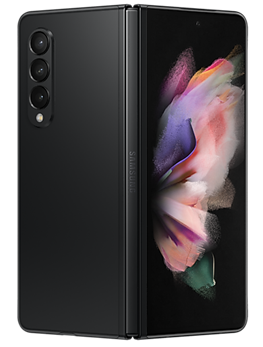
<삼성전자의 Galaxy Z Fold3, source: Samsung.com>
삼성 디스플레이는 디지타이저의 유연성 이슈를 극복하기 위해, 패널 양 옆에 1장씩의 디지타이저를 배치하였으며, 터치 인식 방해가 있을 수 있는 메탈 플레이트 대신 탄소섬유강화플라스틱(carbon fiber reinforced plastic, CFRP)를 사용하였다.
폴더블 OLED 용으로 CFRP를 생산하는 대표적인 업체는 라컴텍이 있으며, TORAY와 희성촉매, 풍산 등도 CFRP를 개발 중이다.
최근 BOE나 CSOT, Visionox등 중국 패널 업체들도 CFRP 업체들에 해당 재료 공급을 문의하고 있으나, 상황이 여의치 않은 것으로 알려졌다. 기존 패널 업체와의 관계도 고려해야 하며, 폴더블 OLED 용으로 CFRP를 양산하는 업체수도 많지 않기 때문이다.
폴더블 기기가 기존의 스마트폰 시장뿐만 아니라 향후 노트와 태블릿 PC 시장까지 침투하기 위해서는 펜 기술 적용이 필수이기 때문에, CFRP는 폴더블 OLED의 핵심 재료가 될 것으로 예상된다.
지난 2021년 65인치 기준 삼성전자의 QNED TV와 LG전자와 Sony의 OLED TV 가격을 분석하였다.
삼성전자는 4K 하이엔드 모델인 QN90A와 8K모델인 QN800A, QN900A을 시작으로 보급형 모델인 QN80A와 QN85A을 순차적으로 출시하였다. 출시가격은 4K 모델인 QN90A와 QN85A, QN80A가 각각 2,600달러와 2,200달러, 1,700달러, 8K 모델인 QN900A와 QN800A의 가격은 5,000달러와 3,500달러로 책정되었다. LG전자는 하이엔드 모델인 G1을 시작으로 보급형 모델인 A1, C1모델을 출시하였다. 출시가격은 G1와 C1, A1 모델순으로 각각 3,000달러와 2,300달러, 2,000달러였다. Sony는 XR65A80J와 XR65A90J 두 제품을 출시하였다. 출시가격은 XR65A90J는 4,000달러, XR65A80J는 2,800달러였다.
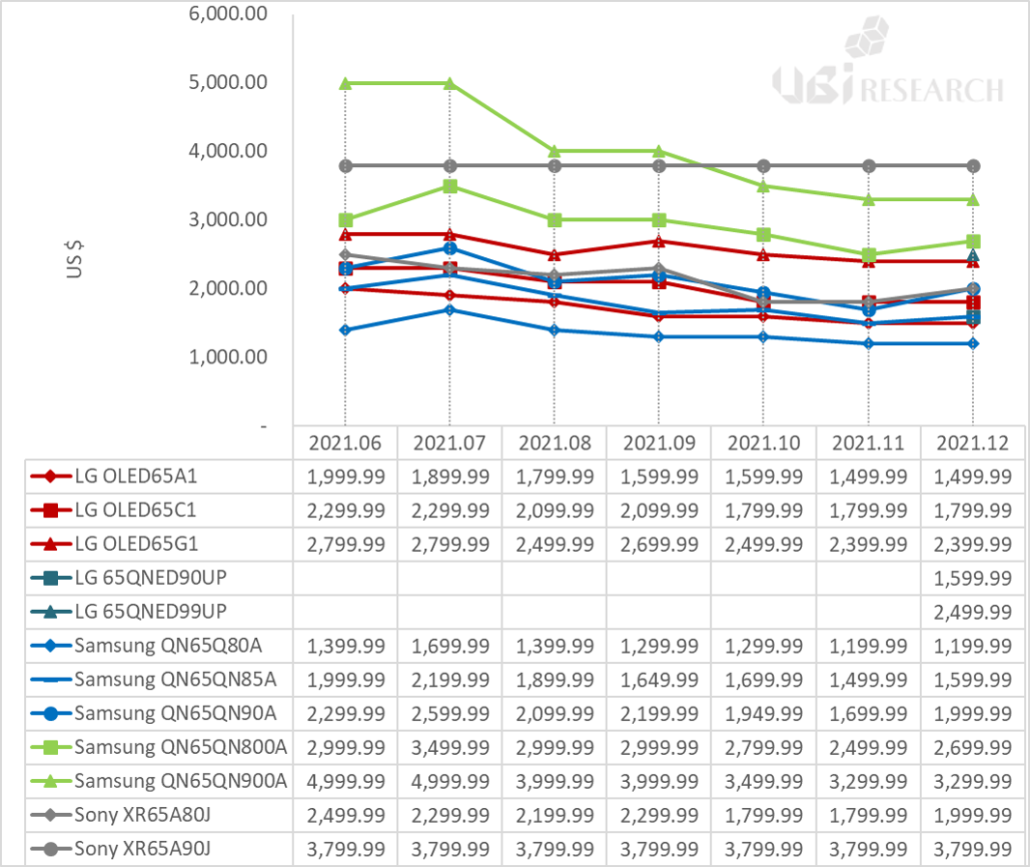
2021년에는 2020 도쿄 올림픽과 블랙프라이데이 등의 행사에 발 맞춘 업체들의 공격적인 마케팅이 눈에 띄었다.
삼성전자는 도쿄 올림픽과 블랙프라이데이로 인한 두번의 가격인하로 8K 모델인 QN900A와 QN800A가 출시 가격 대비 각각 1,700달러와 800달러 낮은 가격을 형성하고 있다. 4K 모델도 마찬가지로 90A와 85A, 80A순으로 출시 가격 대비 각각 700달러와 800달러, 500달러의 가격을 인하하며 LG전자의 동급 모델보다 평균 300달러 낮은 가격대를 형성하고 있다.
LG전자의 TV들도 마찬가지로 도쿄올림픽의 영향을 받는 6월을 시작으로 출시 가격 대비 평균 300달러의 가격 인하 마케팅을 진행하였고, 블랙프라이데이의 영향을 받는 10월부터는 평균 200달러의 가격을 낮췄다. 한편 LG전자의 8K QNED TV인 65QNED99UP 모델은 2,500달러로 위 표의 8K모델들 중 가장 저렴한 가격이었다.
끝으로 Sony의 XR65A80J모델은 11월 1,800달러로 출시 가격 대비 1,000달러까지 가격이 떨어졌으나 12월에 2,000달러까지 가격을 회복하였고 하이엔드 모델인 X65A90J는 출시 다음달 200달러의 가격 인하 이후로는 가격 변동이 없었다.
TCL은 오랫동안 mini-LED TV를 전시하며 mini-LED TV 시대가 도래하기를 기다린 업체이다. CES2022에서는 8K와 4K mini-LED TV를 대거 출품하였다.

<TCL 8K (left) & 4K (right) mini-LED TV>
전시된 8K와 4K mini-LED TV에는 local dimming zone을 노출하지 않기 위해 각각 thousands와 hundreds로 표기되어 있었다. 추정되는 4K의 local dimming zone 수는 900 정도이다.
TCL은 자사의 mini-LED 장점을 강조하기 위해 별도의 코너를 마련하여 OLED와 비교한 특성표와 3.9mm의 초박형 8K mini-LED를 설치하였다.
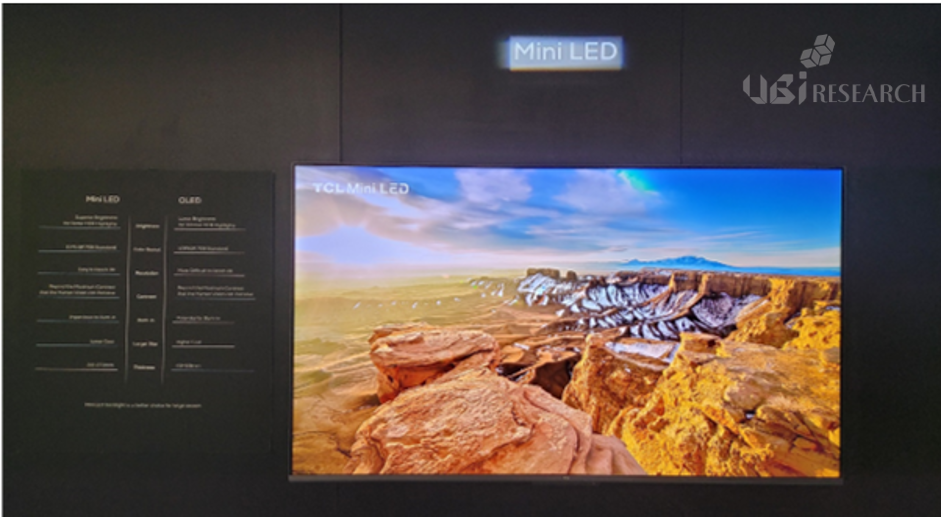
올해부터는 삼성전자 마저도 OLED TV 사업을 시작하여, OLED TV 진영에 빠져 있는 TCL은 Mini-LED TV만으로 프리미엄 TV 시장을 공략해야 하므로 적극적인 홍보 태세로 전환하였다.
상기 사진의 좌측에 OLED TV와 비교하여 Mini-LED TV의 장점을 명기하였는데, 휘도와 color gamut가 우수하고, 8K를 만들기 쉬움을 장점으로 꼽았다.
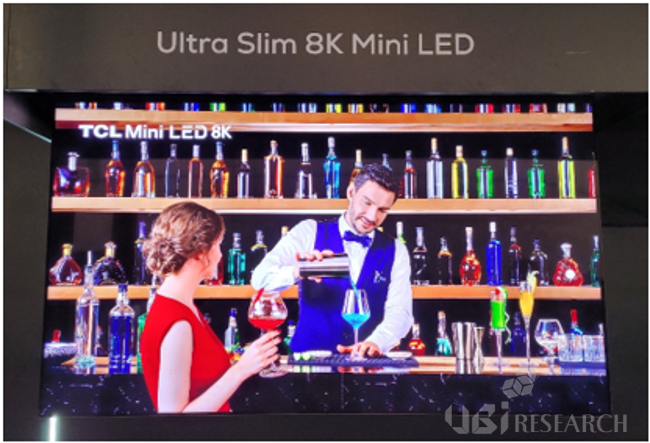
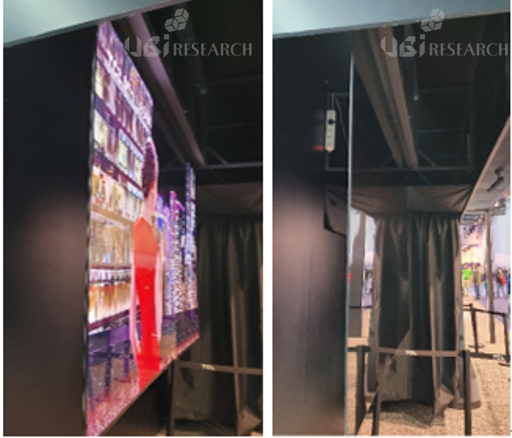
<3.9mm 8K Mini-LED TV>
이번 전시에서 TCL이 보여준 초박형 mini-LED TV는 참관자들로부터 관심을 끌기에 충분한 제품이었다. 초박형이기 때문에 가벼운 무게이므로, 천정에 스크린처럼 장착하여 전시하였다. OLED TV는 이런 방식의 전시가 많이 있으나, LCD TV에서는 처음 보는 장면이었다.
이 제품의 local dimming zone은 2000 정도이지만, LED를 많이 사용하여 LED와 panel 사이의 optical gap을 줄였을 것으로 예상된다.
CES2022에서 삼성전자의 TV 전시 특징은 New QLED TV로 메인 공간이 구성되어 있는 점이다. 애초에는 QD-OLED TV가 같이 전시될 것으로 기대되었던 프리미엄 TV 코너에 mini-LED BLU를 사용한 New QLED TV만으로 구성되었다. 이해가 가지 않는 점은 현재의 mini-LED TV 시장의 주력 제품은 4K임에도 8K의 75인치와 85인치만으로 구성된 점이다. 
8K TV 시장은 아직 미숙한 상태임에도 불구하고 팔리는 4K 보다 8K TV 홍보에 집중한 것은 향후삼성전자의 TV 사업이 하드웨어 위주에서 소프트웨어로 이동하기 위함으로 읽혀진다.
이전에는 QLED TV의 화질에 관해 집중적으로 소개되어 있었으나, 이번 전시에서는 TV에 내장된 다양한 프로그램을 통해 편하게 여러가지 컨텐츠를 시청할 수 있는 점과 8K 화면을 4분할하면 4K가 4개 나오므로 대형 화면을 분할하여 4개의 프로그램을 동시에 시청할 수 있음을 피력하였다. 즉 4개의 4K TV를 한 개의 8K TV로서 대체할 수 있음이다.


삼성전자는 8K Neo QLED TV 사업을 활성화하기 위해 화질 엔진 네오 퀀텀 프로세스를 탑재하고 그레이 스케일을 12비트에서 14비트로 향상시켜, 보다 다양한 밝기로써 풍부한 색감을 표현할 수 있게 되었다.
Covid-19에 의해 2021년에는 CES가 개최되지 못했다. 올해는 CES가 1월5일 시작되었지만, 최근 오미크론 환자수가 급상승한 영향으로 전시 부스와 관람객의 수가 대폭 줄었다. 실제 전시장내와 주위는 이제까지 볼 수 없는 한산함마저 느껴졌다.
TV 시장에서 삼성전자와 함께 매출 3위권에 있는 LG전자와 소니는 TV 전시를 취소하였으나, 삼성전자는 오미크론 속에서도 다양한 제품들을 전시하여 관람객들의 아쉬움을 달래 주었다.
하지만 삼성전자가 CES에서 상까지 받은 QD-OLED TV 전시를 취소하여 많은 의문점을 자아내게 했으나, 입구에서 시작된 마이크로LED 전시는 관람객들의 발걸음을 멈추게 하기에 충분하였다.
삼성전자가 CES2022에 전시한 마이크로LED는 110인치와 101인치, 89인치 3종류이다.


<삼성전자 마이크로 LED TV 부스>
이전 제품들은 벽에 밀착되어 있었기 때문에 전광판의 진보형으로 인지되었지만, 이번에는 비로서 TV 형태로 전시된 점이 의미가 있다.

<마이크로LED TV 옆면>

<마이크로 LED TV 주요 특징>
전시장에서 설명은 되어 있지 않았지만 monolith design으로 만들어졌다는 것은 유리 기판에 마이크로LED를 실장하여 일체화했음을 의미하는 것으로 추정된다. 이것은 TV로서 형태를 완전히 갖추었음을 의미하는 것이다.
해상도가 4K일 것으로 추정되는 마이크로LED TV의 사양은 공개되지 않았지만 압도적인 휘도와 색상, 명암비에 의해 3차원 입체감이 두드러지게 나타났다.
80인치 이상의 TV 시장에서 마이크로LED TV는 OLED나 LCD 보다 성능면에서는 압도적인 우위를 선점할 것으로 예상된다.
지난 12일 서울 코엑스에서 열린 2019년 OLED 상반기 결산 세미나에서 유비리서치 이충훈대표는 OLED 시장 현황 및 향후 전망에 대하여 강연하였다. 현 상황에서는 “국내 OLED 시장은 보수적으로 접근이 필요하다”라면서도 제품별로 사업 전략 수립에 필요한 내용과 방향에 대해서 짚었다.
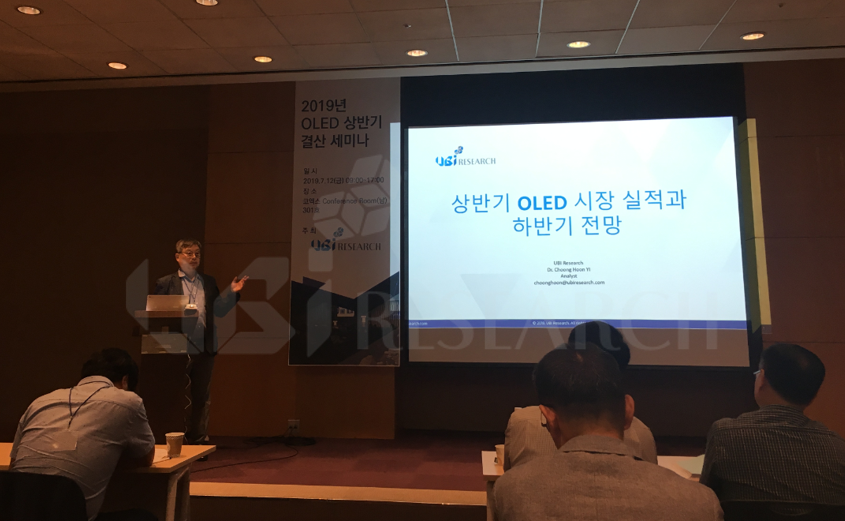
<유비리서치 주관 2019년 OLED 상반기 결산 세미나>
그는 중국의 라인 현황에 대한 점검하면서 “중국 OLED 패널 업체 중 BOE의 경우 예측했던 것보다 6개월에서 1년이상 빠르게 수율 및 가동률이 올라오고 있다” 이어 “중국 시장의 현재 투자된 OLED 6세대 글라스 생산라인만 해도 월 300K 수준이고 계획된 투자까지 합치면 월 400K 가깝다. 삼성디스플레이와 LG디스플레이의 케파 대비 두 배 이상 규모다”라면서 국내 OLED 시장에 대한 위기감을 전했다.
여기에 더해 중국의 경우는 정부지원으로 인한 세율감면과 장비 감가상각이 없으므로 수율이 확보될 경우 상대적으로 원가 및 판가를 더 낮출 수 있는 부분에 대해서도 강조하였다.
이에 따라 6세대 글라스 생산되는 모바일 OLED제품은 2023년에 이후에는 수요에 비하여 공급이 많은 상황이 발생하여 더 이상 6세대 장비 투자가 없을 수도 있다고 내다봤고 수요의 전망치가 좋지 못한 이유는 아직 OLED 패널 판가가 높기 때문이고 원가에 90%이상 차지하고 있는 높은 모듈 부품에 대하여 지적하였다.
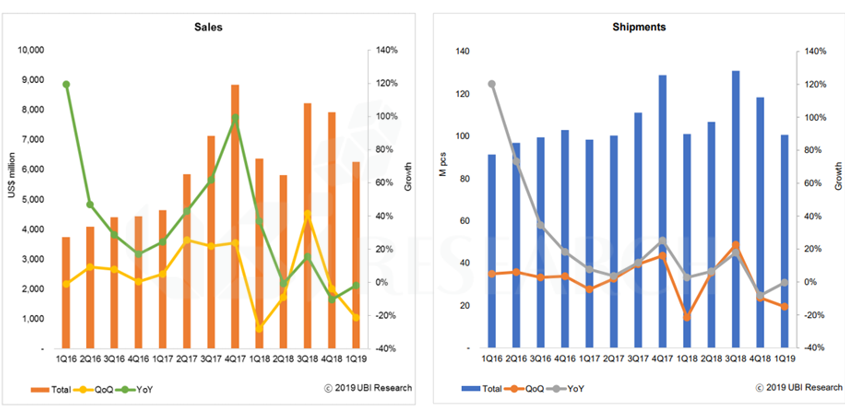
<OLED 패널 판매와 출하량>
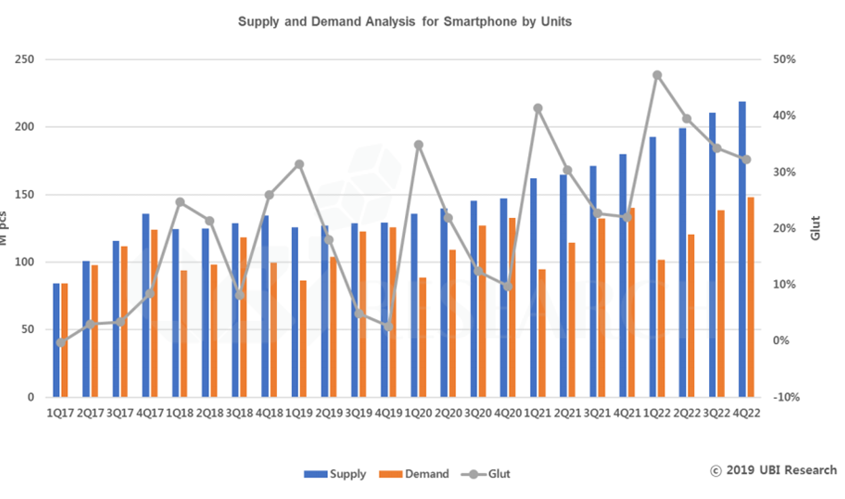
<스마트폰 수요량과 공급량>
TV의 경우는 “최근에 변곡점이 발생한 것으로 보인다”면서 OLED TV 제품 판가가 5월대비 6월에 내려가고 있고 가격이 내려가는 이유에 대하여 높은 패널 판가에 의하여 판매가 저조하고 재고가 쌓여서 가격이 끌려 내려가는 경우에 대해서 우려하였다. 따라서 그는 “OLED TV 패널 단가를 낮춰야 될 상황으로 보이고 경쟁력을 높이기 위해서는 55인치 기준으로 250달러까지 낮아져야 한다”라고 강조하였다.
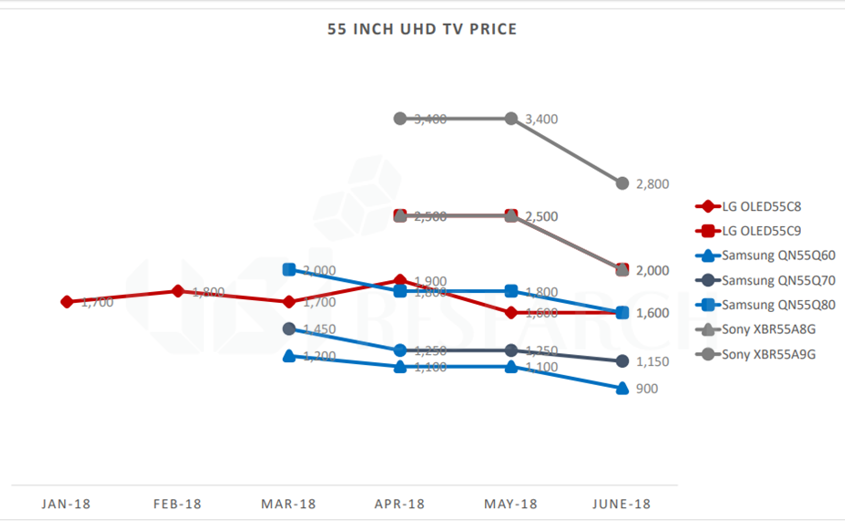
<프리미엄 TV제품 월간 가격변동, Source : bestbuy.com>
마지막으로 OLED 신규 시장 창출을 위해서 모니터와 노트북용 OLED제품 생산에 있어서 Solution process OLED로 접근해야 하는 부분에 대하여도 언급하였다.

시장조사 전문 기관인 유비리서치는 2017년 하반기 결산 세미나 12월 7일(목) 서울 삼성동 코엑스 컨퍼런스룸에서 개최한다. 이번 세미나는 ‘2018년도 디스플레이 산업의 차별화 전략을 위한 시장 전망과 주요 기술 이슈’라는 주제하에 2017년 OLED 시장의 주요 이슈를 되짚어 보고 2018년 시장 전망과 변화 포인트를 예측해보는 자리를 마련한다.
2018년 디스플레이 시장은 국내외 디스플레이 업체에서 앞다투어 제품에 OLED를 채택함으로써 매출액 또한 상승곡선을 그릴 것으로 예상하고 있다. TV용 대형 패널 수요가 빠르게 증가하고 있고, 장기적으로 중소형 패널의 수요도 계속 증가될 것으로 기대되기 때문에 전략적 투자 방향은 긍정적으로 평가된다.
이번 세미나는 ‘최근 LG디스플레이의 중국 8.5세대 투자에 대한 이슈’, ‘삼성 디스플레이의 A5투자가 각 대형디스플레이 패널 시장과 중소형(모바일) OLED패널 시장에 어떤 영향을 미치는지’에 대한 내용으로 신한금융투자 소현철 기업분석부서장이 발표한다.
또한 2018년 가장 주목되는 차세대 Inkjet Printing 기술의 대표 업체 유니젯 김석순 대표가 ‘디스플레이를 위한 잉크젯 프린팅 기술의 개발 역사와 동향’을 발표한다. 스트레쳐블 기술에 핵심 전문가인 고려대학교 홍문표 교수가 현재 기술 개발 상황과 방향에 대하여 심도 있는 발표를 진행한다.
유비리서치 이충훈 대표는 ‘키워드로 돌아보는 2017년 OLED 디스플레이 시장과 2018년 전망’과 ‘중국, 일본 OLED 산업 전망’에 대한 내용으로 2017년을 종합적으로 정리하고 2018년 OLED산업 시장과 기술을 투자 관점, 경제 관점으로 발표한다.
이번 유비리서치 하반기 결산 세미나는 국내 핵심 전문가와 함께 다양한 양질의 정보와 인맥 교류의 장이 형성은 물론 디스플레이 기술의 현황과 미래를 예측할 수 있는 자리가 될 것으로 예상된다. 세미나에 대한 자세한 정보는 공식 홈페이지(http://www.ubiresearch.co.kr/12_sem/)를 통해 찾아볼 수 있다. 또한 사전등록은 12월 6일까지 접수 가능하다.
Samsung Electronics reported sales of KRW 62.05 trillion and operating profit of KRW 14.53 trillion through the conference call of the third quarter in 2017, and the display business recorded sales of KRW 8.28 trillion and operating profit of KRW 0.97 trillion. Display business sales increased 7.4% compared to the previous quarter and 17.3% compared to the previous year, but operating profit of 1 trillion fell with a decrease of 43.3% of the previous quarter and 4.9% the previous year. OLED sales are shown to occupy 60% of the display industry.
According to Samsung Electronics, in the 3rd quarter of 2017, main customers of OLED have increased through the launch of new flagship products focused on flexible products. However, its performance has decreased than the previous quarter due to factors such as increased costs of new OLED lines initial ramp-ups, and intensified price competition between rigid OLEDs and LCD panels.
Samsung Electronics plans to increase supply of flexible products in OLED in the 4th quarter, and expand sales of rigid OLED products to secure profitability. In the LCD industry, there are off-seasons and excess supplies resulting to supply and demand imbalance, but profitability is to be secured by strengthening yield and cost activities and expanding sales portion of high value-added products such as UHD, large-format, and QD.
In 2018, OLEDs are expected to become the mainstream in the mobile display market, with expectations that flexible panel dominance will be particularly strong in the high-end product line. Samsung Electronics said it plans to develop a system to meet the flexible demand of major smartphone manufacturers and improve earnings by securing differentiated technologies.
In 2018, the LCD market may continue to expand in China and intensify competition among companies, but trend of large-sized and high-resolution TVs are expected to continue. Samsung Electronics states it will strengthen its strategic partnership with its customers and concentrate on improving profitability by promoting sales of high value-added products such as UHD, large format, QD, and frameless products.
Samsung Electronics sold 97 million mobile phones and 6 million tablets in the 3rd quarter of 2017. Mobile phone sales in the 4th quarter are expected to decline Quarter on Quarter, but tablet sales are expected to increase QoQ. TV sales reached a record around 10 million units, and sales in the 4th quarter were expected to rise to mid-30%.
10.4 trillion was invested in facility during the 3rd quarter of Samsung Electronics, of which 2.7 trillion was invested in display. Displays are reported to have additional production lines to meet customer demands for flexible OLED panel.
CEO Chang-Hoon Lee of Samsung Display said, “In the case of small and medium-sized OLEDs, we are planning to apply it to AR, VR, foldable, and automotive industry.” Also, “In Automotives, OLEDs are focused on energy efficiency, design differentiation, and black image quality which is critical to driver safety, in preparation with client company cooperation.” Additionally, “Foldable is constantly being researched and developed in line with customer demand, and is centered on enhancing the level of perfection demanded by the market and customers. We will work with our clients to prepare these for mass production desired by our customers.”
삼성전자는 31일 진행된 2017년 3분기 실적 컨퍼런스콜을 통해 매출 62.05조원, 영업이익 14.53조원을 기록했으며, 이 중 디스플레이 사업에서 매출 8.28조원, 영업이익 0.97조원을 기록했다고 밝혔다. 디스플레이 사업 매출은 전분기 대비 7.4%, 전년 동기 대비 17.3% 증가했지만, 영업이익은 1조원대가 무너지며 전분기 대비 43.3%, 전년 동기 대비 4.9% 감소했다. 디스플레이 사업에서 OLED 매출은 60% 후반의 비중을 차지했다고 밝혔다.
삼성전자에 따르면 2017년 3분기에는 OLED 부문에서 주요 고객사의 플래그십 신제품 출시로 flexible 제품을 중심으로 매출이 증가했다. 하지만 신규 OLED 라인 초기 ramp-up에 따른 비용 증가, rigid OLED와 LCD 패널 간의 가격 경쟁 심화 등의 영향으로 전분기 대비 실적이 감소했다고 설명했다. LCD 부문은 주요 고객의 재고 조정 등에 의해 판가 하락 영향으로 실적이 약화되었고 밝혔다.
삼성전자는 4분기 OLED 부문에서 flexible 제품의 생산성을 높여 공급을 본격적으로 확대하고, rigid OLED 제품 판매를 확대해 수익성을 확보할 계획이다. LCD 부문의 경우 계절적 비수기와 업계의 공급 초과 상황이 지속되어 수급 불균형의 우려가 있으나, 수율과 원가 개선 활동을 강화하고, UHD, 대형, QD 등의 고부가 제품 판매 비중을 확대해 수익성 확보에 주력할 방침이라고 밝혔다.
2018년에 OLED는 모바일 디스플레이 시장에서 mainstream이 될 것으로 기대되며, 특히 high-end 제품군에서 flexible 패널의 지배력 강화가 전망된다고 밝혔다. 삼성전자는 주요 스마트폰 업체들의 flexible 수요에 적기 대응할 수 있는 시스템을 구축하고, 차별화된 기술 확보를 통해 실적 개선을 추진할 계획이라고 설명했다.
2018년에 LCD 시장은 중국의 생산량 확대가 지속되고 업체간 경쟁도 심화되지만, TV의 대형화와 고해상도 트렌드 또한 지속될 것으로 전망된다고 밝혔다. 삼성전자는 고객사와의 전략적 파트너십을 견고히 하고, UHD, 대형, QD, frameless 등 고부가 제품과 디자인 차별화 제품의 판매 확대를 추진해 수익성 제고에 집중할 방침이라고 밝혔다.
삼성전자는 2017년 3분기에 휴대폰 9,700만 대, 태블릿 600만 대의 판매량을 기록했다. 4분기 휴대폰 판매량은 전분기 대비 감소할 것으로 예상하지만, 태블릿 판매량은 전분기 대비 증가할 전망이라고 밝혔다. TV의 판매량은 약 1,000만대를 기록했으며, 4분기 판매량은 30% 중반대의 상승을 예상했다.
삼성전자의 3분기 시설 투자는 총 10.4조원이 집행되었고, 이 중 디스플레이에 2.7조원이 투자됐다. 디스플레이의 경우는 flexible OLED 패널 고객 수요에 대응하기 위한 생산라인 증설 투자가 진행중이라고 설명했다.
삼성디스플레이 이창훈 상무는 “중소형 OLED의 경우 현재 주력인 스마트폰 외에도 AR, VR, foldable, automotive 등에 확대 적용할 예정”이라고 설명했다. 이어 “Automotive에서는 OLED가 에너지 효율, 디자인 차별화, 운전자의 안전에 중요한 블랙 화질 구현 등의 장점으로 관심이 집중되고 있어 앞으로 고객사와 협력을 통해 준비하겠다”고 설명했다. 또한, “Foldable은 고객 수요에 맞춰 지속적으로 연구, 개발 중이며 시장과 고객이 원하는 수준의 완성도 제고에 중심을 두고 있다. 고객사와 협력을 통해 고객이 원하는 시점에 양산 가능하도록 준비하겠다”고 덧붙였다.
TADF(Thermally Activated Delayed Fluorescence) 기술은 OLED에 매우 효율적이고 안정적인 emitter 재료를 제공하는 새로운 기술로 알려져 있다. TADF emitter는 OLED 산업의 차세대 재료 발전에 기여하고 더 많은 OLED application을 창출할 수 있을 것으로 기대를 모으고 있다. 현재 TADF는 OLED를 개선할 수 있는 주요 기술로 많은 주목을 받고 있으며, 이러한 TADF 기술의 중요성과 차세대 OLED에서의 TADF 영향력은 독일 프랑크푸르트 국제 TADF 심포지엄에서 강조 될 예정이다. (www.tadf-symposium.com)

IFA 컨퍼런스 직후, 유럽과 한국 대학의 세계 유수 연구원들이 TADF OLED 소재의 개발과 관련 된 모델링부터 분석, 소자 제작에 이르기까지 다양한 측면에서 논의 할 예정이다. 또한, OLED의 선도적인 제조업체인 LG와 Samsung은 OLED 산업의 견해와 고효율 TADF가 어떠한 영향을 미칠 것인지를 발표할 예정이다. 이어서 대표적인 TADF 재료 공급 업체인 CYNORA는 최초의 blue TADF emitter의 상업화 진행 상황과 최종 단계들을 공개 할 예정이다.
국제 TADF 심포지엄은 9월 7일 독일 프랑크푸르트에서 개최되며 등록은 8월 15일 까지 가능하다.
TADF (Thermally Activated Delayed Fluorescence) is an exciting new technology to provide highly efficient and stable emitting materials for OLED devices. TADF emitters are poised to contribute to the next material-driven advancement of the OLED industry, making OLEDs ideal for even more applications. Right now, TADF technology is receiving much attention as it will lead to major improvement of OLED displays again. The importance of TADF technology and its impact of the Next-Generation OLEDs will be highlighted at the International TADF Symposium in Frankfurt, Germany. (www.tadf-symposium.com)

Directly after the well-known IFA conference, the world’s leading researchers from European and Korean universities will discuss aspects related to the development of TADF OLED materials from modelling through synthesis to analytics and device fabrication. In addition, the leading OLED manufactures LG and Samsung will reveal some of their views on the OLED industry and what impact high-efficiency TADF materials will have on it. Furthermore, CYNORA, the leading TADF materials provider, will present an update of its status and its finals steps in commercialization of first blue TADF emitters.
The registration for the International TADF Symposium will be open till 15th August. The TADF event is sponsored by Lesker Tool, Schrödinger and CYNORA.
Meet the leading experts from OLED industry and academia on September 7th in Frankfurt, Germany.
■The OLED equipmentmarket is expected to reach $84.9 billion in 5 years.
■Korean and Chinese panel companies will take over 90% of investment in panel equipment.
According to ‘2017 OLED Manufacturing Equipment Annual Report’ published by UBI Research, the entire equipment market of OLED is expected to total$84.9 billion(about 93trillion KRW) from 2017 to 2021. In 2017, $16.4 billion(about 18 trillion KRW) will be invested in OLED equipment.
The OLED equipment for the market analysis is largely categorized by process into 5 kinds of equipment; TFT, OLED, encapsulation, cell, and module. The investment costs including distribution equipment and test equipment of each process are calculated, and touch-related equipment is excluded from the market analysis.
Hyun Jun Jang, a senior researcher of UBI Research forecasts that the two countries will lead the OLED market due to the massive investment from both Korean panel companies occupying the OLED industry and latecomers Chinese panel companies.
According to this report, China and Korea will actively invest in OLED equipment from 2017 to 2017, showinga 48% and a 42% OLED market share, respectively. In particular, the two countries are expected to make the largest investment of $32.8 billion(about 36 trillion KRW) in 2017 and 2018.
Samsung Display has been expanding small and medium OLED lines to be applied to Galaxy series and Apple, and LG Display has been investing in both small & medium and large-size OLED lines. China’s BOE and CSOT are likely to invest heavily in OLED line because especially BOE has decided to invest more than 30K in small and medium OLED lines every year since 2017.
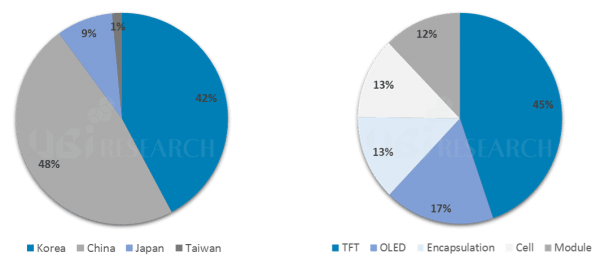
<left) OLED Equipment Market Share by Process, right) OLED Equipment Market Share by Country>
From 2017 to 2021, itis forecast that TFT equipment, OLED pixel patterning equipment, encapsulation equipment, cell equipment, and module equipment will have a 45%, 17%,13%,13%, and 12% market share, respectively. In near future, the demand for flexible OLED will be likely to increase so that cell and module equipment will gain more importance having a 25% market share.
Consumer reports picked OLED TV of LG Electronics as the best 4K TV to buy right now, while gave QLED TV of Samsung Electronics 10th place.
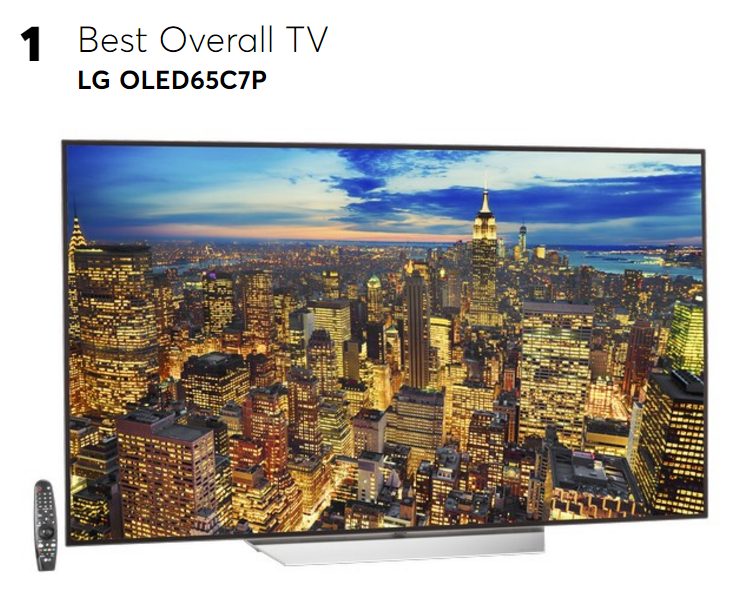
<THE BEST 4K TV LG OLED65C7P selected by Consumer Reports, Source: Consumer reports>
Consumer Reports which is a consumer magazine in US, selected OLED TV OLED65C7P of LG Electronics launched in this year as the ‘Best 4K TVs to Buy Right Now’ on 16th, since ‘OLED TV is the best for expressing black, so it can provide entirely different image quality’.
Consumer Reports evaluated that OLED65C7P has high resolution, excellent image quality and outstanding sound performance. It has the best HDR performance among the products tested this year and it will be hard to find a better TV than it.” Consumer Reports gave 88 points, the highest score ever. This is higher score than 86 points that OLED65G6P of LG Electronics received in November.
In addition, OLED65G6P of OLED TV model in 2016 of LG’s got 86 points and OLED65E6P was followed as 85 points. OLED55E6P and OLED55B6P jointly received 83 points.
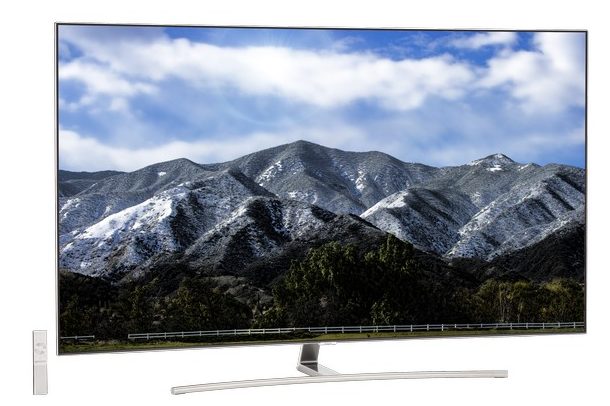
<Samsung Electronics’ QN65Q8C, Source: Consumer Reports>
QLED TV QN65Q8C of Samsung Electronics launched in this year gained 79 points. Consumer Reports explained that it is excellent in resolution, image quality, and sound quality, however there was black mark for the high price in spite of backlighting existence, limit of expression for black due to backlighting and cloud phenomenon. And Consumer Reports quoted the words of industry source that it would take more than three years for launching of true self-emitting QLED TV.
In the ‘Solution process OLED annual report’, UBi research expected that QLED deposition materials have issues on a short life-span compared to phosphorescence OLED deposition materials that are currently being commercialized, efficiency problem, development of eco-friendly devices, lack of infrastructure compared to OLED. In case of not establishing infrastructure and aggressive investment such as manpower recruitment and expansion of the development investment, the time of commercialization will be far from here.
With the joining of Apple in the growing OLED market this year which is manufactured by Samsung Display and applied in Samsung Electronics’ Galaxy, the OLED parts & materials market is increasingly developing.
An OLED specialized research company, UBI Research CEO Choong Hoon Yi(senior analysis) said the various parts & materials market needed for manufacturing smartphone OLED is expected to reach US$ 8.7billion this year and more than quadruple to US$ 38billion in 2021.
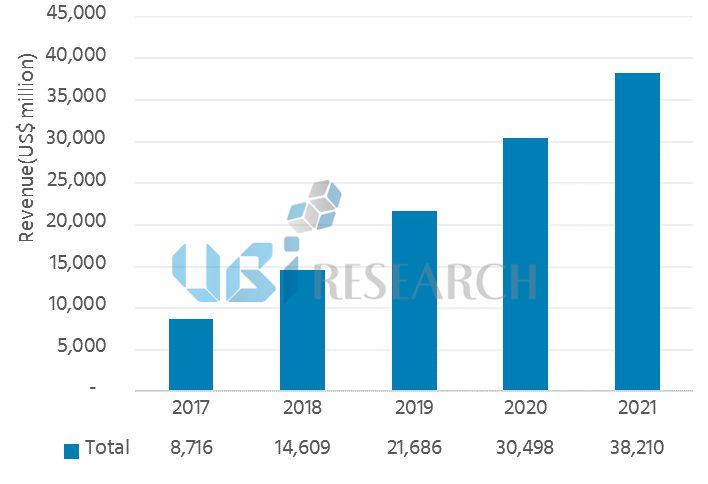
<M2017 Mobile Phone OLED Parts & Materials Report, UBI Research>
The biggest reason for the rapid growth in the smartphone OLED parts & materials market is attributed to the stable success of Samsung’s Galaxy, the Apple’s effect, the Chinese set companies’ demand boom. Just like reflecting this trend, leading display companies such as LG Display, BOE, CSOT, and Visionox following Samsung Display are struggling to introduce the 6th generation flexible OLED manufacturing line. This trend will lead LCD to disappear almost in the smartphone market by 2021.
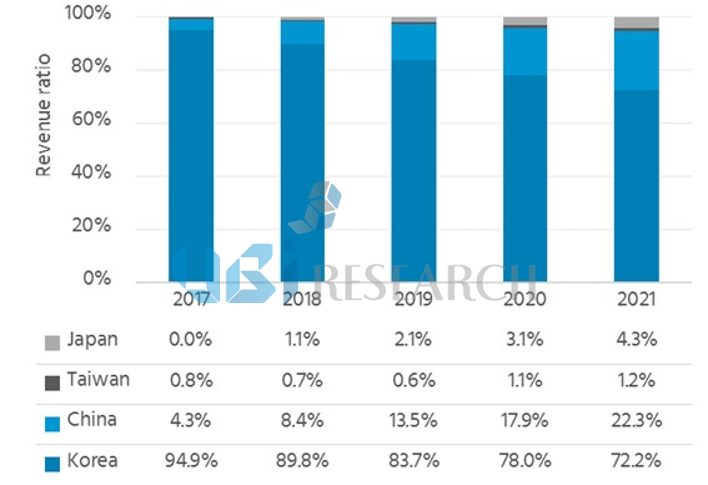
<2017 Mobile Phone OLED Parts & Materials Report, UBI Research>
As the OLED parts & materials market for smartphone is classified by country, the Korean market predominates. The Korean OLED parts & materials market accounts for 95% of the total market and is likely to keep 72% in 2021.
As the OLED industry is led by Samsung Display, the Korean parts & materials market is also expected to rapidly grow. UBI Research CEO Choong Hoon Yi forecasted the ecosystem made by Samsung Display is held by the majority of Korean SMEs or the foreign companies with a factory in Korea, OLED growth will be directly related to the development of Korean SMEs.
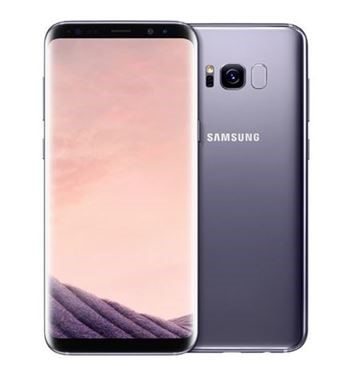
<Samsung Galaxy S8, Source: Samsung Electronics>
Samsung Electronics’ Galaxy S8 and S8 + were unveiled on March 29th (local time) at the UnPacked 2017 event in New York, United States. No doubt Galaxy S8 ans S8+ have received a lot of attention before the event.
Size-wise of the Galaxy S8 is not much different from the previous Galaxy S7. But the Galaxy S8 minimizes the bezel and removes the home button for the wider display. This way, Samsung Electronics meets consumers’ needs, offering stability of using a smart phone with one hand as well as high visibility.
The Infinity Display applies to the Galaxy S8 accounts for 83.6% of smartphones. The size of display has enlarged by 0.7 inches while the display area (the ratio of display to smart phone) has been increased by 11.5%. Additionally, Samsung applied black color and edge shape to bezel, causing an optical illusion with far wider view to consumers as if the entire smartphone solely composes of a display set.
Samsung has also expanded the screen ratio of the Galaxy S8 from 16: 9 to 18.5: 9 to immerse consumers maximally in virtual experience while viewing an image on the screen. In some cases, 16: 9 image contents are produced in 21: 9 (for a wide view) and have been gradually increased. Such contents on the smartphone may cause the users to feel confined and distracted by the top and bottom margin. However, the Infinite display fills the screen with full 21: 9 image contents to further enhance the mesmeric feel.
Resolution of Infinite display has been upgraded from QHD to QHD + as good as the screen ratio; Infinite Display has been certified as the first HDR premium for the first time in mobile devices.
Samsung revealed Galaxy S7 with 72.1% DA in 2016 as well as Galaxy S8 in 2017 with 83.6%, 11.5% increase in DA to the previous year. Samsung Electronics is gradually reaching DA 90% in the future smart phones; Market will pay more attention to the Samsung’s future product development.
Meanwhile, both Galaxy S8 and Galaxy S8 + are equipped with Bixby-intelligent interface, the world first 10 Nano processor, and 4GB RAM; S8 has a 3000mAh battery and S8 + has a 3500mAH battery, with biometrics and multi-window function.
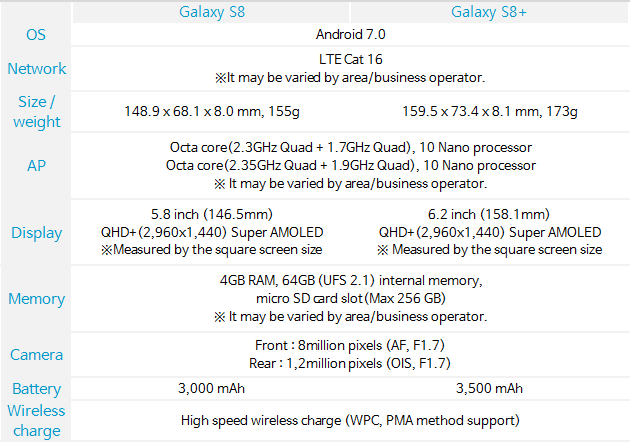
<Specification of Samsung GalaxyS8 and GalaxyS8+, Source: Samsung Electronics>
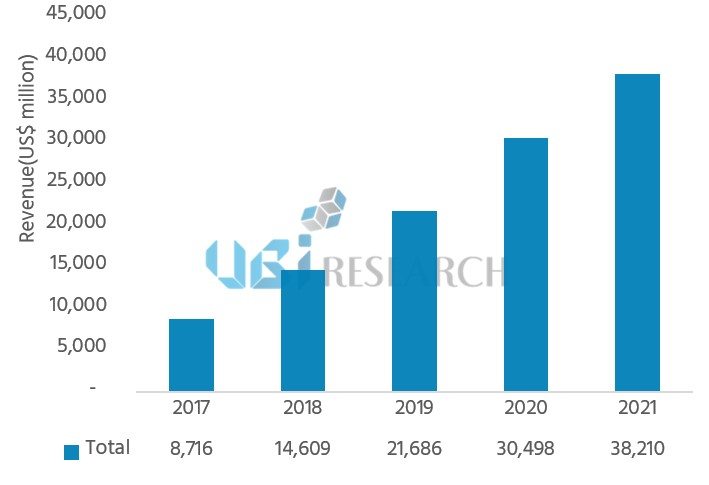 The component and material necessary for manufacturing OLED include not only board but also TFT, OLED, encapsulation, touch screen, cover window, and drive IC.
The component and material necessary for manufacturing OLED include not only board but also TFT, OLED, encapsulation, touch screen, cover window, and drive IC.
With the joining of Apple and Chinese companies into the OLED mobile phones market which has been led by Samsung’s Smartphone Galaxy, Samsung Display and Chinese Display companies are increasing their investment in Gen 6.
Accordingly, component and material market needed for manufacturing OLED is also rapidly expanding.
.
According to the UBI Research report, the OLED component and material market for mobile phones is expected to grow to US$ 38.2 billion in 2021 as against US$ 8.72 billion in 2017.
In terms of nation, the Korean OLED component and material market holds 94.9% market share(US$ 8.27 billion) in 2017, but the Chinese one is forecast to increase up to 22.3% in 2021, whereas the Korean one will decrease to 72.2%.
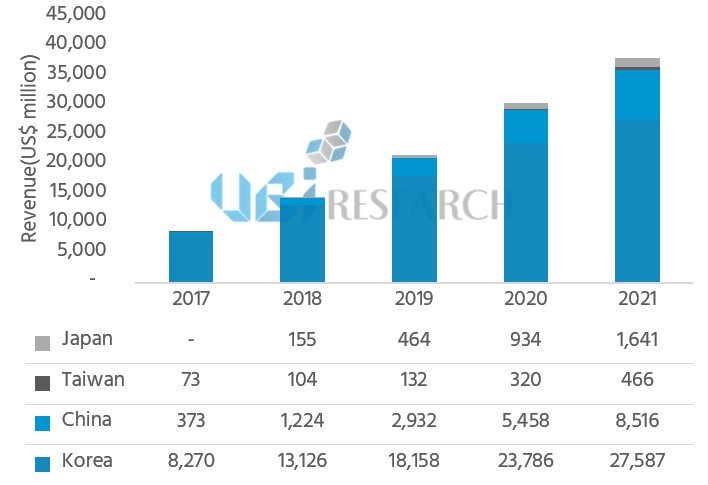
Sony가 올해 초 CES 2017에서 공개한 XBR-A1E OLED TV series의 예약 판매를 실시하면서 Sony와 LG전자, 삼성전자의 본격적인 premium TV 경쟁이 시작되었다. 전작들과 다른 전략으로 책정 된 가격과 경쟁 업체들과 물고 물리는 가격 경쟁이 구매자들의 큰 관심을 이끌고 있다.
Sony가 이번에 공개한 XBR-A1E series는 55인치와 65인치, 77인치 3가지 라인업으로 구성 되었다. 출시 가격은 3월 16일 Amazon 기준으로 55인치는 US$ 4,999.99, 65인치는 US$ 6,499.99, 77인치는 추후 공개예정으로 LCD가 탑재 된 전작 모델들인 XBR-55X850D와 XBR-65X850D의 출시 가격에 비해 약 2배 정도 높게 책정 되었다. 이는 높은 가격대 책정과 함께, 기존보다 향상 된 화질과 OLED 패널이 직접 사운드를 내는 acoustic surface 기술 적용 등, OLED 패널을 적용한 premium TV만의 차별화 된 이미지를 구축하겠다는 전략으로 해석된다. 또한, 지난 2월 공개한 LG전자의 signature OLED TV인 OLED65G7P의 가격보다 US$ 500, OLED65W7P의 가격보다 US$ 1,500 가량 저렴하게 책정되었다. LG전자보다 늦게 출시한 만큼 가격 측면에서 우위를 점하겠다는 의도로 풀이된다.
LG전자도 지난 2월 premium TV 시장을 선점하기 위한 premium OLED TV를 출시하였다. LG전자는 올해 Ultra OLED TV 5개 시리즈 10개 모델(77/65W7, 77/65G7, 65/55E7, 65/55C7, 65/55B7)을 새롭게 출시 할 계획이다. LG전자의 올해 판매모델인 OLED65C7의 출시가격은 Amazon 기준 US$ 4,499.00로 전작 모델인 OLED65C6에 비해 25% 정도 저렴하게 책정 되었으며, 삼성전자의 65Q7C과 비슷한 가격 대이다. 하지만 signature OLED TV인 OLED65G7P와 wall paper OLED TV인 OLED65W7은 삼성전자의 65inch QLED TV중 제일 비싼 QN65Q9F 보다 각각 US$ 1,000와 US$ 2,000 이상 높은 가격을 책정 하였다. 프리미엄 시장에서도 entry와 high-end로 나누어 entry 모델로 삼성전자의 QLED TV와 경쟁하고 가격이 더 비싼 high-end 모델로 새로운 프리미엄 시장을 개척하겠다는 의미로 해석된다.
LG전자, Sony와 달리, QLED TV를 주력으로 하고 있는 삼성전자는 지난 3월 14일 파리에 위치한 루브르 전시장에서 초프리미엄 제품군(Q7,Q8,Q9)을 공개했다. 초프리미엄 제품군은 4개 시리즈 11개 모델(88/75/65Q9F, 75/65/55Q8C, 75/65/55Q7F, 65/55Q7C)로, F와 C는 각각 flat과 curved를 의미하며, Q7과 Q8보다 고급형인 Q9은 4월에 출시 될 예정이다. 출시 가격은 65Q8C는 3월 14일 Best Buy 기준 US$ 4,799.99이며, 65Q9F는 US$ 5,999.99로 책정 됐다. 이는 지난 2016년에 출시 된 premium TV 라인업인 ‘SUHD TV’에 비해 출시가격이 20%이상 높은 가격으로, Sony와 마찬가지로 높은 가격대 책정과 컬러볼륨 100% 인증을 받은 향상 된 화질을 강조하며 premium TV만의 고급스러운 이미지를 구축하려는 의도로 풀이된다.
이처럼 기존 2017년 premium TV 시장은 삼성전자와 LG전자, Sony 3사간의 치열한 경쟁이 다시 한번 예고되고 있다. 프리미엄 TV 시장을 OLED TV로 리드하고 있는 LG전자와 이에 맞선 Sony의 OLED TV 사업 진출, 삼성전자의 QLED TV 마케팅이 2017년 premium TV 시장에 어떤 영향을 미칠지 소비자와 업체 관계자들의 시선이 집중되고 있다.

<삼성전자와 LG전자, Sony의 2017년 프리미엄 TV 가격, Source : Amazon, Best Buy, 2017년 3월 23일 기준>
Some line-ups of Samsung Electronics QLED TVs including the Q7 and Q8 introduced at CES 2017 are starting to be unveiled and preordered on its official U.S website and Amazon. The products for preorder are 55, 65, and 75-inch flat TVs of Q7 line-up, and 55 and 65-inch curved TVs of Q8, the higher lineup than Q7. QN65Q7F 65-inch flat TV cost US$ 3,499.99 on Amazon, as of 16th, and QN65Q8C 65-inch curved TV was US$ 4,499.99. It was 20% more expensive than ‘SUHD TV’, the premium TV line-up launched in 2016, and it was intended to build premium TV’s own image by highlighting high price range and enhanced picture quality.
On the other hand, LG Electronics OLED TV prices keep on decreasing. OLED65C6 65-inch curved OLED TV was launched last year at US$ 3,197.00 on Amazon as of 16th, and that was 50% cheaper than US$ 6,000.00 on June, 2016. In addition, the lunch price of OLED65C7 65 inch-curved OLED TV to sell this year is set as US$ 4,000.00 on Amazon as of 15th, which was a 30% cheaper than 2016 and US$ 500.00 cheaper than Samsung’s QN65Q8C 65 inch curved TV. As LG Electronics are leading the OLED premium TV market, it is likely to pay more attention to popularization due to is low price.
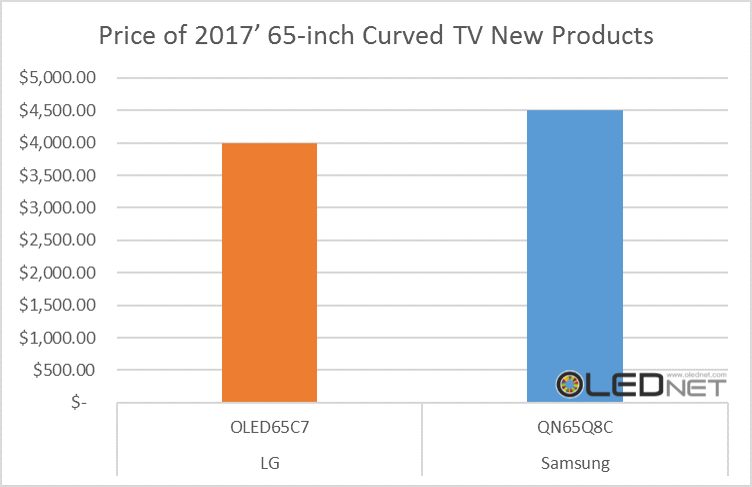
<Price Comparison of 2017’ 65-inch Curved TV New Products, Source : Amazon.com>
Due to similar prices of OLED TV and QLED TV in the premium TV market, high-quality picture, brand image, consumer needs satisfaction are gaining importance. Color reproduction among high-quality picture factors has similar performance, whereas OLED TV still gain a competitive advantage in contrast range and response speed. Besides, Sony that has kept a strong brand power and status in the premium TV market showcased OLED TV with higher-quality picture upgraded by ‘Acoustic Surface’ technology that produces sound without speaker and ‘X1 extreme processor’ HDR chip, attracting a lot of attention at CES 2017. Its release date and price have not yet been announced, but it is expected to greatly influence the premium TV market.
There’s a keen interest on, how the 2017 premium TV market will change due to the different price strategies of premium TVs to be released and Sony’s joining in OLED TV.
삼성전자가 이번 CES 2017에서 선보인 QLED TV의 Q7과 Q8등 일부 라인업에 대해, 삼성전자의 미국법인 공식 홈페이지와 Amazon 등을 통해 공개하고 예약 판매를 실시하고 있다. 예약 판매가 진행중인 제품은 Q7 라인업의 55, 65, 75 inch flat TV와 Q7보다 고급형인 Q8 라인업의 55, 65 inch curved TV이며, 65 inch flat TV인 QN65Q7F는 16일 Amazon 기준 US$ 3,499.99, 65 inch curved TV인 QN65Q8C는 US$ 4,499.99로 조사 됐다. 이는 지난 2016년에 출시 된 premium TV 라인업인 ‘SUHD TV’에 비해 출시가격이 20%이상 높은 가격으로, 높은 가격대 책정과 향상 된 화질을 강조하여 premium TV만의 이미지를 구축하려는 의도로 풀이된다.
이에 반해 LG전자의 OLED TV 가격은 지속적으로 하락하고 있다. 지난해 출시 된 65 inch curved OLED TV인 OLED65C6는 16일 Amazon 기준 US$ 3,197.00로, 2016년 6월 출시가격 이었던 US$ 6,000.00에 비해 50% 정도 저렴한 가격에 팔리고 있다. 또한 올해 판매 모델인 65 inch curved OLED TV인 OLED65C7의 출시가격은 15일 Amazon 기준 US$ 4,000.00로 2016년 출시 제품에 비해 30% 저렴하게 책정 되었으며, 삼성의 65 inch curved TV인 QN65Q8C에 비해 US$ 500.00가 저렴하다. OLED를 적용하여 premium TV 시장을 주도하고 있는 만큼, 낮은 가격대로 대중화에 더 공을 들이고 있는 것으로 추측된다.
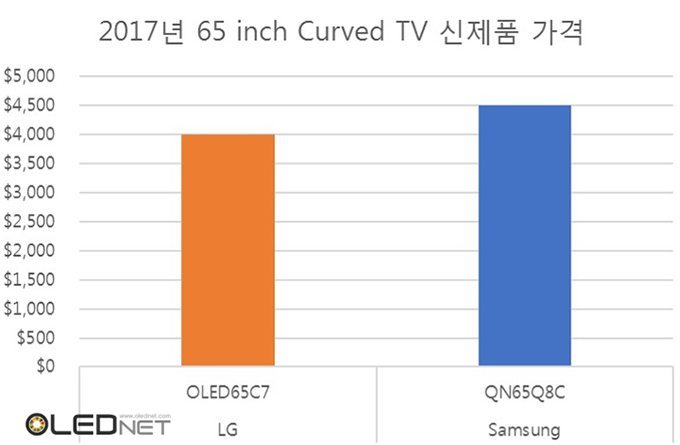
<2017년 65 inch Curved TV 신제품 가격 비교, 출처 : Amazon.com>
이처럼 premium TV 시장에서 OLED TV와 QLED TV의 가격이 점점 엇비슷한 가격대를 형성하고 있기에, 이제는 화질과 브랜드 이미지, 소비자의 needs 충족이 중요한 요소로 떠오르고 있다. 화질에서 색재현율은 서로 비슷한 성능을 보이고 있으나, 명암비와 응답속도 등의 성능에서는 여전히 OLED TV가 우위를 점하고 있다. 또한, 브랜드 파워와 premium TV 시장에서의 여전한 위상을 가지고 있는 Sony가 CES 2017에서 OLED TV를 선보였으며, 스피커 없이 소리를 내는 ‘Acoustic Surface’ 기술과 ‘X1 extreme processor’라는 HDR 칩을 적용하여 OLED TV의 화질을 더욱 더 향상시켜 많은 주목을 받았다. 출시일과 출시가격은 미정이나 premium TV 시장서의 파급력이 클 것으로 예상되고 있다.
2017년 출시 될 premium TV 가격대의 서로 다른 전략과 Sony의 OLED TV 진영 가세로 2017 premium TV 시장이 어떻게 개편될지 많은 이들의 관심이 집중되어 있다.
Super Bowl, the North American professional soccer (NFL) final and one of the World’s biggest sport events, is coming under our noses and LG OLED TV has swept top three places at 5 best TVs for the Super bowl. Also products of LG and Samsung Electronics accounted for the top 10 except for 5th place, showing powerful technology of Korean companies.
LG Electronics’ 65-inch OLED TV, OLED65G6P, was selected as the best TV for the Super Bowl by Consumer Reports in the US in 2017. The consumer report commented excellent screen quality and deep black, built-in sound, and infinite viewing angle- the best in all respects, suppressing Samsung and Sony’s flagship.

<LG Electronics 65inch OLED TV- OLE65G6P, Source : consumerreports.org>
LG OLED65E6P and OLED55B6P ranked 2nd and 3rd place, offering the strengths of OLED TV and reasonable price. LG UHD LCD TV ranked 9th and 10th, listing five LG TVs are in the top 10.
The fourth is Samsung’s quantum dot SUHD TV, UN65KS9800. The consumer report reviewed that it shows high resolution quality and excellent sound, in application of full array LED backlight with local dimming function to produce very deep black levels for an LCD set. Samsung’s other products such as UN55KS9000, UN55KS8000, UN55KS6500 ranked 6, 7 and 8, listing four products in the top 10.
On the other hand, Sony’s XBR-65Z9D was ranked 5th in the top 10, except for Korean makers. The Consumer Report commented, it uses a unique full-array backlight system, called Backlight Master Drive, to turn each LED on or off independently, helping it produce impressive black levels and contrast for an LCD-based set.
The Super Bowl competition is the world’s most popular sport event, with more than 100 million viewers around the world and during the season various marketing events are held- it’s the second most successful TV purchase period in a year, following Black Friday. Such Super Bowl event and positive reviews on OLED TVs are anticipated to be in the competitive position in the premium TV market along with the recent price reduction of OLED TV.
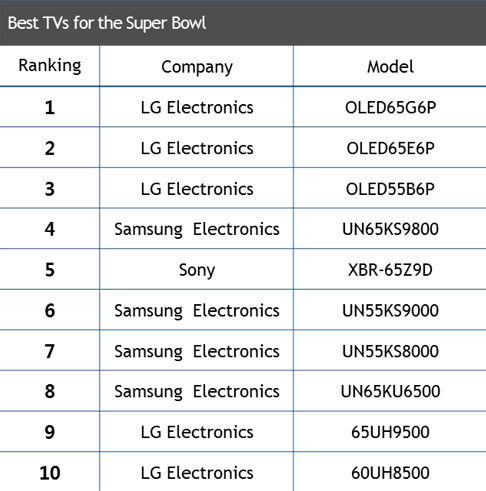
<Best TVs for the Super bowl, Source : consumerreports.org >
지구촌 최대 스포츠 이벤트로 불리는 북미 프로미식축구(NFL) 결승전 `슈퍼볼`이 코앞에 다가온 가운데, 슈퍼볼을 시청하기 좋은 TV TOP5에서 LG전자의 OLED TV가 1위부터 3위까지 모두 휩쓸었다. 또한, LG전자와 삼성전자는 10위권 내에 5위를 제외하고 모두 자사의 제품을 올려 한국기업들의 기술력을 입증하였다.
미국의 컨슈머리포트가 선정한 2017년 슈퍼볼을 시청하기 위한 최고의 TV로 LG전자의 65인치 OLED TV인 OLED65G6P가 선정되었다. 컨슈머리포트는 이 제품에 대해 우수한 화질과 명암비, 뛰어난 내장 사운드, 무한대의 시야각 등 모든 측면에서 최고라는 평가를 내렸으며, 삼성과 Sony의 flagship을 누른 제품이라 소개하였다.

<LG전자의 65인치 OLED TV인 OLE65G6P, 출처 : consumerreports.org>
2위와 3위도 모두 LG전자의 OLED TV인 OLED65E6P와 OLED55B6P가 차지하였다. OLED TV만의 뛰어난 장점들과 함께 합리적인 가격들을 소개하였다. 그 외에도, LG전자의 UHD LCD TV는 9위와 10위에 올라, LG전자는 10위권에 총 5개 제품을 올렸다.
4위는 삼성전자의 퀀텀닷 SUHD TV인 UN65KS9800이 차지하였다. 컨슈머리포트는 고해상도 화질과 뛰어난 사운드를 보여주며, local dimming 기능이 있는 full array LED backlight를 적용하여 블랙 표현 수준이 뛰어나다고 평가했다. 삼성전자의 또 다른 제품인 UN55KS9000, UN55KS8000, UN55KS6500은 각각 6,7,8위에 올라, 삼성전자는 10위권에 총 4개의 제품을 올렸다.
한편, 한국업체의 제품을 제외하고는 유일하게 10위권 내에 Sony의 XBR-65Z9D가 5위에 선정 되었다. 컨슈머리포트는 뛰어난 화질과 함께, Backlight Master Drive라는 특수한 full-array backlight system을 적용하여 우수한 명암비를 표현한다고 소개하였다.
슈퍼볼 경기는 세계 1억명 이상의 시청자가 시청하는 세계 최대 인기 스포츠 이벤트이며, 이 기간 동안 다양한 판촉 행사가 진행되기 때문에, 이 기간이 블랙프라이데이에 이어 연중 두 번째로 좋은 TV 구매시기로 손꼽히고 있다. 이러한 슈퍼볼 이벤트와 OLED TV에 대한 좋은 평가들은 최근 OLED TV의 가격하락과 맞물려 프리미엄 TV 시장에서 LCD TV와의 경쟁에서 유리한 고지를 차지할 것으로 기대를 모으고 있다.

<슈퍼볼을 시청하기 위한 좋은 TV 순위, 출처 : consumerreports.org >
The curved TV introduced firstly in 2013 has attracted attention for a long time, and many companies including Samsung Electronics and China’s Hisense, Haier and TCL showcased curved TVs at CES 2016. In addition, newcomers including Xiaomi and LeTV released curved TVs, and Samsung Electronics organized ‘Curved Federation’ with China’s TV companies such as Hisense and TCL in August, 2016 to cooperate with each other for the expansion of curved market, and the reviews on the curved TV market are generally positive.
But, only a few companies such as Korean and Chinese ones unveiled curved TVs at CES 2017, while other electronics companies in Europe and the US showcased flat TVs only. Meanwhile, LG Electronics said that it plan to release flat TVs only for Q9, a flagship TV model of 2017 but curved TVs for less expensive models Q7 and Q8. With its plan to focus on flat OLED TV in the future, pointing out the downward trend of curved TV market, LG plans to pay more attention to flat OLED TV. Likewise, major TV set companies’ awareness of curved TV started to change. Besides, European electronics company Vestel mentioned the disadvantage of curved TV that is too sensitive to viewing angle, and TV review company Reviewed.com and other review companies offered negative opinions on curved TV. This expects that the position of curved TVs is likely to dwindle in the premium TV market.
Accordingly, the premium TV market will have intense competition for the clear picture quality of flat type TVs, whereas curved TVs are expected to have competition with Chinese companies in a lower level TV market. As many Chinese TV makers have released curved TVs, curved TV in the premium TV market is no longer a competitive point. Therefore, TV set companies need to find a new turning point to catch the eyes of the consumers.
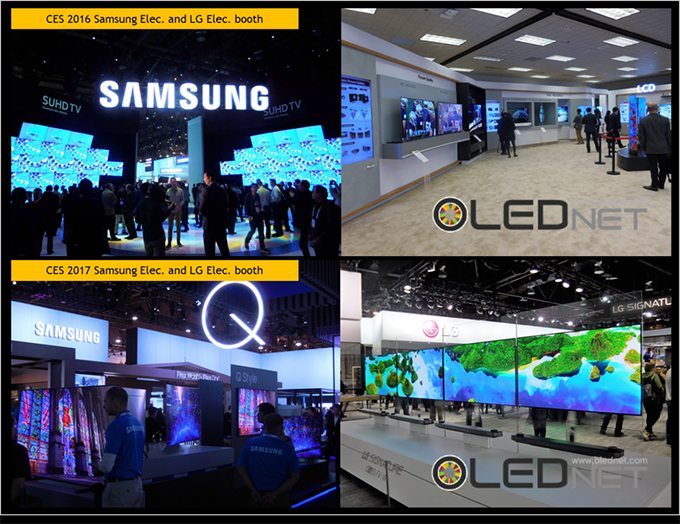
<Booth Photos of Samsung(Left) and LG(Right) at CES 2016 and 2017. Many curved TVs were mainly unveiled in 2016, but flat TVs in 2017>
2013년 처음 선보인 curved TV는 한동안 미래형 TV로 주목 받았으며, CES 2016에서는 삼성전자와 중국의 Hisense, Haier, TCL 등 다수의 업체가 curved TV를 전시하였다. 또한 Xiaomi와 LeTV 등 후발 업체들도 curved TV를 출시하였으며, 삼성전자는 2016년 8월 Hisense와 TCL 등 중국 TV 업체들과 ‘커브드 연맹’을 결성하여 curved 시장의 확대를 위해 상호 협력 하기로 하는 등, curved TV 시장의 평가는 대체적으로 우호적이었다.

<CES 2016과 2017 삼성전자(좌)와 LG전자(우)의 booth 사진. 2016년에는 다수의 curved TV가 전시되었으나, 2017년에는 flat TV 위주로 전시되었다.>
하지만 CES 2017에서는 한국과 중국 등 일부 업체만 curved TV를 선보였으며, 유럽과 미국 등 다른 가전업체들은 flat TV만 전시하였다. 또한, 삼성전자는 2017년 flagship TV 모델인 Q9을 flat TV로만 출시하고 더 저렴한 모델인 Q7과 Q8 모델에만 curved TV 도입을 결정했으며, LG전자 관계자는 curved TV 시장의 하향세를 언급하며 앞으로 flat OLED TV에 집중 할 계획을 언급하는 등, 주요 세트 업체들의 curved TV에 대한 인식이 변화하기 시작하였다. 뿐만 아니라, 유럽의 가전 업체인 Vestel의 관계자는 시야각에 매우 민감한 curved TV의 단점을 언급하기도 했으며, TV 평가 매체인 Reviewed.com과 타 평가 업체에서도 curved TV에 대해 부정적인 의견을 내놓는 등, premium TV 시장에서 curved TV의 입지가 점차 좁아질 것으로 예상 된다.
이에 따라 premium TV 시장은 flat type을 바탕으로 화질 경쟁이 주를 이룰 것으로 보이며, curved TV는 premium급에서 한 단계 낮은 TV 시장에서 중국 업체들과의 경쟁이 예상 된다. 다수의 중국 TV 메이커들의 curved TV 출시로 인해 더 이상 premium TV 시장에서 curved TV는 차별화 포인트가 될 수 없기 때문에, 세트 업체들은 소비자들의 눈길을 사로잡기 위한 새로운 전환점이 필요할 것으로 보인다.
Samsung Electronics announced that they recorded sales of 7.42 trillion won and operating profit of 1.34 trillion won in display business through 4Q 2016 having been progressed on the 24th. This company recorded large scale surplus that exceeded continuous 1 trillion won for two consecutive quarters following last 3Q.
According to Samsung Electronics, this company says that sales has been increased and cost-improving activities were continued through customer diversification in case of 4Q 2016, and also sales volume of OLED panel was increased to a small extent compared to previous quarters. Sales price strength has been continued in demand-supply stability in case of LDC business, and they reveal that business results have been improved indebting to sales increase of high value-added products such as UHD/large size etc. together with yield/cost betterment. In case of TV panel sales, the volume was decreased a little compared to previous quarters from its quantity and areas all together.
Samsung Electronics lights up a business schedule that they will propel growth compared to previous year by expanding exterior supplies of high-end products including Flexible etc. based on technology leadership and securing capacity of Samsung Electronics in 2017 OLED business. They estimate that needs on high value-added Flexible will be greatly expanded according to form-factor innovation of Smartphone.
Besides, they convey their words such like constant increases of China companies’ capacity in LCD business and deepened competition between companies have been made, but they will endeavor to sustain stable profitability through expansion of product sales and design differentiation including Frameless and Curved while strengthening competitiveness of high value-added products including UHD/large size etc.
Samsung Electronics executed 25.5 trillion won in facility investment, and 9.8 trillion won was invested to display business, and also 2017 investment volume of facilities was not fixed yet.
They disclose schedules of propelling sales increase by positively responding to needs of client products according to increasing OLED adaptation by main Smartphone clients in OLED business in the first quarter, and also carry forward performance enhancement through P-Mix efficiency. Though demand decrease of LCD business is estimated owing to entering off-season, tight supply-demand looks to be continued, and they delivers their words like they will devote securing profitability through expanding high value-added product sale and constant boosting of cost competitiveness.
Thus, Samsung Electronics lights up that they will secure profitability by expanding high value-added products such as UHD/ large size/Curved etc.
In 2016 Q4, Samsung Electronics recorded sales of 90 million cellular phones and 8 million tablets, and they forecast that sales of cellular phones will be increased in the first quarter compared to previous quarter, and sales of tablet will be decreased. They explain that sales of LCD TV recorded 16 million TV, and 40% was decreased by influences of seasonal reason in the first quarter, but one-digit growth of early stage is expected annually.
On the other hand, they say that Samsung Electronics does not consider additional disclosure of LCD production line at now while explaining that closure of L7-1 (LCD) line end of last year was not related to Sharp as a matter of willing to do OLED switch before supply stop of Sharp according to Samsung Electronics. In relation with OLED capability, they deliver policy of willing to secure it according to market and customer needs.
삼성전자는 24일 진행된 2016년 4분기 실적 컨퍼런스콜을 통해 디스플레이 사업에서 매출 7조4,200억원, 영업이익 1조3,400억원을 기록했다고 밝혔다. 지난 3분기에 이어 2분기 연속 1조원이 넘는 대규모 흑자를 기록한 것이다.
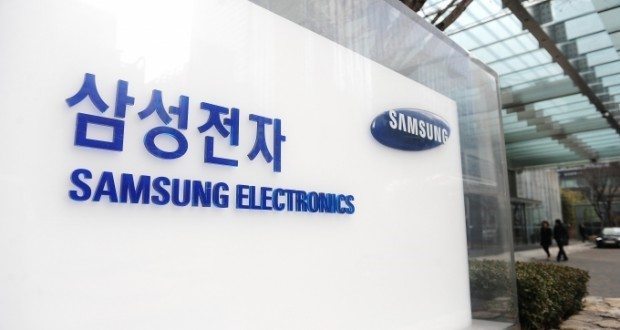
삼성전자에 따르면 2016년 4분기 OLED 사업의 경우 고객 다변화를 통한 판매량 증가와 원가 개선 활동이 지속되었고, OLED panel 판매량은 전 분기 대비 소폭 증가하였다고 밝혔다. LCD 사업의 경우 수급 안정 속에 판가 강세가 지속되었으며, 수율/원가 개선 및 UHD/대형 등 고부가 제품의 판매증가로 실적이 개선되었다고 전했다. TV panel 판매량의 경우 수량과 면적 기준 모두 전 분기 대비 소폭 감소하였다.
삼성전자는 2017년에 OLED 사업에서 삼성전자의 기술 리더십 및 적기 capa 확보를 바탕으로 flexible 등 하이엔드 제품의 외부 공급을 확대하여 전년 대비 성장을 추진할 것으로 밝혔다. 스마트폰의 form-factor 혁신 등에 따른 고부가 flexible의 수요가 크게 확대될 것으로 전망했다. 또한, LCD 사업은 중국 업체 capa의 지속적인 증가와 업체 간 경쟁 심화가 되고 있지만, UHD/대형 등의 고부가 제품 경쟁력을 더욱 강화하고, frameless, curved 등 디자인 차별화로 제품 판매 확대를 통한 안정적인 수익성 유지에 힘쓸 것이라고 전했다.
삼성전자는 2016년 시설 투자에 25.5조원을 집행했는데 디스플레이 사업에 9.8조원이 집행되었으며, 2017년 시설 투자 규모는 아직 확정되지 않았다고 전했다.
삼성전자는 1분기에 OLED 사업에서 주요 스마트폰 고객사들의 OLED 채용이 증가됨에 따라 거래선 제품 수요에 적극 대응하여 판매량 증가를 추진하고, P-Mix 효율화를 통한 실적 향상을 추진할 것이라고 밝혔다. LCD 사업은 비수기 진입에 의한 수요 감소가 예상되지만 타이트한 수급이 지속될 것으로 보이며, 고부가 제품 판매 확대와 원가 경쟁력 지속 제고를 통한 수익성 확보에 주력할 것이라고 전했다.
이에 삼성전자는 수율 및 원가 개선 활동을 강화하고, UHD/대형/curved 등의 고부가 제품 판매를 확대하여 수익성을 확보할 것이라고 밝혔다.
삼성전자는 2016년 4분기에 휴대폰 9,000만대, 태블릿 800만대의 판매량을 기록했으며, 1분기에 휴대폰 판매량은 전 분기 대비 증가하고, 태블릿 판매량은 감소할 것으로 내다봤다. LCD TV의 판매량은 1,600만대를 기록, 1분기에는 계절성의 영향으로 40% 감소하고, 연간으로는 한 자리 수 초반대의 성장이 예상된다고 밝혔다.
한편, 삼성전자에 따르면 지난해 말 L7-1(LCD) 라인의 폐쇄는 샤프의 공급 중단 이전에 OLED 전환을 위해 결정된 사안으로 샤프와 관련이 없으며, 현재 보유 중인 LCD 생산 라인의 추가 폐쇄는 고려하고 있지 않다고 밝혔다. OLED capa와 관련해서는 시장과 고객 니즈에 따라 적기에 확보한다는 방침이라고 전했다.
Modern people who are exposed to electronic devices such as smart phones, PCs, TVs, and monitors can cause fatigue and dry eye syndrome by blue light which might damage the retina or lens in severe case. It may especially disturb a restful sleep by affecting melatonin negatively which is the secretion of sleep-inducing hormone.
Samsung Display has introduced the strength points of self-emitting AMOLED on the blog that can block the harmful blue light by emitting nearby safe wavelength to keep the color and reduce the emission of 425-455mm area in harmful wavelength. They have acquisitioned the industry’s first “Safety for Eyes” certification regarding on the excellence of eye’s health in the photobiological stability test conducted by German certification institute, VDE (Verband Deutscher Elektrotrchniker e.v) in 2016.
They have also represented various advantages that offer excellent color reproduction ratio of 100% against LCD showing 74% level of DCI-P3 standard, thinner thickness than half and low power consumption compared to LCD. They promoted variety merits of eco-friendly AMOLED only for user’s eye health (e.g., ‘Vision Aid’ checks itself the degree of deficiency of cone cell for color blind people and adjusts intentionally the insufficient color stronger for them to look well) as well as the performance including image quality by using blog.
Meanwhile, Samsung Display showed a Bio blue panel applied pixel structure with deep blue sub-pixel and light blue sub-pixel in SID 2016 and IMID 2016. Deep blue and light blue are applied to prevent the degradation of color expressiveness of AMOLED panels that are replaced by light blue only and sharply reduced the gravity of blue light on AMOLED to 12.8%, half of the 25.1% of LCD.
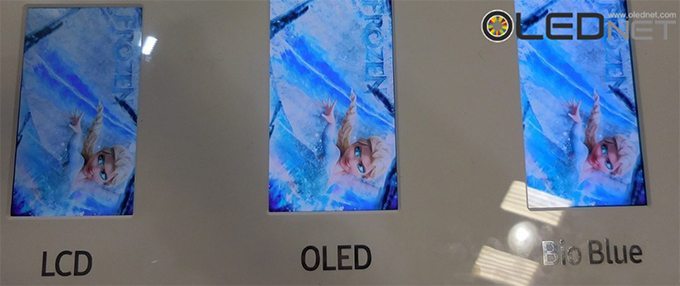
<Bio Blue OLED Panel of Samsung Display, SID 2016>
Smart phone과 PC, TV등, 장시간 모니터와 smart phone 기기와 같은 전자 기기에 노출되는 시간이 많은 현대인은 blue light에 의해 피로와 안구건조증을 유발하여, 심한 경우 망막이나 수정체에 손상을 가져 올 수 있으며 특히, 멜라토닌(melatonin) 이라는 수면 유도 호르몬 분비에 영향을 주어 수면에 방해가 되기도 한다.
Samsung Display는 블로그를 통해, 유해 파장인 415~455㎚부분의 발광을 줄이고, 근처의 안전한 파장을 발광 시켜 색감은 유지하면서도 유해한 blue light는 차단할 수 있는 자발광 AMOLED의 장점들을 소개하였다. 이러한 눈 건강에 대한 우수성으로, 2016년 독일의 인증기관인 VDE(Verband Deutscher Elektrotrchniker e.v)가 진행한 광 생물학적 안정성 검사에서 ‘Safety for Eyes’ 인증을 업계 최초로 획득 하였다.
또한, DCI-P3 기준에서 74% 수준을 표현하는 LCD에 비해 100%의 뛰어난 색재현율과 LCD 대비절반 이상의 얇은 두께, 낮은 소비 전력 등 다양한 장점들을 소개하였으며, 색약자들을 위해 원추세포의 기능저하 정도를 스스로 체크하여 부족하게 감지되는 색을 의도적으로 강하게 보이도록 보정하는 ‘Vision Aid’을 선보이는 등, 화질을 포함한 성능 뿐만 아니라 사용자들의 눈 건강을 위한 친인간적인 AMOLED만의 다양한 장점들을 블로그를 통해 홍보하였다.
한편, Samsung Display는 deep blue sub-pixel과 light blue sub-pixel이 적용된 pixel 구조를 적용한 Bioblue panel을 SID 2016과 IMID 2016에서 선보였다. Deep blue와 light blue를 적용하여 light blue만으로 대체되는 AMOLED 패널의 색표현력 저하를 방지하였으며, AMOLED의 blue light 비중을 LCD의 25.1% 대비 절반 수준인 12.8%로 대폭 감소시켰다.

Full-screen display smartphone is expected to be launched soon. According to the recent report ‘Key Issue and The Market Analysis for Foldable OLED – Flexible OLED Annual Report’ by UBI RESEARCH, a market survey company, left-right bezel-less flexible OLED dominate the smartphone market, and later full-screen display with minimized or without both left-right and up-down bezel will appear in 2017, thereby leading the future market.
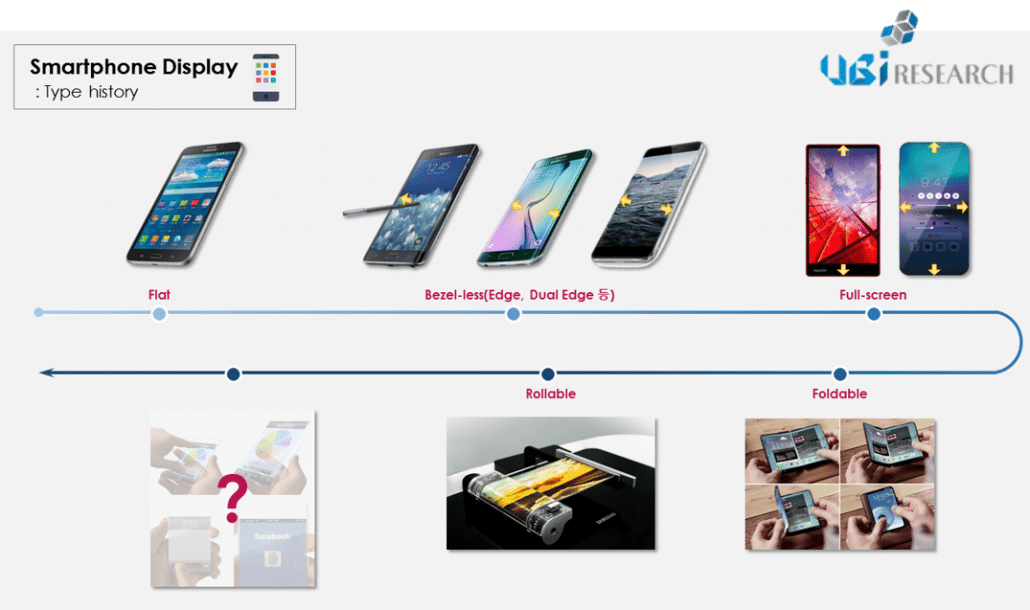
<Smartphone Display Development Trend Outlook>(Source: UBI RESEARCH)
The more specific circumstances were caught. Apple Insider announced that Apple recently applied for a design patent(US20150303244A1) of electronic devices with display-integrated light sensors, quoting the USPTO’s announcement on October 11(Local Time).
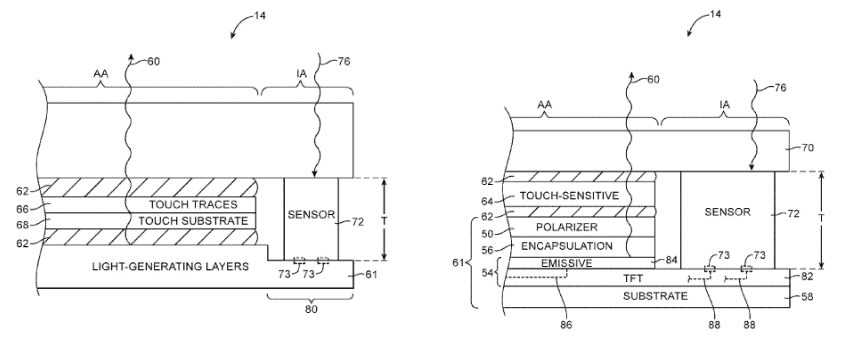
<Design Drawing 1 of Apple’s Patent-Pending Electronic Devices with Display-Integrated Light Sensors>
Apple used the examples of the placement of Ambient Light Sensor or Proximity Sensor around the side of display, and of the protection of display and sensor circuit by glass or plastic transparent encapsulation layer. Apple Insider expects that this design will be able to reduce unnecessary space and make full-screen display possible.
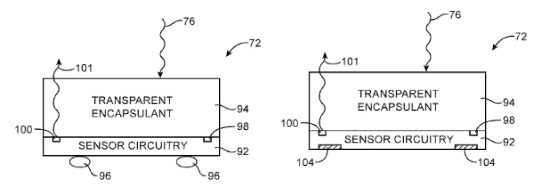
<Design Drawing 2 of Apple’s Patent-Pending Electronic Devices with Display-Integrated Light Sensors>
At the 2016 IMID Business Forum at COEX in Samseong-dong on October 26, Samsung Display chief expert, Park Won-sang announced display trend about screen size, which boosted confidence. Chief expert, Park Won-sang said that “Display size compared to set size is very important due to the characteristic of mobile phones with a size limit. The display area(hereinafter “D.A”) of edge display was 80%, full-screen mobile phone D.A was larger than 90%, and this is one of the major trends that will lead the market”. The techniques including an all-in-one glass fingerprint recognition module and an ultrasonic fingerprint recognition module have not been mentioned yet, but an entirely innovative full-screen smartphone will be introduced by removing left-right bezel as well going beyond the left-right bezel-less type of Note 7.
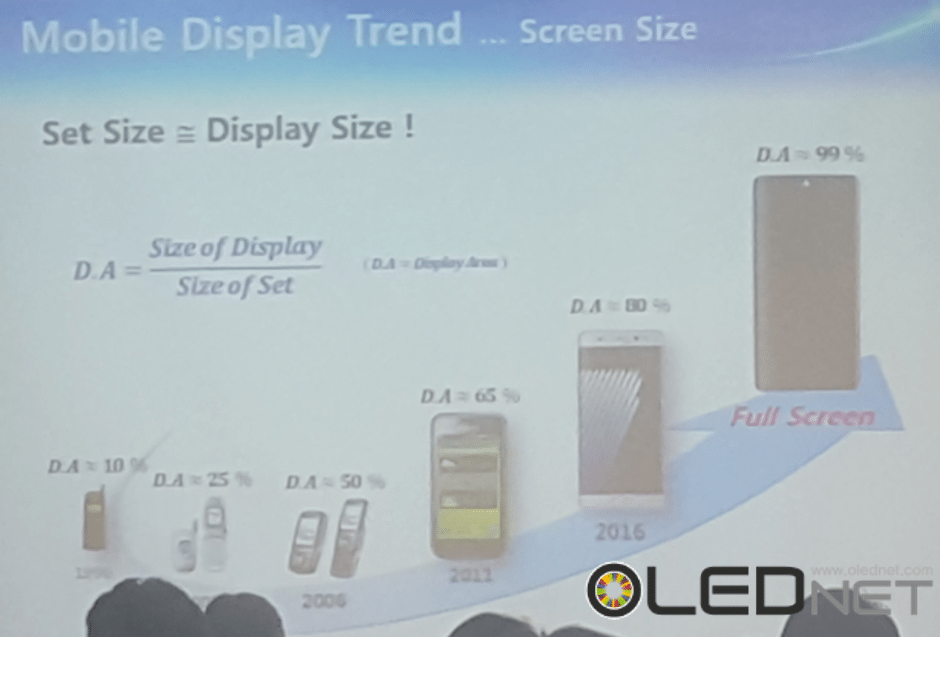
<Samsung Display’s Presentation, 2016 IMID Business Forum>
LG also applied a patent of full-screen display. According to Patently Mobile’s report on June 2015, not physical but virtual button and App icon were applied. But, design itself cannot exactly show materials and interior parts except appearance, and it is now uncertain whether it will be developed or not as there is no further news after the patent application.
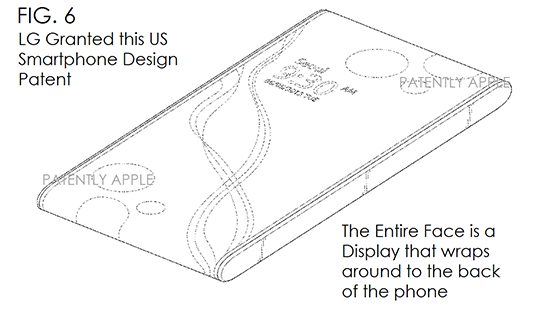
<LG Electronics Granted Home-Buttonless Smartphone using Flexible Display>>(Source : Patently Apple)
Likewise, many smartphone companies are actively reviewing the introduction of full-screen display because it might allow customers to experience the biggest change in addition to the product’s immersive nature. Besides, there are recently some opinions that with the expanding VR market, OLED display without a latency issue and wider display area are necessary to be applied to HMD(Head Mounted Display) attached with a mobile phone.
Meanwhile, ‘Key issue and Market Analysis for Foldable OLED’ Report by UBI RESEARCH forecasted that full screen AMOLED panel will be firstly launched in 2017, accounting for 60% of the total flexible AMOLED panel market and going beyond the bezel-less type of flexible AMOLED panel market.
Meanwhile, ‘Key issue and Market Analysis for Foldable OLED’ Report by UBI RESEARCH forecasted that full screen AMOLED panel will be firstly launched in 2017, accounting for 60% of the total flexible AMOLED panel market and going beyond the bezel-less type of flexible AMOLED panel market.
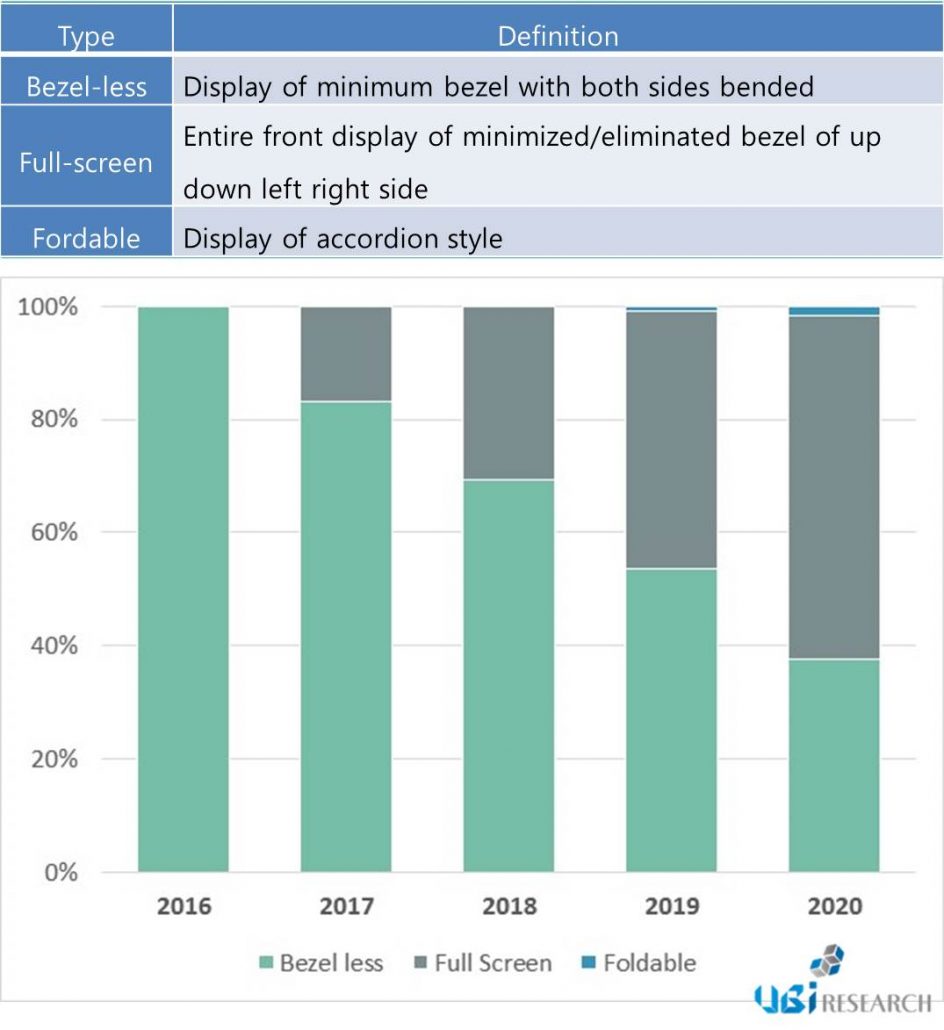
<Definition by Flexible OLED Type and Market Share Outlook >(Source: UBI RESEARCH)
Korea VR festival 2016 (below “KVRF2016”) which can confirm present and future of virtual reality (VR) and augmented reality (AR) industry was opened from October 6 to October 9 at Nuridream Square of Sangam DMC.
In this event, 79 companies including global enterprises such as Samsung Electronics, Sangwha Planning, Oculus, Sony Co., etc. participated in, and new technology of each company was able to be checked on because approximately 157 booths were prepared in common production center, outdoor center, and business center.
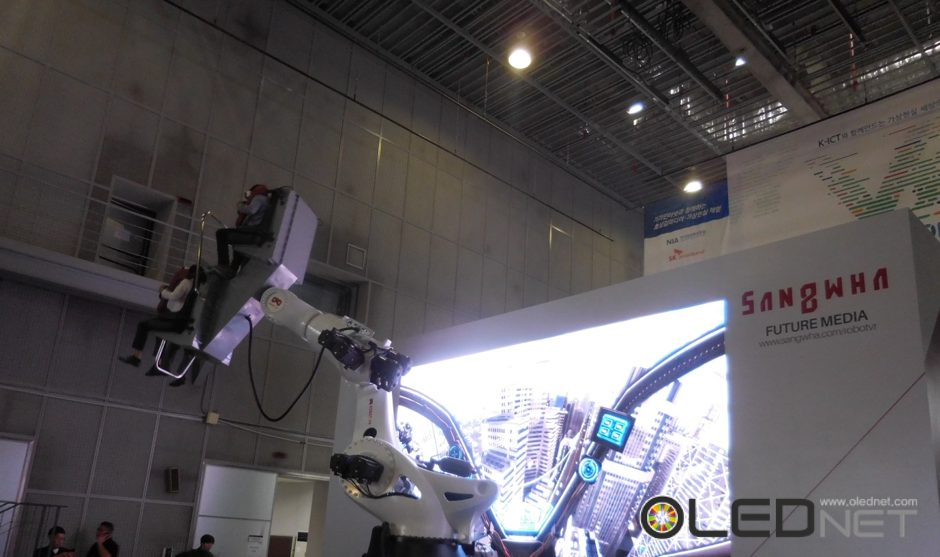
<VR Simulator using a huge robot arm of Sangwha Planning>
While interests in VR and AR are enlarged due to recent Poke’mon GO, many spectators visited this place with keen attention, each company shows off various interactive-typed contents such as roller coaster, paragliding, Sokkuram experiencing etc as well as game contents including FPS, sky jump etc accordingly. .Besides, this event did not simply limited to games such like Eye-tracking linked with cognitive concentration training system was displayed by BIOTECH, and VR goggles for military simulation by P&C Solution, and also demonstrated a fact that VR industry could be multiply applied to whole fields such as education, health, army etc.
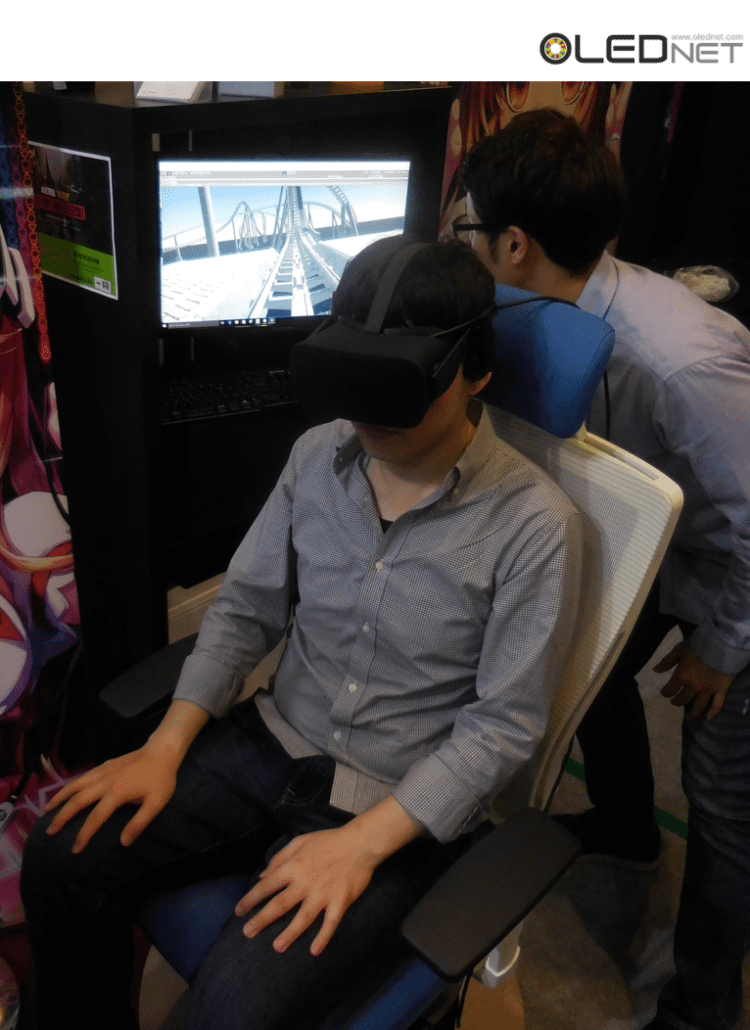
<VR 4D Simulator for Roller Coaster experiencing by MGAME Corp.>
One of interesting thing during observation was that AMOLED panel was used to majority expensive HMD (Head Mounted Display) devices. From Sony Playstation VR whose release is scheduled on 13th to Samsung Gear VR and Nibiru, a Chinese enterprise among Chinese companies, applied Samsung AMOLED. According to common opinions of company officials, they clarified AMOLED application due to issues relevant to response speed called Latency, even though there were BLU (Back Light Unit) and contrast problems which belonged to fundamental matters of LCD.. Latency indicates delaying time owing to inter-computer connections in on-line games frequently, but the reason is derived from limitations of implementing occurred delaying speed with LCD whenever moving user’s eyes, even though visual reality should quickly invoke new images too according to movement of user’s head in VR. No matter how the product has excellent computing power, AMOLED application is essential to make the delaying time shown in the screen to ‘0.’
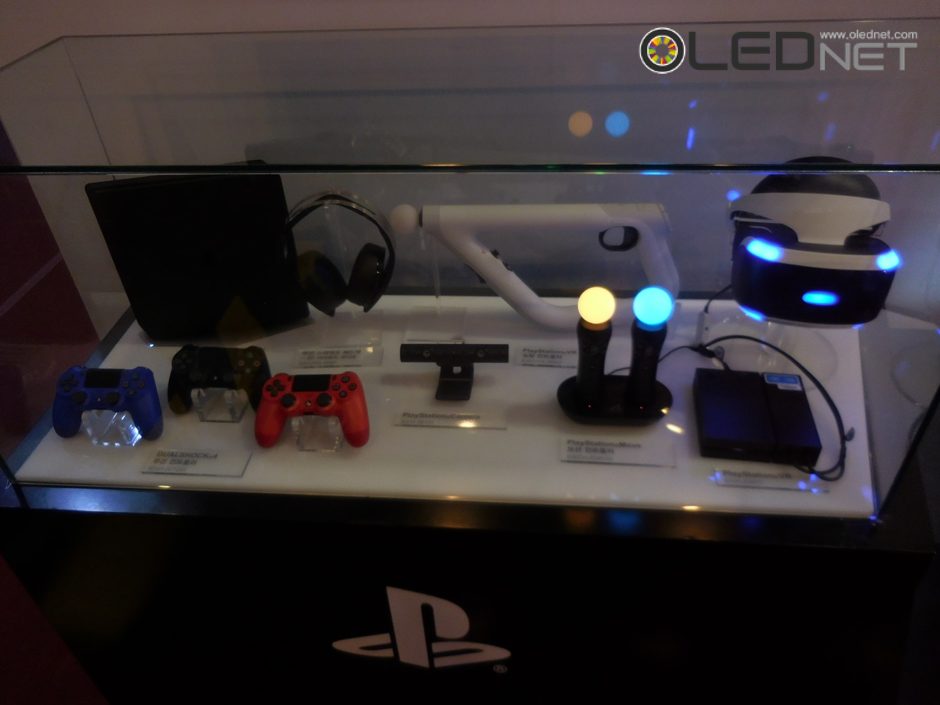
<VR product series of Playstation whose release are planned soon>
Interests in VR have been heightened such like a lot of enterprises and business start-ups in the exhibition hall were boasting their VR technology and VR café was opened in Gangnam, Korea first etc., but there was a realistic saying that even profit model could not be set up properly because related regulations on VR were vague yet and standardization in domestic was not clear as well. Business models and VR industry participation by enterprises become to be different according to legal regulations, so government should provide suitable assistance and methods to make systematic profit platform so that VR industry could strengthen global competitiveness.
가상현실(VR)과 증강현실(AR) 산업의 현재와 미래를 확인 할 수 있는 코리아 VR 페스티벌 2016(이하 KVRF2016)이 10월 6일부터 9일까지 상암 DMC 누리꿈스퀘어에서 개최되었다.
이번 행사에는 삼성전자, 상화기획, 오큘러스, 소니 등의 글로벌 기업들을 비롯해 79개 기업이 참가하였으며, 공동제작센터와 야외센터, 비즈니스 센터 등에 약 157개 부스가 마련되어 각 업체의 새로운 기술을 확인할 수 있었다.

<상화기획의 거대 로봇팔을 이용한 VR 시뮬레이터>
최근 포켓몬GO로 인해 VR과 AR에 대한 관심이 증가하면서 많은 관람객들이 관심을 갖고 방문하였으며, 각 기업들은 그에 맞게 FPS나 스키 점프 등의 게임 컨텐츠를 비롯하여 롤러코스터와 페러글라이딩, 석굴암 체험 등의 다양한 체감형 컨텐츠를 선보였다. 뿐만 아니라, BIOTECH에서는 Eye-tracking 연동형 인지 집중력 훈련 시스템을 선보였으며, P&C Solution에서는 군시뮬레이터용 VR 고글을 선보이는 등, 단순히 게임에만 국한 되지 않고 교육이나 건강, 군 분야 등 전 분야에 걸쳐 다양하게 적용 될 수 있다는 것을 보여주었다.

<엠게임의 롤러코스터 체험용 VR 4D Simulator 제품>
페스티벌을 돌아다니면서 한가지 흥미로웠던 점은 대다수의 고가형 HMD(Head Mounted Display)기기에는 AMOLED panel이 쓰였다는 것이다. 13일 출시 예정인 소니의 Sony Playstation VR부터 Samsung Gear VR, 그리고 중국 업체 중 Nibiru라는 업체에서도 Samsung의 AMOLED 제품을 적용하였다. 업체 관계자들의 공통적인 의견에 따르면, LCD의 본질적 문제인 BLU(Back Light Unit)와 명암비 이슈도 있지만, Latency라고 하는 반응속도와 관련 된 이슈로 인해 AMOLED를 적용한다고 밝혔다. 흔히 Latency는 온라인 게임에서 컴퓨터와 컴퓨터 간의 연결로 인한 지연시간을 말하지만, VR에서는 유저의 머리움직임에 따라 가상 현실 역시 새로운 이미지를 빠르게 불러와야 하는데, 이 시선을 옮길 때 마다 발생하는 지연속도를 LCD로 구현하기에는 무리가 있기 때문이라고 한다. 아무리 연산능력이 좋은 제품이라도 screen에서 보여지는 지연시간을 ‘0’에 가깝게 하기 위해서는 AMOLED 적용이 필수적인 것이다.

<곧 출시 예정인 Playstation의 VR 제품들>
이렇게 전시장 내 많은 기업과 스타트업 업체가 자사의 VR 기술력을 뽐내고 강남에서는 국내 최초로 VR 카페가 생기는 등 VR에 대한 관심이 점점 고조되고 있지만, 국내에서는 아직 VR 관련 규제가 애매하고 표준 역시 명확하지 않아 수익 모델조차 제대로 설정 할 수 없다는 현실적인 얘기도 들을 수 있었다. 법 규제에 따라 비즈니스 모델이 달라지고 업체들의 VR 산업 참여 역시 달라지기 때문에, 정부에서는 VR 산업의 글로벌 경쟁력 강화를 위해서는 체계적인 수익 플랫폼을 마련하기 위한 적절한 지원과 방안을 제공해야 할 것이다.
Currently in the market of premium TV, OLED TV and QD- LCD industries are highly competitive.
QD vision with Nanosis and SID 2016 and IFA 2016 also emphasized quality of TV with QD material included comparing quality of OLED TV. Against this, LG Display joined the completion by emphasizing quality of OLED TV as an ideal display for HDR with comparison between QD-LCD and OLED in IFA 2016 with from SID 2016,
In current large surfaced TV market, LCD TV is taking overwhelmingly large share in distributed market while OLED TV gradually is growing large share in premium market.
In looking into strategies of each industry, large surfaced OLED is developing solution process OLED in order to achieve broader market share with from premium model to distributed model. To overcome weakness compared to OLED, LCD TV industry progressively use QD material with the final goal of development of QLED technology
As a competition in premium TV market gradually extends to entire area of TV market, present condition and possibility of market entry with solution process OLED and QLED is one of major interest.
For this matter, there is seminar host by Ubi Industrial Research with the theme of “analysis in possibility of market entry with QLED and Solution process OLED” in Medium sized business center, Yeouido, October 14th and will be discussing present market industry of large surfaced TV and panel and also will be dealing with present condition and issue of QLED and Solution process OLED, and future possibility of market entry.
Choong-Hoon Lee, president of Ubi Industrial Research, will suggest future direction of OLED industry with analysis of present condition and possibility of market entry in OLED and QLED.
Sung-Jin Jung, head of department of Du Pont, will be discussing the timing of market entry of solution process OLED with the demonstration of soluble OLED material, the essential part of solution process OLED, including present trend and up to date developmental technique
Professor Chang-Hee Lee and senior researcher Ji-won Bang from Korean Institute of Ceramic Engineering and Technology(KICET) will be discussing about advantage and developmental issue of Quantum dot material and direction of future development.
The seminar attracts attention in terms of providing an opportunity to share and discuss regarding issue through media and exhibition with technological and market perspectives of Ubi Industrial Research and share opinions and future possibility.
For registration and any inquiry, please contact to Hana Oh (hanaoh@ubiresearch.co.kr, 02 577 4940) from Ubi Industrial Research.
In OLED Summit 2016 being held in San Diego, USA, LG Display compared similar level of highest model 65-inch LG UHD OLED TV and 65-inch Curved QD-LCD TV, which it attracted many participants’ attention.
The specification of comparing models are as follow.
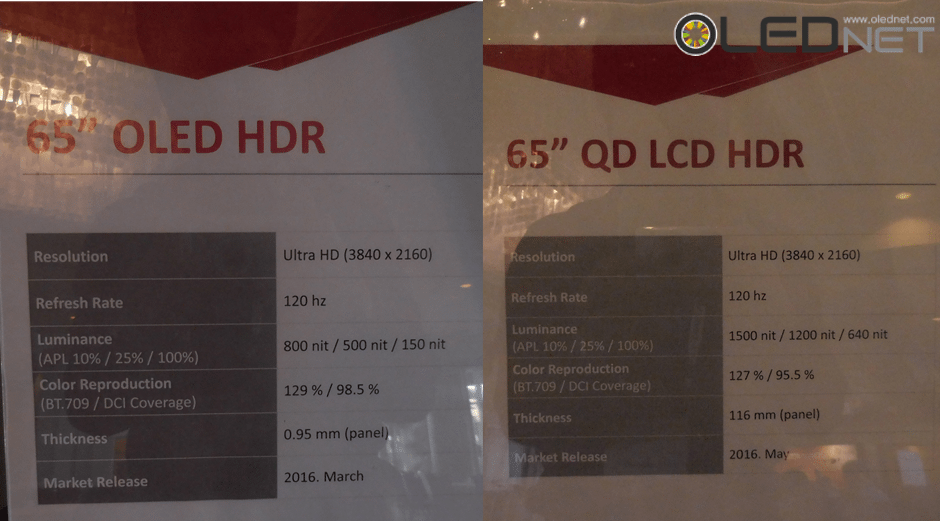
It presented in a way to compare various picture qualities of OLED TV and QD-LCD TV through various films and patterns such as normal TV program and movies.
LG Display personnel said, “OLED TV absolutely expresses black better than QD-LCD TV if OLED TV and QD-LCD TV set the mode that expresses white color 6500K which is the standard of UHD Alliance. Basically, the brightness of QD LCD TV is higher than OLED TV, but because the basis is LCD, it feels more distortion because of more white tone compared to the color of OLED TV. Also, OLED TV can almost express without distortion even in viewing angle, but the color is distorted in QD-LCD”, emphasizing better quality of OLED TV than QD-LCD TV.
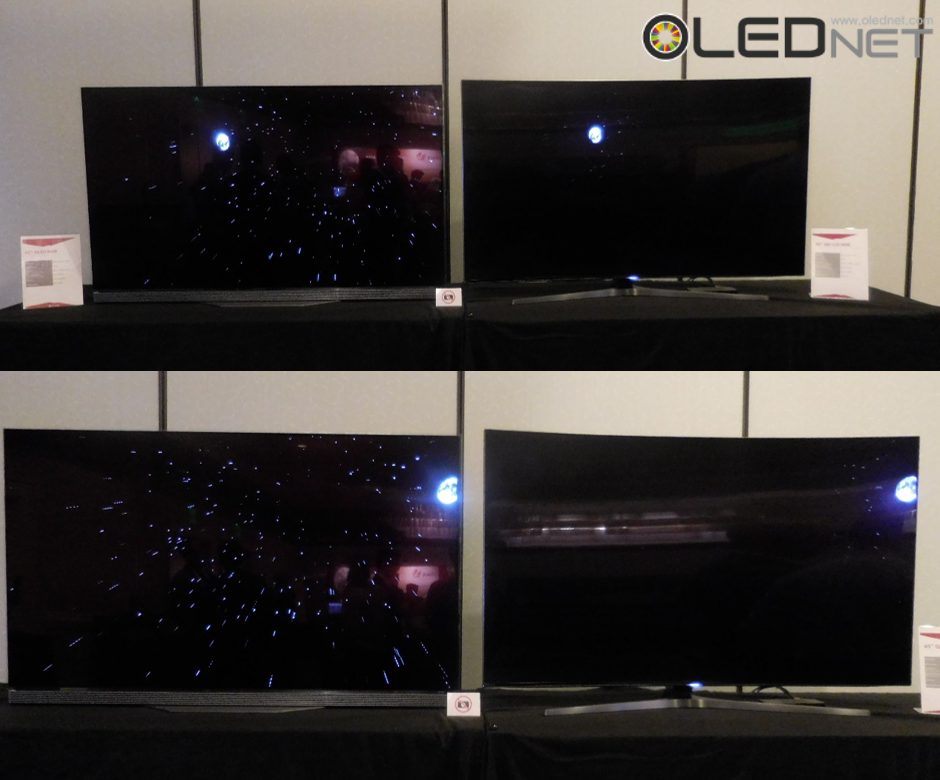
< Comparisons of 65inch OLED TV(Left) and 65inch curved QD-LCD TV’s Black Expressiveness >
Comparing the two pictures similar to images of space show below at the exhibition, OLED TV shows individual stars accurately while QD-LCD TV presents the stars vaguely just to indicate them. In the aspects of viewing angle, OLED TV nearly didn’t have any left-right color changes but its changes were found in QD-LCD TV.
Previous SID2016’s Nanosis and QD vision, Samsung and Hisense emphasized that QD-LCD is better than OLED TV in IFA 2016, but in this OLED Summit 2016, LG Display showed that OLED TV is much more outstanding compared to QD-LCD TV.
Like this, the position between QD-LCD TV and OLED TV is becoming more competitive, and the industry has the interest in which type of TV will gain more of customer’s trust.
미국 샌디에고에서 개최중인 OLED Summit 2016에서 LG Display가 동급 최고모델인 65ich UHD OLED TV와 65inch Curved QD-LCD TV를 비교해 참석자들의 큰 관심을 끌었다.
비교 모델의 스펙은 아래와 같다.

일반 TV 프로그램, 영화 등의 다양한 영상과 패턴을 통해 OLED TV와 QD-LCD TV의 다양한 화질을 비교할 수 있도록 전시하였다.
LG Display 관계자는 “OLED TV와 QD-LCD TV를 UHD Alliance 표준인 white 색온도 6500K를 표현할 수 있는 모드로 설정을 하게 되면 OLED TV가 QD-LCD TV에 비해 압도적으로 black를 잘 표현하고 있음을 볼 수 있다. 기본적으로 QD LCD TV가 휘도는 OLED TV보다 높지만 기본은 LCD이기 떄문에 OLED TV의 색감보다 white 톤이 더 가해져 왜곡되는 느낌을 받는다. 또한 시야각에서도 OLED TV는 왜곡이 거의 없이 표현할 수 있지만 QD-LCD는 색이 왜곡된다.” 라며 OLED TV가 QD-LCD TV보다 우수한 화질을 강조하였다.
실제 전시장에서 상영된 영상을 비교해보면 아래 사진과 같이 우주영상에서 OLED TV는 별 하나하나를 선명하게 표현하는 반면 QD-LCD TV는 별을 희미하게 구분할 수 있을 정도로만 표현되었다. 시야각 측면에서도 OLED TV의 좌 우 색변화는 거의 없었지만 QD-LCD TV는 색이 변하는 것을 확인할 수 있었다.

<65inch OLED TV(좌)와 65inch curved QD-LCD TV의 Black 표현력 비교>
지난번 SID2016의 나노시스와 QD비젼이, IFA 2016에서 삼성전자와 하이센스가 QD-LCD TV가 OLED TV보다 우수함을 강조하였지만, 이번 OLED Summit 2016에서는 LG Display가 QD-LCD TV보다 OLED TV가 훨씬 뛰어남을 보여주었다.
이처럼 QD-LCD TV진영과 OLED TV진영간의 화질 경쟁이 더욱 치열해 지고 있으며, 앞으로의 TV시장에서 어떤 TV가 소비자들에게 인정을 받을 수 있을 지 업계의 관심이 주목되고 있다.
The Apple Watch Series 2 has been officially unveil with iPhone 7 and iPhone 7 so it is expected that the battle between Samsung Gear S3 and the Apple Watch Series 2 can not be avoided even if the official release day of Samsung Gear S3 is undecided.
Apple Watch Series 2 has an improved water resistance rating of 50 meters and includes GPS unit for utilizing location information and tracking movements. Especially, the watch works with Pocketmon Go from Niantic INC which has been very sensational game all over the world. It was announced that the product has four models including Stainless steel, Hermès which Apple produced teaming up with Hermès, and Nike+ which Apple produced teaming up with Nike.
Samsung Gear S3 also includes GPS so it can make various useful functions altitude available for leisure activities and exercising with the sensors for altitude, atmospheric pressure and speed. Samsung Pay function also increases a variety of useful functions. In addition, with saving battery power ability improved, ADO (Always On Display) which is packed so that major alarms are always shown can make the watch is faithful to the original watch function. And the rotating bezel of Samsung Gear S3 attracts public gaze with its sophisticated design presenting the sensitivity traditional watch gave and its intuitive UI built up much better than before.
Both of the smart watches are packing an OLED display which can boast 1,000 Nits peak brightness so it is expected that a great deal of information can be shown on the clear display in bright sunlight. In particular, Apple enhanced the brightness of the display more than doubled than that of the prior product of 450 Nits and Samsung also enhanced the brightness 400 Nits more than that of the prior product.
It has been known that the AMOLED panel for Samsung smart watch is provided by SAMSUNG DISPLAY while Flexible AMOLED panel for Apple Watch Series 2 is supplied by SAMSUNG DISPLAY and LG DISPLAY.
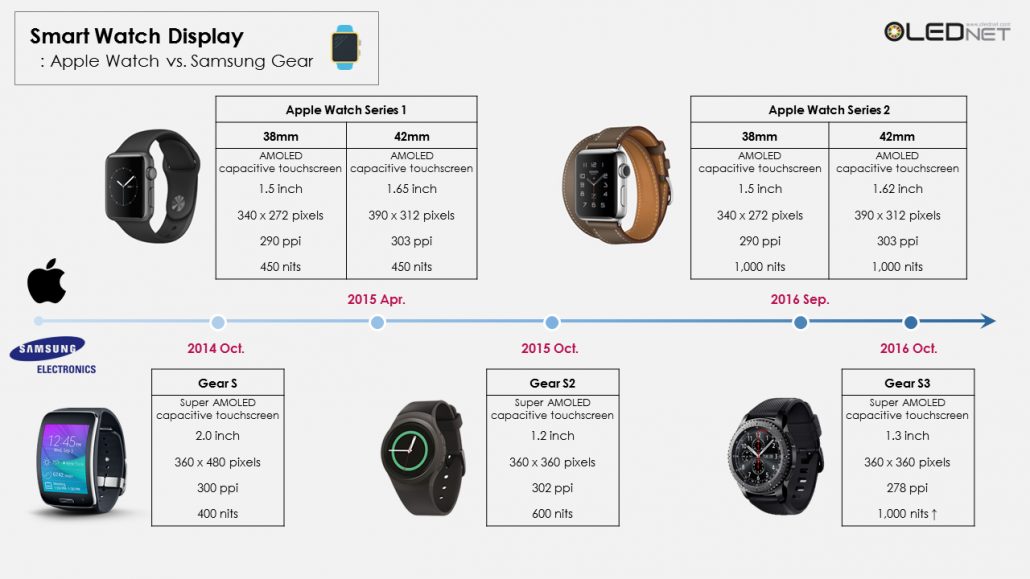
According to UBI research, the market of Smart Watch AMOLED panel is expected to be worth close to one hundred million in 2020 with average annual growth rate of 14%.
애플이 7일(현지시간) 아이폰 7과 7플러스와 함께 애플워치2를 공개하며 지난 31일(현지시간) 공개된 삼성의 기어 S3와 전면전을 펼치게 되었다. 기어 S3는 출시일이 미정이지만 애플워치2와의 전면전을 피할 수 없게 되었다.
애플워치2는 수심 50미터까지 방수가 되는 방수 기능을 강화했고, GPS 유닛이 추가되어 위치 정보 이용 및 운동 추적 기능도 강화되었다. 특히 전세계적으로 돌풍을 이르킨 나이앤틱의 인기 모바일 게임 ‘포켓몬 고’ 앱이 기본 탑재된다.
스테인레스 소재의 애플워치, 에르메스와 함께 만든 ‘애플워치 에르메스’, 나이키와의 협력제품인 ‘애플워치 나이키+’ 등 4종의 애플워치2를 발표했다.
삼성의 기어 S3는 GPS가 탑재되어 고도, 기압, 속도계로 다양한 레저활동과 운동을 할 때 유용한 기능들이 추가되었고, 삼성페이도 추가 탑재됨에 따라 다양한 편의성이 증가 되었다. 또한 배터리 소모를 최소화하며 주요내용을 화면에 표시하는 ‘올웨이즈온디스플레이(AOD)’도 갖춰 시계 본연의 기능에 충실할 수 있게 되었다.
또한, 전통 시계의 감성을 담은 세련된 디자인과 전작보다 더 강화된 회전 베젤의 직관적인 UI로 시선을 모으고 있다.
두 스마트워치 모두 OLED 디스플레이를 탑재하며 1,000 nits 이상의 최대 밝기를 구현하여 밝은 야외에서도 다양한 정보를 선명한 화면으로 확인할 수 있도록 구현하였다. 특히 애플워치2는 전작의 450 nits에서 두배 이상, 기어3도 전작대비 400nit 이상 밝기를 강화하였다.
현재 스마트워치용 AMOLED 패널은 삼성전자의 스마트워치용 flexible AMOLED panel은 삼성디스플레이 단독으로 공급하고 있으며, 애플워치2용 flexible AMOLED panel은 삼성디스플레이와 LG디스플레이에서 공급하는 것으로 알려져 있다.

한편 유비산업리서치에 따르면 스마트워치용 AMOLED 패널 시장은 2020년까지 연평균 약 14%로 성장하여 1억 대 이상의 시장을 형성할 것으로 전망했다.
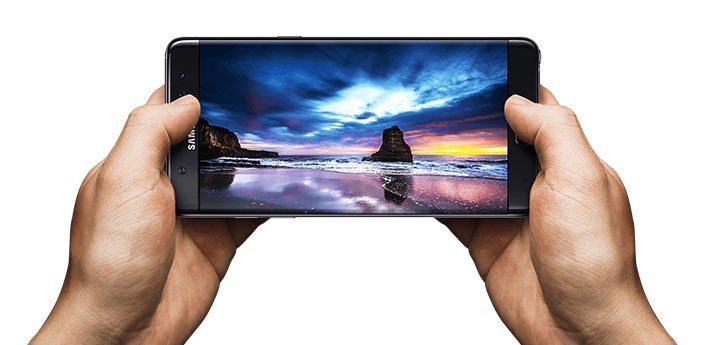
OLED Smartphone Galaxy Note7 (Source = Samsung)
강현주 / jjoo@olednet.com
전세계 시장에서 OLED 스마트폰 시장이 눈에 띄게 성장하고 있다. 2016년 2분기 글로벌 스마트폰용 OLED 패널 출하량은 전년동기 대비 72% 늘어난 것으로 나타났다.
유비산업리서치의 조사에 따르면 지난 2분기 전세계에 출하된 스마트폰용 OLED 패널은 8800만개다. 이는 2015년 2분기 5120만개보다 72% 상승한 수치다.
OLED 스마트폰 시장의 급성장을 주도 하는 것은 한국과 중국의 주요 스마트폰 업체들이다.
OLED 스마트폰 시장 대표주자인 삼성전자는 OLED 스마트폰 제품을 확대하고 있다. 최근 이 회사는 갤럭시노트 시리즈로는 처음으로 플렉서블 OLED 패널이 탑재된 갤럭시노트7을 발표하기도 했다.
삼성 뿐 아니라 중국 스마트폰 업체들도 OLED 채용을 늘리며 이 시장 성장을 이끌고 있다.
특히 화웨이의 스마트폰 사업 성장이 OLED 시장에 적지 않은 영향을 주고 있다. 시장조사업체 IDC에 따르면 올해 상반기 전세계 스마트폰 판매량 증가는 3%에 불과하다. 하지만 다수의 OLED 스마트폰 제품을 보유한 화웨이의 올해 상반기 스마트폰 판매량은 전년동기 대비 25%가 늘었다.
한편 유비산업리서치에 따르면 2016년 2분기 글로벌 스마트폰용 OLED 패널 시장 총 매출은 31억6000만 달러로 전년동기에 비해 약 27% 상승했다.
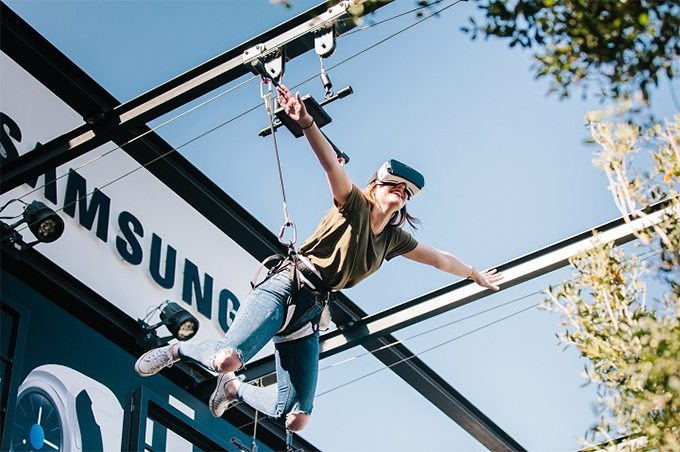
리스본 락 페스티발에 마련된 갤럭시 어드벤쳐 파크에서 삼성전자 모델이 VR 번지점프를 하고 있다. (출처 = 삼성전자)
강현주 / jjoo@olednet.com
올해 상반기 OLED 웨어러블 기기 시장은 전년동기와 달리 스마트 워치 부문은 조용했던 반면 가상현실( VR ) 기기와 스마트 밴드가 대세를 이뤘다.
유비산업리서치의 조사에 따르면 올해 상반기 공개된 OLED 웨어러블 기기 중 VR기기 (OLED 디스플레이를 직접 탑재하거나 OLED 스마트폰을 끼워 쓸 수 있는 VR 기기) 는 6종, 스마트 밴드는 4종이다.
2015년 상반기 공개된 OLED 웨어러블 기기는 스마트 워치 5종과 스마트 밴드 3종이다. 이는 스마트 워치 신제품이 거의 나오지 않은 올해 상반기와 대조적인 모습이다.
VR 부문은 오큘러스가 지난 1월 삼성디스플레이의 OLED를 탑재한 VR 기기인 ‘오큘러스 리프트’를 발표한 것을 시작으로 소니, HTC, DeePoon 등이 소비자 가전 전시회 (CES) 같은 국제 전시회에서 신제품을 속속 공개했다. 최근 삼성전자는 뉴욕 갤럭시 노트 7 언팩 행사에서 갤럭시 노트 7과 연동되는 새 ‘기어 VR’ 제품을 발표, 이에 힘입어 3분기에도 VR 열기가 지속될 예정이다.
지난 상반기 스마트밴드 부문은 삼성전자의 ‘기어 핏2’, 샤오미의 ‘미 밴드2’, Fitbit의 ‘알타’ 등이 출시되며 시장을 달궜다.
올해 상반기 발표된 OLED 스마트 워치 신제품은 중국 GEAK이 지난 5월 ‘CES 아시아 2016’에서 전시한 OLED와 E-Paper 듀얼 디스플레이의 ‘GEAK Watch 3세대’가 유일한데 그나마 시장에 나오지 않았다.
스마트 워치 시장이 이처럼 정체를 보이는 것은 짧은 배터리수명, 유용한 애플리케이션의 부재 등으로 소비자 마음을 잡지 못한 것이 요인으로 지목돼 왔다.
하지만 3분기 삼성전자와 애플의 스마트 워치 신제품이 발표될 것으로 알려지면서 이 시장이 다시 활기를 찾을 것으로 기대된다.
삼성은 오는 9월 베를린에서 열리는 IFA 2016에서 ‘기어 S3’를 공개할 것으로 알려졌으며 애플도 9월에 ‘애플 워치2’를 발표한다는 소문이 있다. 실제로 애플은 지난 6월 세계 개발자 회의( WWDC )에서 속도와 기능을 강화한 스마트워치용 새 운영체제 ‘Watch OS 3’ 를 공개한 바 있어 기대가 모아진다.
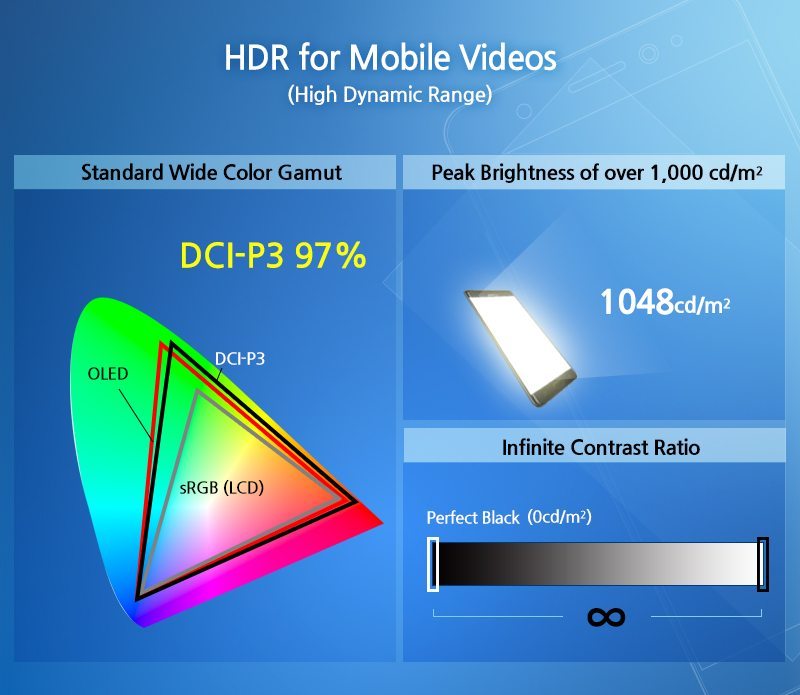
Galaxy note 7 이 밝기 1,000cd/㎡를 돌파했다.
강현주 / jjoo@olednet.com
삼성전자의 신제품 갤럭시노트7( Galaxy note 7 )의 디스플레이가 스마트폰 최초로 밝기 1,000cd/㎡(가로·세로 1미터의 평면에 촛불 1000개를 켜 놓은 정도의 밝기)를 돌파했다고 삼성디스플레이가 10일 발표했다.
갤럭시노트7은 디스플레이 전문 기관인 디스플레이메이트의 화질평가에서 종합점수 ‘Excellent A’ 등급을 획득했다. 디스플레이메이트가 공개한 평가 결과에 따르면 갤럭시 노트7은 주요 평가항목인 밝기, 야외시인성, 색 표현력 등에서 역대 최고 수준을 기록한 것으로 나타났다.
갤럭시노트7은 5.7형 QHD(2560×1440) OLED를 탑재해, 해상도와 사이즈 면에서 전작인 노트5와 동일한 스펙을 유지했으나 밝기, 반사율 등 야외시인성 관련 성능은 크게 개선된 것으로 나타났다.
스마트폰은 다른 IT제품에 비해 야외에서 사용하는 경우가 많아, 밝은 태양광 아래에서도 화면이 또렷이 보이는 정도인 야외시인성이 중요하다. 야외시인성은 디스플레이의 밝기와 반사율에 가장 큰 영향을 받는다. 디스플레이메이트에 따르면 노트7의 최대 밝기는 1,048cd/㎡로 측정돼 전작인 갤럭시 노트5의 861cd/㎡ 보다 22% 가까이 높아졌다.
갤럭시노트7은 화면 시청을 산만하게 하고 눈에 피로도를 높이는 요소인 화면반사율도 지속 개선해 노트 시리즈 중 역대 최저인 4.6%를 달성했으며, 무한대에 이르는 명암비 등을 통해 야외에서도 뛰어난 가독성을 확보했다는 게 삼성전자의 설명이다.
갤럭시 노트7은 모바일 HDR(High Dynamic Range) 기술을 탑재했다. 사람의 눈은 암흑 상태인 0cd/㎡부터 수만 cd/㎡까지 다양하게 인식하는데 비해, 디스플레이는 그보다 훨씬 좁은 영역의 밝기만 표현할 수 있어 그 동안 자연스러운 장면을 담아내기 어려웠다. HDR은 화면의 어두운 부분은 더욱 어둡게 표현하고, 밝은 곳은 더욱 밝게 표현해 화질을 높이는 기술로 현재 프리미엄 UHD TV를 중심으로 사용되고 있다.
특히 이번 평가에서 갤럭시 노트7은 DCI-P3의 색표현영역 만족도 97%라는 최고 수준의 기록을 달성해 약 80% 수준인 LCD 기반 제품보다 월등한 화질 성능을 과시했다.
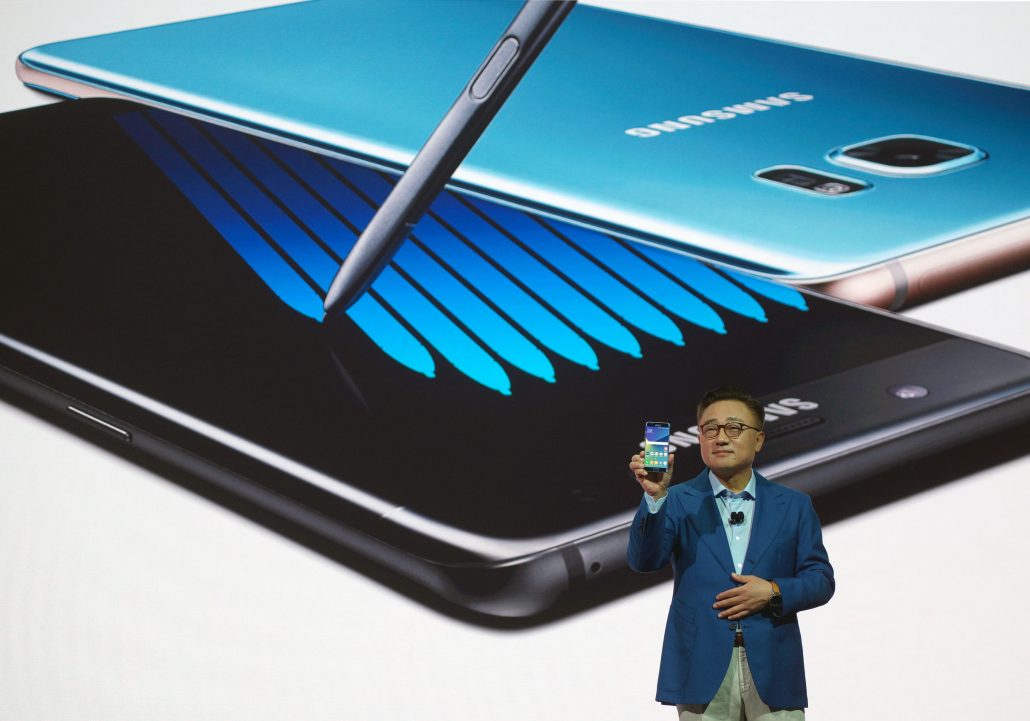
삼성전자가 Galaxy Note 7 을 공개했다.
강현주 / jjoo@olednet.com
삼성전자가 2일(현지시간) 미국 뉴욕에서 ‘삼성 갤럭시 언팩’ 행사를 열고 ‘갤럭시 노트7( Galaxy Note 7 )’을 공개했다.
‘갤럭시 노트7’은 시리즈의 6번째이지만, 숫자 ‘6’를 건너뛰고 최종 ‘7’으로 제품명을 정했는데, 이는 상반기에 출시된 ‘갤럭시 S7’과 숫자를 통일해 보다 쉽고 일관성 있게 고객들과 커뮤니케이션 하기 위해서다.
‘갤럭시 노트7’은 노트 시리즈 최초로 IP68의 방수ㆍ방진 기능을 제공하고, 개선된 S펜(Pen)을 탑재했다.
삼성전자 스마트폰 최초로 ‘홍채인식’ 기능을 탑재해, ‘삼성 녹스(Knox)’와 생체인식을 결합하는 업계 최고 수준의 보안 솔루션을 제공한다.
특히 홍채 인식을 이용해 로그인이나 인증 서비스가 가능한 ‘삼성패스’ 기능이 탑재돼 편리한 모바일 뱅킹 서비스도 지원된다.
개인의 데이터, 애플리케이션을 분리된 공간에서 관리할 수 있는 ‘보안 폴더’ 기능을 통해 일상에서 스마트폰을 보다 안심하고 사용할 수 있다.
노트 시리즈 최초로 전면 엣지 디스플레이를 채용함과 동시에 상하좌우와 전후면 모두 대칭을 이루는 엣지 디자인을 적용하고, 대 화면임에도 한 손으로 편안하게 사용할 수 있는 최적의 그립감을 제공한다.
‘갤럭시 노트7’은 HDR(High Dynamic Range) 비디오 스트리밍을 지원해 최고의 엔터테인먼트 경험을 제공할 예정이다. Always On Display도 애플리케이션 알림, 뮤직 컨트롤 등 기능이 대폭 강화됐다.
함께 새롭게 출시되는 ‘기어 VR’은 시야각을 개선하고 제품 외부에 USB 타입-C 포트도 탑재해 외부기기 연결도 가능해졌다.
소비자들은 이와 같은 ‘갤럭시 노트7’의 혁신적이고 다양한 기능들을 통해 그 동안 스마트폰에 기대했던 사용성을 모두 경험할 수 있다.
삼성전자 무선사업부장 고동진 사장은 “삼성전자는 대 화면과 S펜을 채용한 갤럭시 노트 시리즈를 통해 스마트폰 시장에 새로운 기준을 제시하고 패블릿 카테고리를 선도해 왔다”며 “이번에 새롭게 선보이는 갤럭시 노트7은 패블릿 시장에서의 독보적 지위를 다시 한번 확인하고 소비자들에게 보다 혁신적인 사용성을 제공할 것”이라고 말했다.
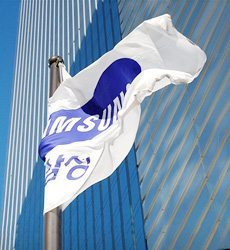
삼성디스플레이의 5세대 OLED 라인 증설이 필요하다는 분석이 나오고 있다.
강현주 / jjoo@olednet.com
삼성디스플레이가 급증하는 OLED 스마트폰 수요에 대응하기 위해서는 Gen5.5 rigid OLED라인의 추가 증설과 V1라인 이동이 불가피한 것으로 분석된다.
현재 중국의 스마트폰용 OLED 수요는 폭발적이다. 유비산업리서치의 조사에 따르면 중국에서 내년까지 필요로하는 물량은 2억개에 달한다.
그러므로 삼성디스플레이는 A2 공장에서 보다 많은 OLED패널을 생산하기 위해 투명 OLED를 생산하는 V1라인을 LCD용 Gen8 공장인 L8로 이동 해야 할 것으로 판단된다.
OLED용 V1 라인은 Gen8 장비에서 제조된 TFT 기판을 6분할하여 사용하여 왔기 때문에 V1 라인이 Gen8 공장으로 이전하는 것이 패널 생산과 물류 관리 차원에서 가장 바람직할 것으로 풀이된다.
유비산업리서치 이충훈 대표는 “중국의 향후 모바일 OLED수요는 BOE 등 중국의 주요 패널 업체들이 감당하기 힘든 물량인 것은 물론, 모바일 OLED최강자인 삼성디스플레이도 현존하는 양산라인으로는 충분한 공급이 쉽지 않다”며 “이에 삼성디스플레이는 최소 Gen5.5 A2 라인에 20~30k 규모의 OLED양산라인 증설이 필요할 것”이라고 내다봤다.
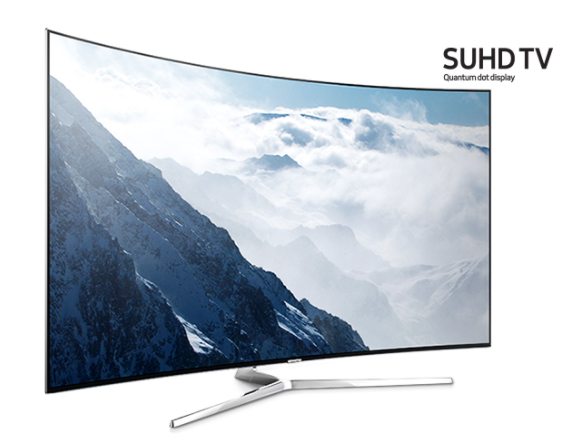
QLED 가 차세대 TV 기술로 이슈가 되고 있다. (사진출처 = Samsung Elec.)
유비산업리서치 수석 애널리스트 이충훈
최근 QLED가 차세대 TV 기술로서 언론에서 이슈가 되고 있다. 삼성전자가 현재 판매중인 SUHD TV의 차기 제품으로 QLED TV를 지정했기 때문이다. 하지만 QLED TV용 디스플레이가 electroluminescence quantum dot 기술을 이용하는 제품이라면 디스플레이를 몰라도 너무 모르는 소리이다.
Quantum dot 기술을 이용하는 디스플레이는 빛을 내는 메커니즘에 따라 2가지로 분류된다. photoluminescence quantum dot과 electroluminescence quantum dot 기술이다. photoluminescence quantum dot 기술이란 외부 광에 의해 자극된 물질이 다시 빛을 내는 메카니즘으로서 현재 LCD TV에 적용중인 QD 기술이다.
백라이트에서 나오는 청색 빛에 quantum dot sheet를 부착하여 백라이트 유닛으로 사용하고 있는 제품으로 삼성전자 SUHD TV가 바로 이 제품이다. photoluminescence quantum dot은 색 재현 범위가 넓어 NTSC 기준 110% 이상의 빛을 표현할 수 있어 LCD TV로서는 최상의 제품임에 틀림없다. 또 다른 photoluminescence quantum dot 기술로서는 color filter에 quantum dot 물질을 분산 시켜 색을 표현하는 방식이 개발 중에 있다.
이에 비해 electroluminescence quantum dot 기술은 전기를 가했을 때 스스로 빛을 내는 자발광 물질로서 OLED와 유사하다. 빛을 내는 재료만 무기물이며 구조는 OLED와 흡사하다. OLED는 빛을 내기 위해 정공이 HIL 층을 통해 전극에서 들어 오고, 이 정공이 HTL 층을 통해 발광물질에 도달한다.
전자가 EIL 층과 ETL 층을 거쳐 발광재료에 도착하면 전자와 정공에 의해 에너지 준위가 급상승한 발광재료는 불안정한 상태를 벗어나기 위해 빛을 발산하고 기저 상태로 돌아간다. HIL과 HTL, EIL, ETL층이 OLED에 필요한 이유는 전자와 정공이 발광재료에 도달하기 위한 에너지 준위 조절 기능을 하기 때문이다.
따라서 electroluminescence quantum dot이 빛을 내기 위해서는 OLED와 마찬가지로 HIL과 HTL, EIL, ETL 층이 필요하다. electroluminescence quantum dot 기술을 개발하고 있는 사이언티스트들은 HIL과 HTL, EIL, ETL 재료는 OLED용을 사용하고 있다. 아직 전용 재료가 개발되어 있지 않아 기술 수준은 걸음마 단계이다. 기술이라는 영역보다는 아직 과학이라고 할 수 있는 영역에 속해 있다.
더욱이 electroluminescence quantum dot은 용액에 분산시켜 프린팅 하는 방식을 사용하고 있어 ink-jet 또는 유사한 장비 개발이 필수적이다. 물론 HIL과 HTL, EIL, ETL도 용액으로 도포해야 한다.
여기서 궁금한 점은 삼성전자가 말하는 QLED TV가 photoluminescence quantum dot을 사용하는기존 QD 기술인지 electroluminescence quantum dot을 사용하는 기술인지이다. 일반적으로 QLED는 electroluminescence quantum dot 기술을 의미하기 때문에 삼성전자가 정말 electroluminescence quantum dot을 사용하는 QLED TV를 수년 이내에 판매 할 수 있다면 과학의 신기록을 수립하는 지상 최고의 혁신 기업이 될 것임이 틀림없어 매우 기대가 되는 부분이다.
하지만 OLED 발광 물질을 개발하고 있는 재료 업체들은 말도 안되는 소리라고 일축하고 있다. 용액 공정으로 제작하는 OLED용 발광재료와 HIL, HTL, EIL, ETL 재료도 아직 제대로 개발이 안되어 있어 상용화에는 5년 정도 시간이 더 소요 될 것이라고 보고 있는데 QLED를 수년 내로 구현한다는 것은 불가능하다는 것이 업체들의 공통적인 목소리다. QLED 전용 HIL, HTL, EIL, ETL 재료는 아직 개발되고 있지 않다는 것이 업계 현실이다.
프린팅용 장비 또한 아직 상용화된 제품이 없다. electroluminescence quantum dot 기술을 개발하는 학계에서도 이제 겨우 가능성을 본 정도라며 너무 앞서 나간다고 지적한다.
QLED를 하기 위해서는 거쳐야 하는 단계가 있다. 용액 공정을 사용하는 QLED가 상품화되려면 최소한 용액 공정 OLED가 출현하고 난 다음이 될 수 밖에 없다. OLED가 상품화까지 도달한 이력을 보면 빨라야 10년이다.
OLED로 TV를 만들지 못하는 삼성전자가 QLED로 3년내에 TV를 만들겠다고 언급한 것에 대해 “과연 삼성이다”라고 감탄해야 할 지 “삼성이 왜 이래?”라고 봐야할 지. . . .

출처 = Samsung Elec.
Hyunjoo Kang / jjoo@olednet.com
Samsung Elec. announced its earnings guidance for the second quarter of 2016.
Samsung Elec. estimates that consolidated sales came to approximately KRW 50 trillion, and consolidated operating profit of approximately KRW 8.1 trillion.
The above figures are estimates of consolidated earnings based on K-IFRS. Korean disclosure regulations do not allow earnings estimates to be provided as a range. Therefore, the above figures are based on the median of the earnings estimate range, as given below.
| (in trillion won) | 2016. 1Q | 2015. 2Q |
| Sales | 49.8 | 48.5 |
| Operating profit | 6.7 | 6.9 |
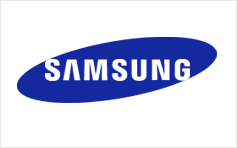
Samsung CI
강현주 / jjoo@olednet.com
삼성전자( Samsung Elec.)는 글로벌 경쟁력 제고와 창의적, 수평적 조직문화 조성을 위해, 기존 연공주의 중심 인사제도를 업무와 전문성을 중시하는 ‘직무·역할’ 중심의 인사 체계로 개편한다.
삼성전자는 27일 경력개발 단계(Career Level) 도입을 통한 직급 체계 단순화, 수평적 호칭을 골자로 하는 인사제도 개편방안을 발표했다.
기존 부장, 과장, 사원 등 수직적 직급 개념은 직무 역량 발전 정도에 따라 ‘경력개발 단계(Career Level)’로 전환되며, 직급 단계는 기존 7단계(사원1/2/3, 대리, 과장, 차장, 부장)에서 4단계(CL1~CL4)로 단순화된다.
이번 개편에 따라 삼성전자는 임직원 간 공통 호칭은 ‘ㅇㅇㅇ님’을 사용하게 된다. 단, 부서 내에서는 업무 성격에 따라 ‘님’, ‘프로’, ‘선후배님’, 영어 이름 등 상대방을 서로 존중하는 수평적인 호칭을 자율적으로 사용할 수 있다. 팀장, 그룹장, 파트장, 임원은 직책으로 호칭한다.
삼성전자는 수평적·창의적 조직문화 확산을 위해 회의문화·보고문화 개선, 불필요한 잔업 및 특근 근절, 계획형 휴가 정착 등을 지속적으로 추진한다.
이와 함께 효율적 회의문화를 위한 개편도 시행된다. 반드시 필요한 인원만 참석해 자유롭게 의견을 내고 회의의 결론을 도출해 이를 준수하는 회의 문화 확산한다는 것이다.
회의 권장사항으로는 참석자 최소화, 1시간 Best, 전원 발언, 결론 도출, 결론 준수 등이다.
또 빠른 의사결정과 실행력 강화를 위해 직급단계를 순차적으로 거치는 대신 ‘동시 보고’를 활성화하고, 형식에 치우치지 않고 간결하게 핵심 내용을 전달하는 보고문화 정착을 추진한다.
상급자의 눈치를 보며 퇴근하지 않는 ‘눈치성’ 잔업, 불필요한 습관성 잔업, 특근을 근절한다는 내용도 이번 개편에 포함된다.
직원들이 연간 휴가계획을 사전에 자유롭게 수립해 충분히 재충전할 수 있는 휴가 문화 정착도 실시할 예정이다.
이외에도 올해 하절기부터는 임직원 편의를 위해 반바지 착용도 가능해진다.
삼성전자는 새로운 인사제도를 내년 3월부터 본격 시행할 계획이다.
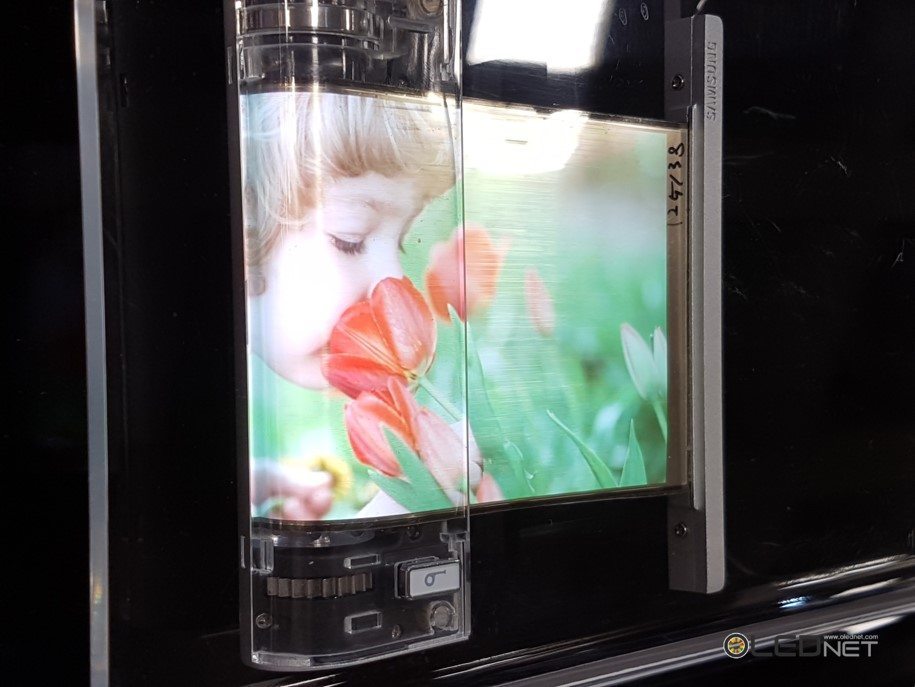
SID 2016에 전시된 flexible OLED
강현주 / jjoo@olednet.com
삼성디스플레이의 플렉서블( Flexible ) OLED 생산 능력이 내년에는 7배 이상 증가할 것이라는 전망이 나왔다.
현대증권 김동원 애널리스트는 삼성디스플레이는 애플 OLED 투자 뿐 아니라 삼성전자 향으로도 추가적인 신규캐파 확보가 필요하다는 점을 들어 이같이 내다봤다.
또한 A3 공장은 내년 2분기 풀 캐파가 예상되어 향후 플렉서블 OLED 신규투자의 추가 공간확보를 위해 삼성디스플레이는 2년 소요되는 신규공장 (A4) 건립 대신에 7세대 LCD 라인을 올 연말까지 매각한 후 7세대 LCD 공장에 플렉서블 OLED 신규라인 구축을 시작할 것으로 예상된다.
따라서 엣지 스크린 탑재 확대는 삼성전자 스마트 폰 사업에 차별화된 경쟁력을 제공할 것으로 판단되며 플렉서블 OLED 신규투자 확대로 관련 밸류체인인 한솔케미칼, 한솔테크닉스, AP시스템, 테라세미콘 수혜가 기대된다.
김동원 애널리스트는 또 올 하반기 출시 예정인 갤럭시노트7은 엣지 스크린을 100% 채택한 단일모델 출시가 전망되어 지난 2014년 엣지 출시 이후 2년간 갤럭시S7까지 적용된 삼성전자의 투트랙 모델 (엣지, 평면) 전략에 변화가 있을 것으로 예상했다.
2014년 독일 가전전시회 (IFA)에서 갤럭시노트4 엣지가 최초 공개된 후 2년 만에 엣지 스크린에 대한 소비자들의 인식과 평가가 성공적이고, 2017년 한번 접을 수 있는 폴더블 폰 출시를 앞두고 삼성전자 스마트 폰의 프리미엄 제품믹스 전략에 변화가 필요하며, 5년간 엣지 제품을 개발하면서 플렉서블 OLED 라인 수율이 85% 수준에 이르면서 생산성 확보에 따른 대규모 양산체제 구축이 가능해졌기 때문이다.
2016년 6월 현재 갤럭시S7 전체에서 엣지 폰 판매비중은 65%로 판단되며 엣지 스크린은 차별화된 폼팩터 구축에 성공한 것으로 평가된다. 이처럼 엣지 스크린의 소비자 반응이 예상을 상회하면서 갤럭시노트7에 이어 내년 상반기 출시될 갤럭시S8도 100% 엣지 단일모델로 출시 가능성이 높을 전망이라는 게 김동원 애널리스트의 설명이다.

QLED TV 양산이 향후 5년간 쉽지 않을 것이란 전망이 나왔다. (Source = Samsung Elec.)

Gear Fit 2 (Source = Samsung)
강현주 / jjoo@olednet.com
삼성전자가 더욱 새로워진 피트니스 웨어러블 기기 ‘기어 핏(Gear Fit)2’를 21일 오전 10시부터 사전 판매한다.
‘기어 핏2’ 사전 판매는 222대 한정으로 진행되며, 삼성 온라인 스토어(http://store.samsung.com/sec)에서 진행된다. 출고가는 19만 8,000원이다.
사전 판매는 블랙 색상 한정으로 진행되며 손목 둘레에 따라 스몰, 라지 사이즈를 선택할 수 있다.
사전 판매를 통해 구매한 고객 전원에게는 ‘기어 핏2’의 단독 MP3 재생 기능을 자유롭게 이용할 수 있도록 목걸이형 블루투스 헤드셋 ‘레벨 U 프로’를 증정한다.
지난 2일 미국 뉴욕에서 공개된 ‘기어 핏2’는 전작 ’기어 핏’ 보다 한층 강화된 피트니스 기능과 세련된 디자인으로 화제를 모으고 있다.
‘기어 핏2’는 자체 GPS센서가 탑재돼 스마트폰 없이도 사용자의 움직임을 정밀하게 인식하며, 걷기, 달리기, 자전거 등 5가지 종목을 자동으로 감지해 운동 상태를 실시간으로 측정해준다.
기상부터 수면까지 하루 24시간의 다양한 신체 활동을 지속적으로 기록해주기 때문에 효과적이고 체계적인 건강 관리가 가능하다.
‘기어 핏2’는 패션 아이템으로도 손색없는 세련된 디자인이 강점이다. 손목에 착 감기는 커브드 디자인은 사용자에게 편안한 착용감을 제공한다.
1.5형 수퍼 아몰레드 디스플레이는 야외에서도 또렷한 화면을 제공하고, 직관적인 피트니스 UX는 다양한 운동 정보를 쉽고 정확하게 전달한다.
‘기어 핏2’는 사용자가 운동을 보다 자유롭고 신나게 즐길 수 있도록 해준다.
약 2GB의 자체 메모리로 스마트폰 없이도 음악 파일을 최대 500곡까지 저장할 수 있으며, IP68 방수 등급으로 우천시에도 안심하고 야외 활동을 가능하게 한다.
운동 상황을 친구, 가족과 함께 공유하거나 비교하며 재미있게 즐길 수 있다. ‘기어 핏2’는 GPS를 활용한 다양한 특화 애플리케이션을 제공한다.
이 제품은 자체 GPS로 스마트폰 없이도 골프 코스 정보와 거리, 고저차 측정까지 가능한 ‘골프나비’를 무료로 제공하며, 아웃도어 포털 커뮤니티 ‘트랭글’과 연계해 자전거 기록 측정이 가능한 ‘바이크 타임어택’, 16개 국립공원과 1,500개의 등산로 정보를 담은 ‘등산 네비게이션’, 전국 1,800개의 코스 정보를 담은 ‘둘레길’ 등 국내 소비자들을 위한 다양한 애플리케이션을 선보인다.
‘기어 핏2는’ 24일 공식 출시 되며, 삼성전자 온라인 스토어, 디지털 프라자 등에서 판매할 예정이다.
삼성전자 관계자는 “혁신적으로 향상된 성능과 세련된 디자인을 겸비한 기어 핏2는 스포츠 매니아 뿐만 아니라 일반인들에게도 스마트한 운동 파트너가 될 것”이라며 “이번 사전 판매를 통해 기어 핏2를 가장 먼저 만나보시길 바란다”고 전했다.
‘기어 핏2’ 사전 판매 정보는 삼성전자 온라인 스토어 홈페이지(http://store.samsung.com/sec)에서 확인할 수 있다.
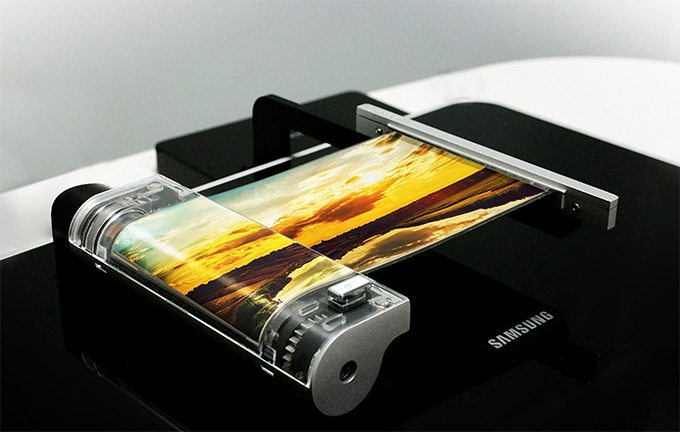
출처 = Samsung Display
강현주 / jjoo@olednet.com
삼성디스플레이가 올해 OLED 양산 설비 확대를 위해 약 8조원을 투입할 예정이라고 일본 니케이 신문이 18일 보도했다.
보도에 따르면 삼성디스플레이는 충남 탕정 공장의 OLED 양산 설비를 확충할 예정이다. 8조원 투자는 삼성디스플레이의 지난해 투자에 달하는 금액으로 스마트폰용 패널 2억수천만 장 분에 해당되는 규모다. 이는 현재 생산능력의 50%가 넘을 것이라고 니케이는 보도했다.
삼성디스플레이의 이같은 행보는 애플이나 중국 업체들에 OLED를 공급하기 위한 준비로 풀이된다. 삼성의 대형투자는 OLED 패널 시장을 거의 독점하려는 계획이며, 이는 패널 생산 경쟁사들에 위협이 될 것이라는 게 니케이의 분석이다.
한편 애플은 2018년에 OLED 스마트폰 출시 방침을 부품 업체에 전달했지만 일부 기종은 내년으로 앞당길 계획으로 알려졌다.

삼성이 2019년 QLED TV를 낼 수 있을 것이라는 얘기가 시장에서 나오고 있다. (출처 = 삼성전자)
강현주 / jjoo@olednet.com
OLED 협회( OLED Association ) 사무총장 배리 영( Barry Young )이 디스플레이 데일리에 기고한 글을 통해 “2019년 QLED 가 양산된다는 쓰레기 같은 말은 믿지 말라( don’t believe the garbage about QLEDs in 2019 )”고 발언한 것을 14일 국내 언론들이 보도하면서 화제가 됐다.
이 발언의 의미는 QLED 자체가 쓰레기 같다는 게 아니라 2019년에 양산된다는 전망에 대해 회의적인 입장을 표명한 것이라는 게 전문가들의 풀이다.
배리 영은 ‘Drinking the QD Kool-Aid’이라는 컬럼( http://www.displaydaily.com/display-daily/39500-drinking-the-qd-kool-aid )을 통해 이같이 발언했다. 이는 최근 삼성전자가 OLED TV 양산을 하지 않고 차세대 제품으로 QLED TV를 양산할 것이며 이는 2019년에 가능할 것이라는 얘기가 나온 것을 염두에 두고 한 발언으로 보인다.
삼성전자는 QLED TV 양산 시기에 대해 공식적인 입장을 표명하고 있지는 않지만 시장 일각에서는 2019년이면 가능할 것이라 보고 있다. 하지만 이와 다른 관점을 가진 전문가들도 다수다.
QLED란 기존 OLED에 사용되는 공통층을 그대로 사용하면서 발광층의 Host와 Dopant를 양자점 (Quantum Dot)으로 바꾼 디스플레이다. QLED에 사용되는 발광층의 재료인 Quantum Dot은 무기재료를 사용하여 OLED의 발광층 재료보다 가격이 상대적으로 저렴해 생산비용을 낮출 수 있다는 게 장점이다. 공정을 잉크젯 기반으로 할 수 있어 증착과정이 필요 없다는 점도 QLED의 강점으로 여겨지며 색순도가 OLED보다 좋다는 평가도 있다.
그럼에도 QLED가 단시간 안에 OLED를 넘는 프리미엄 TV 시장의 대세가 되기에는 무리라는 지적이 나오고 있다.
전문가에 따르면 QLED가 해결해야 할 기술적 이슈는 수명과 발광효율 문제다. QLED는 양산 시 상분리 후 ‘핀홀’이 나와 소자의 수명을 낮추며, 홀과 전자의 균형이 맞지 않아 발광효율이 낮아지는 문제가 있다.
또 QLED 는 아직까지 수명과 열화에 대한 연구 조차 진행되지 않았기 때문에 2019년까지 상용화될 수 있을지는 의문이라는 지적도 나온다.
한편 배리 영은 QD-LCD 의 화질이 OLED보다 더 우수하다는 주장에 대해 반박했다. 그는 “QD비전과 나노시스는 퀀텀닷 LED 백라이트 LCD 가 OLED보다 우수하다는 의심스러운 주장을 하고 있다”며 “휘도와 색영역 외에 OLED의 강점인 명암비, 시야각, 응답속도, 색정확도, 폼팩터 같은 요소들은 전혀 고려하지 않고 있다”고 지적했다.

삼성디스플레이의 패널이 탑재된 HP의 OLED Labtop
강현주 / jjoo@olednet.com
OLED가 다양한 장점으로 노트북, 태블릿, 모니터 등에도 적용이 늘어나는 추세다. 이에 따라 삼성디스플레이의 OLED 패널이 이 시장으로 본격적으로 확산되고 있다.
HP 는 최근 삼성디스플레이의 2560×1600 해상도의 13.3인치 OLED를 탑재한 노트북 ‘Spectre 360’ 출하를 시작했다.
앞서 지난 1월 라스베이거스에서 열린 ‘CES 2016’을 통해 삼성전자가 삼성디스플레이의 12인치 OLED가 탑재된 ‘갤럭시 탭 프로 S’를 공개했으며 HP 와 델도 삼성디스플레이의 13인치대 OLED를 탑재한 노트북을 발표했다.
삼성디스플레이는 지난 5월 샌프란시스코에서 열린 ‘SID 2016’에서 2560×1440 해상도의 13.3인치와 14인치 노트북용 OLED를 전시하며 노트북 시장을 적극 공략했다. 이어 국내 한 언론에서는 삼성디스플레이가 노트북 및 모니터용 저해상도 LCD 패널인 TN 패널 생산을 중단할 것이라는 보도가 나오기도 했다.
삼성디스플레이가 노트북 시장 공략을 본격화 하는 것은 OLED의 다양한 장점을 내세워 프리미엄시장을 창출하려는 전략으로 풀이된다.
OLED는 LCD에 비해 명암비가 우수해 더 선명한 화질을 가지며 LCD보다 무게를 더 줄일 수 있어 프리미엄 시장 형성에 용이하다. OLED의 단점으로 여겨졌던 ‘번인(burn in)’ 현상도 많이 개선된 것으로 알려졌다. 이에 삼성디스플레이는 노트북, 태블릿용 OLED 시장 확산에 적극 나서고 있다. 실제로 유비산업리서치의 조사에 따르면 삼성디스플레이의 2016년 1분기 태블릿용 OLED 패널 출하량은 전년동기 대비 10배 이상 증가했다.
당장은 가격이 LCD에 비해 높기 때문에 의료용 등 전문가 시장 공략부터 시작해야 하지만 향후 가격 경쟁력도 높아지게 되면 대중화도 가능할 것이라는 기대가 나온다.
유비산업리서치의 ‘2016 OLED 디스플레이 Annual Report’에 따르면 노트북, 모니터용에 해당하는 11인치~30인치 OLED 패널 출하량은 올해 10만장을 기록할 전망이며 2020년에는 이보다 10배 성장할 것으로 예상된다.
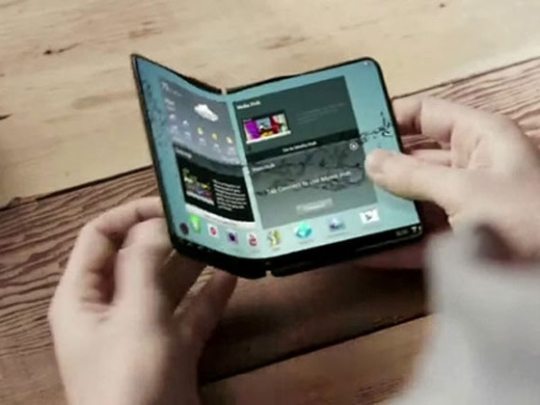
Foldable 스마트폰 이미지 (출처=샘모바일)
내년 상반기에 삼성전자가 접는( Foldable ) 스마트폰을 출시할 것으로 예상된다는 전망이 나왔다.
현대증권 김동원 애널리스트는 10일 “2017년 상반기 삼성전자는 접는 스마트폰 출시가 예상된다”며 “단말기 하드웨어상 의미있는 폼팩터 변화의 시작이 기대된다”고 내다봤다.
특히 2016년 삼성전자는 갤럭시 J 시리즈를 중심으로 한 중저가 라인 업을 탄탄히 구축한 상태에서 내년 상반기 폴더블 스마트 폰 출시는 차별된 프리미엄 제품구성의 추가 보로 향후 글로벌 스마트 폰 시장에서 경쟁력을 더욱 제고할 전망이라는 게 그의 설명이다.
올해 4분기 삼성디스플레이는 7세대 TV용 LCD 생산라인을 매각한 후 LCD 공장에 애플향 OLED 신규투자를 상회하는 규모의 6세대 플렉서블 OLED 신규 캐파 (생산능력)를 대할 것으로 예상된다. 그 이유는 폴더블 스마트 폰의 경우 최소 1회 이상 면이 접히기 때문에 기존 플렉서블 OLED 생 산캐파가 1/2 이상 축소되어 플렉서블 OLED 신규 캐파 대가 반드시 필요하기 때문이다.
이에 따 라 향후 삼성디스플레이는 LCD 생산비중을 대폭 축소하는 대신 플렉서블 OLED 신규 캐파의 공격 적 증설을 추진할 전망이다. 따라서 올 1분기부터 시작된 애플향 플렉서블 OLED 1차 투자는 하반 기부터 삼성전자향 OLED 2차 신규투자로 이어질 것으로 예상된다.
김동원 애널리스트는 폴더블 폰 수혜가 기대되는 업체로는 삼성전기, 한솔테크닉스 (부품), 한솔케미칼 (소재), 테라세 미콘, AP시스템 (장비) 등을 제시했다.
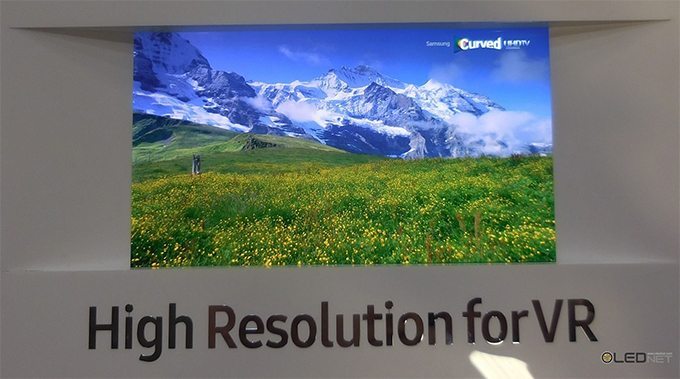
삼성디스플레이는 806 ppi 의 5.5인치 AMOLED를 SID 2016에서 선보였다.
강현주 / jjoo@olednet.com
삼성디스플레이가 최근 공개한 5.5인치 806ppi의 AMOLED는 삼성전자의 향후 가상현실(VR)과 스마트폰 사업에 동시에 시너지를 내는 동시에 글로벌 VR 시장 확대에 기여할 것으로 보인다.
삼성디스플레이는 지난 5월 22일부터 27일까지 샌프란시스코에서 열린 ‘SID 2016’에서 806ppi 해상도의 5.5인치 AMOLED를 공개했다. 4K UHD급의 이 디스플레이는 5인치대 AMOLED 중에서 업계 최고 해상도다.
AMOLED는 LCD에 비해 응답속도가 1000배 가량 빠르고 명암비도 뛰어나 더 우수한 화질을 구현할 수 있으며 블루라이트가 적어 눈건강에 좋다는 점 등 다양한 장점으로 VR용 디스플레이로 대세가 되고 있다.
같은 해상도라도 스마트폰과 VR 기기는 시각적인 효과가 다르다. 가령 갤럭시 S7에 적용되는 577ppi의 QHD 해상도는 스마트폰에서는 꽤 선명한 화질을 구현할 수 있다. 하지만 VR처럼 바로 눈앞에서 화면을 보는 경우는 도트가 튀는 ‘계단현상’이 생긴다.
VR에서 계단 현상이 거의 없는 선명한 화질을 구현하기 위해서는 최소 1500ppi 이상은 돼야한다는 게 전문가들의 설명이다. 하지만 현재 VR용 AMOLED는 500대 후반 ppi까지만 나와있다.
이 가운데 삼성디스플레이가 처음으로 800ppi가 넘는 AMOLED를 전시한 것은 주목할 만한 일이다. 이정도 해상도라면 완벽하지는 않아도 VR에서 계단현상을 어느정도 개선해줄 수 있기 때문이다.
또 이 AMOLED는 현재 판매되고 있는 삼성의 갤럭시 S7과 휘도가 동등하다. 생산 수율 개선 등을 감안할 때 이 디스플레이는 2017년 출시가 예상되는 갤럭시 S8(가칭)에 탑재될 수 있을 전망이다. 스마트폰을 꽂아서 쓰는 방식의 VR 기기의 경우 스마트폰의 해상도가 곧 VR의 화질과 직결된다.
삼성이 개발한 806ppi의 5.5인치 AMOLED는 UHD 스마트폰 제작을 가능하게 하는 동시에 한단계 업그레이드 된 화질의 VR 등장을 가능하게 한다는 얘기다.
유비산업리서치 관계자는 “일각에서는 초고해상도가 스마트폰 같은 작은 화면에서 큰 소용없다는 관점도 있지만 스마트폰이 새롭게 시장이 열리는 VR과 연동된다는 점만으로도 4K UHD 5.5인치 AMOLED는 충분히 의미있다”라며 “삼성이 SID 2016에서 선보인 806ppi AMOLED는 자사의 스마트폰과 VR 사업에 동시에 시너지를 줄 뿐 아니라 글로벌 VR 시장을 더 활성화하는 데 기여할 것”이라고 내다봤다.
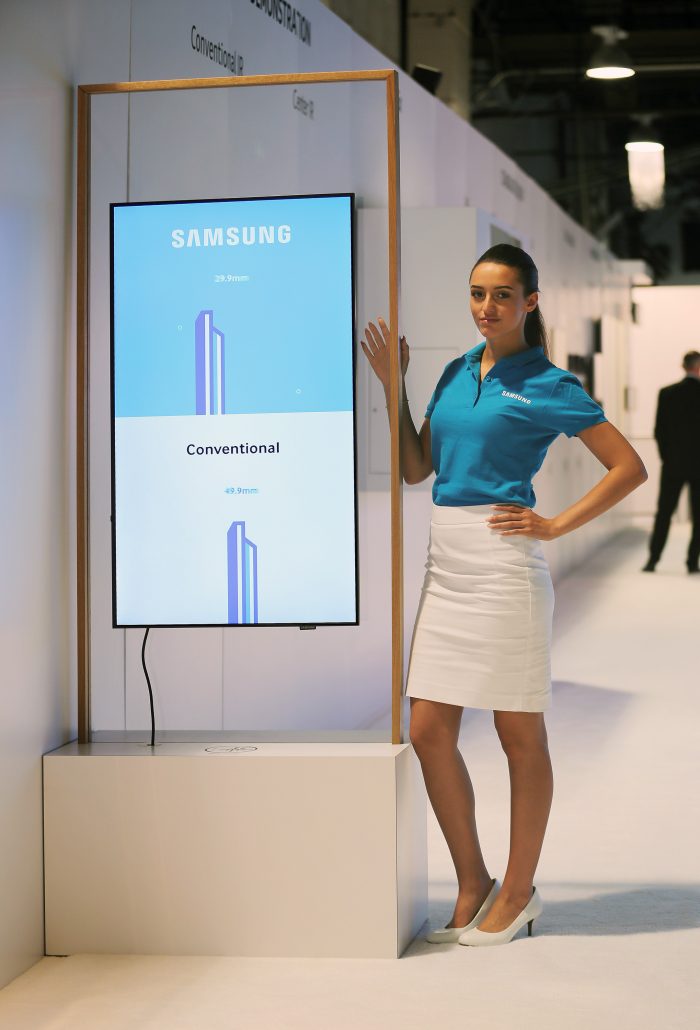
Tizen OS를 탑재한 삼성전자의 스마트 사이니지 (출처 = 삼성전자)
강현주 / jjoo@olednet.com
삼성전자가 미국 라스베이거스에서 열리는 세계 최대 디스플레이 전시회인 ‘인포콤 2016 (Infocomm 2016)’에서 타이젠( Tizen ) OS를 탑재한 스마트 사이니지를 첫 공개했다.
삼성전자는 세계 최소 두께 29.9mm의 초슬림 스마트 사이니지 2개 제품군과 실외에서 사용하는 아웃도어용 스마트 사이니지에 타이젠을 탑재하고 현지시간 8일 공개했다.
초슬림 스마트 사이니지(P시리즈)는 화면밝기 700니트와 500니트의 2개 제품군으로 구성됐으며, 빛 반사 방지 패널을 적용해 화면 가독성을 높이고 24시간 사용에도 문제가 없도록 제품 내구성을 더욱 강화했다.
아웃도어용 스마트 사이니지(OHF시리즈)는 PC, 라우터 등이 내장된 올인원 타입이면서도 기존 아웃도어용 모델보다 슬림한 디자인을 갖췄다. 올인원 타입으로 설치가 매우 간단하고 관리가 쉬운 것도 큰 장점이다.
IP56등급의 방수/방진 기능을 갖추고 있으며, HDBase-T 기능을 지원해 최대 100m 거리까지 영상 신호를 전송할 수 있어 실외에 설치해 사용하기 쉽다.
삼성전자 타이젠 운영체계 사이니지는 새로운 사용자경험(UX, User Experience)를 적용하고, 화려한 영상 콘텐츠를 이용할 수 있는 안정적인 호환성과 그래픽 환경을 지원한다.
사진 이미지, 영상 등 스마트 사이니지를 통해 디스플레이 하는 다양한 멀티미디어 콘텐츠의 안정적인 재생과 실시간 업데이트도 지원한다.
고유의 삼성 스마트 사이니지 플랫폼 (SSSP, Samsung Smart Signage Platform)의 API(Application Programing Interface)를 공개하고, HTML5도 지원해 보다 폭넓은 호환성을 제공한다.
공개된 API를 활용해 스마트 사이니지에서 활용할 전용 프로그램을 쉽게 개발할 수 있으며, 사용자가 이미 구축해 놓은 홈페이지 광고, 홍보에 쉽게 활용할 수 있게 인터넷 접속이 가능한 웹 브라우저 기능도 추가됐다.
삼성전자는 스마트 사이니지 전용 소프트웨어인 ‘매직인포 서버(MagicInfo Server) 4.0’도 첫 공개하고 북미 시장 출시한다고 밝혔다.
매직인포 서버4.0은 대수 제약 없이 전 세계에 설치된 스마트 사이니지의운영과 관리가 가능한 토탈 솔루션 매니지먼트 프로그램이다. 스마트 사이니지에서 운영하는 콘텐츠의 업데이트, 운영 시간 관리 등 손쉽게 관리할 수 있다.
삼성전자 영상디스플레이사업부 김석기 전무는 “삼성전자가 처음으로 공개한 타이젠 운영체계를 탑재한 스마트 사이니지 제품들은 향후 상업용 사이니지 시장에서 새로운 기준이 될 것”이라며, “앞으로도 타이젠 운영체계를 스마트 사이니지 제품군에 확대 적용해 나가겠다”고 밝혔다. 삼성전자는 이외에도 베젤과 화면 크기의 제약이 없는 LED 사이니지의 라인업도 실내용, 실외용으로 다양하게 선보였다.
삼성전자는 다양한 상업용 사이니지 제품에서 이뤄온 최고 수준의 기술 혁신과 경험을 바탕으로 LED 사이니지 시장의 글로벌 시장의 새로운 트렌드를 주도할 예정이다.

Galaxy S ~ Galaxy S7 (Source = UBI Research ‘Analysis Report of Galaxy S Series’)
Hyunjoo Kang / jjoo@olednet.com
Since the first Galaxy S by Samsung Electronics in March 2010, 9 types of Galaxy S Series were launched. For the past 6 years, screen size increased by 1.5 inch and resolution improved by approximately 10 times.
According to the AMOLED Characteristics Analysis Report of Galaxy S Series recently published by UBI Research, the AMOLED panel of this series from Galaxy S to Galaxy S7 Edge increased in size from 4 inch to 5.5 inch. The resolution increased by 9.6 times from 480 x 800 WVGA to 1440 x 2560 QHD. The Galaxy S Series AMOLED progress suggests the Galaxy S8, expected to be released in 2017, will have screen size of mid-to-high 5 inch mark with the resolution of 4K UHD (800 ppi).
Since the 4 inch early model of Galaxy S in March 2010, the screen enlarged each year to 5.1 inch and 5.5 inch for S7 and S7 Edge respectively, over approximately 30% increased screen size compared to the early S model. Samsung Electronics had released 6 inch mark smartphone. However, in 2015, the 6 inch mark products disappeared and 5 inch mark screen size occupies 71% of the total smartphone products by Samsung Electronics.
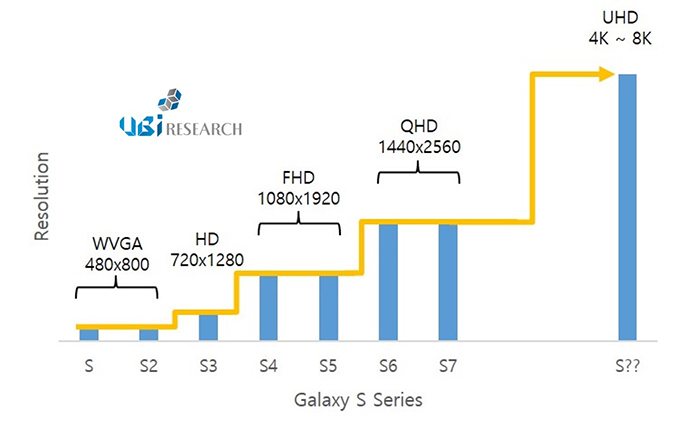
Galaxy S Series Resolution Increase Progress (Source = UBI Research ‘Analysis Report of Galaxy S Series’)
During this period, Samsung Electronics released products with diverse resolutions from Galaxy S’ WVGA to S6 and S7’s QHD through S3’s HD and S4 and S5’s FHD. With the exception of S3’s HD, Galaxy S Series resolution is moving forward every 2 years at present. If this speed of development continues, the Galaxy S8, expected to be released in 2017, could be equipped with screen size of mid-to-high 5 inch mark and resolution of 4K UHD.
UBI Research explained that Samsung Display’s 5.5 inch UHD 4K 806 ppi AMOLED for VR device that was shown in the recent SID 2016 has the same brightness as S7. He added that considering production yield, the display is expected to be used for Galaxy S8 to be released next year.

Samsung Launches TV PLUS Service in Thailand and Vietnam. (Source = Samsung Elec.)
Hyunjoo Kang / jjoo@olednet.com
Samsung Electronics today announced that its TV PLUS service is now available in Thailand and Vietnam on 2016 Samsung Smart TV UHD Models. All other Smart TV models, including Full HD Smart TVs, will be supported by the end of June. This service enables users to find exciting video clips by simply moving to designated channels, instead of having to toggle between different apps.
As a part of the TV PLUS upgrade, users in Thailand and Vietnam will automatically receive four popular Korean Pop channels of CJ E&M’s ‘Tving TV’ including Awesome Singers (Channel 101/555), KPOP Boy Group Stage (Channel 102/556), KPOP Girl Group Stage (Channel 103/557), and M Countdown (Channel 104/558). Further ahead in 2016, Samsung plans to collaborate with additional global and local content partners to expand the channels and variety offered on the service.
“We are thrilled to offer TV PLUS and exciting K-POP content to our users in Thailand and Vietnam,” said WonJin Lee, Executive Vice President of Visual Display Business at Samsung Electronics. “TV PLUS is a new kind of Smart TV service that creates a better user experience, and enables consumers to watch their favorite programming in a more integrated way. We are committed to continuing to develop and launch new services that meet the unique needs of our Smart TV owners.”
TV PLUS can be enjoyed by simply connecting an eligible Smart TV to the Internet through a LAN-line or Wi-Fi network. For those who have agreed to the Smart Hub terms of use, relevant software upgrades are automatically initiated once connected to the internet so consumers can use the service instantly and without the need for further installment or registration. Users with cable TV and IPTV can join the fun by selecting TV PLUS on their Smart Hub home screens.
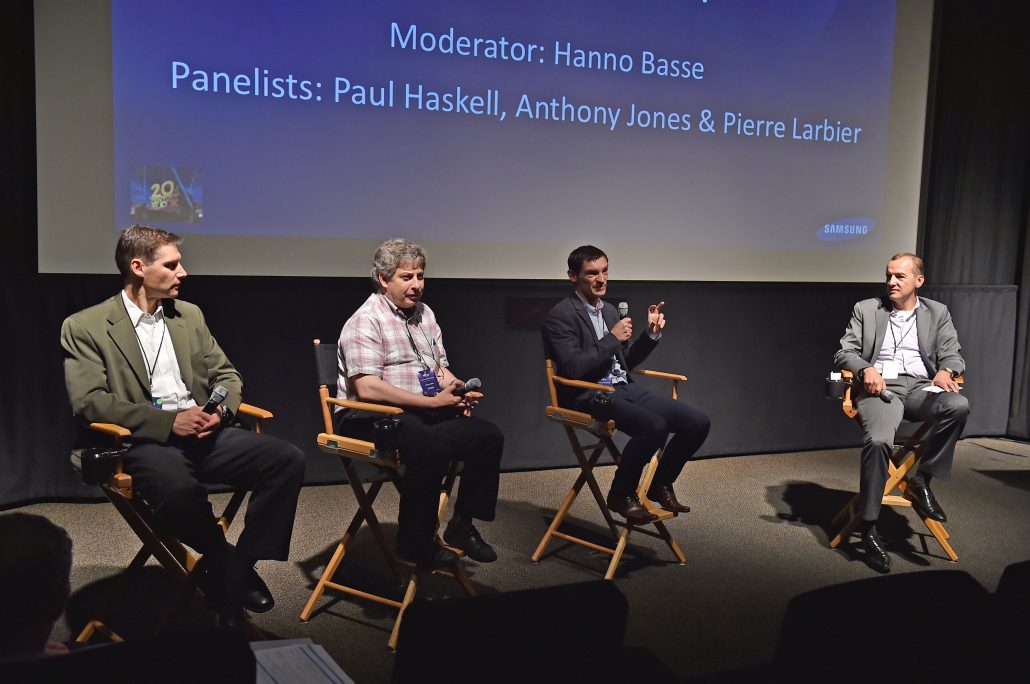
삼성전자는 Fox 와 기술 세미나를 열었다. (출처 = 삼성전자)
강현주 / jjoo@olednet.com
삼성전자가 현지시간 3일 미국 로스엔젤레스에서 20세기폭스(20th Century Fox )와 헐리우드 영상 전문가들을 초청해 HDR (High Dynamic Range) 기술 세미나를 개최하며, 차세대 영상 기술의 핵심인 HDR의 확산에 나섰다.
이날 세미나는 삼성전자와 20세기폭스가 함께 설립한 ‘폭스 이노베이션 랩 (Fox Innovation Lab)’에서 열렸으며, 20세기폭스를 비롯해 유니버설 스튜디오(Universal Studio), 워너 브라더스 (Warner Bros.) 등 헐리우드 스튜디오, Modern, eFilm, COMPANY3 등 헐리우드 대작 영화를 마스터링하는 전문 프로덕션 업체들의 컬러 리스트들과 영상기기 화질 전문가, TV 제조업체 엔지니어 등 100여 명이 참석했다.
올해 홈 엔터테인먼트 업계에서 가장 주목 받고 있는 화질 기술 HDR에 대한 최신 트렌드를 공유하고, 관련 기술 정보와 제작 노하우 등을 서로 나눴다.
세미나는 HDR 신기술 동향과 HDR 마스터링에 대한 전문가 패널 토론, HDR 작업을 위한 레퍼런스 디스플레이의 캘리브레이션 방법, HDR 10 방식의 코딩 효율성, HDR 기술의 발전 방향 등 다양한 세션으로 구성됐다.
특히, HDR 마스터링 전문가 세션에서는 컬러리스트와 포스트 프로덕션 전문가들이 자신들의 HDR 작업 노하우를 공유했다.
이들은 실제 헐리우드 스튜디오에서 제작하는 영화를 마스터링 작업할 때, 어떻게 장면마다 더욱 깊은 컬러의 디테일을 살려낼 수 있는지, 원작자가 표현하고자 하는 영상미를 최대한 끌어냈는지 등을 HDR 기술이 적용되지 않은 일반 영상과 비교해 가며 설명해 참석자들의 큰 관심을 모았다.
HDR 10 기술은 UHD 얼라이언스가 UHD 프리미엄 인증 표준 기술로 채택한 기술로, 오픈 스탠다드이기 때문에 누구나 사용할 수 있다.
또한 고효율 압축 코덱을 사용하기 때문에 영상 데이터 용량을 작게 하면서도 고화질 영상 정보를 손실 없이 전송할 수 있는 장점이 있다.
앞으로 HDR 10은 장면마다 최적화된 HDR을 적용해 보다 세밀한 영상을 제공하는 ‘다이나믹 메타 데이터 (Dynamic Meta Data)’ 처리 기술로 발전해 나갈 것으로 전망된다.
이번 세미나에서 HDR 기술로 제작한 콘텐츠 시연에는 삼성전자의 2016년형 퀀텀닷 디스플레이 SUHD TV가 사용됐다.
삼성전자 SUHD TV는 UHD 얼라이언스가 제시한 헐리우드 영화 콘텐츠 마스터링 환경의 기준인 1,000 니트 밝기까지 지원해 정확하게 화질을 조정에 참고하는 ‘레퍼런스 디스플레이’로 쓰이고 있다.
블록버스터 영화 ‘엑스맨’, ‘엑소더스’ 등 대작 영화들을 HDR 영상으로 제작한 세계적인 영상 컬러리스트 스테판 나카무라 (Stephen Makanura)는 이날 세미나에 참석해 “제대로 된 UHD 화질의 콘텐츠를 감상하기 위해서는 HDR이 핵심 요소이며, HDR 10 기술을 통해 더욱 실감나는 영상제작 방법을 공유하는 유익한 자리였다”고 전하며, “HDR 기술을 최대한 활용해 사람들이 감탄하며 즐길 수 있는 시각적으로 아름다운 영화 제작을 위해 힘쓸 것”라고 말했다.
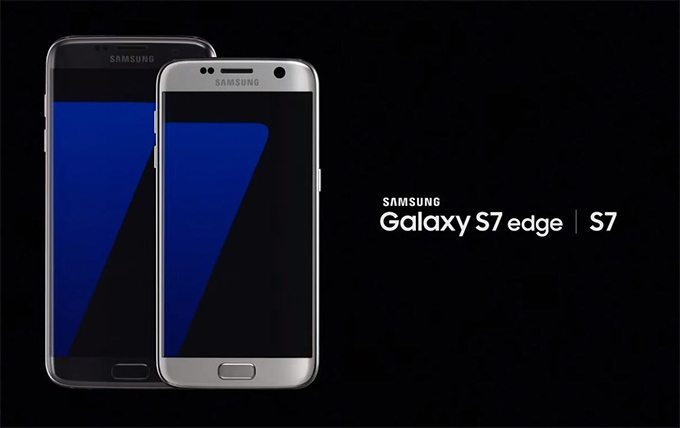
OLED 가 탑재된 갤럭시 S7 ( 출처 = 삼성전자 )
강현주 / jjoo@olednet.com
올해 1분기에 새로 출시된 OLED 디스플레이 탑재 기기들 중 스마트폰과 웨어러블 제품이 전분기나 전년동기 대비 두드러지게 증가한 것으로 나타났다. 반면 TV 부문은 LG전자의 신제품 외에는 소식이 없었다.
유비산업리서치가 조사한 바에 따르면 지난 1분기 글로벌 시장에서 새로 발표된 OLED 탑재 스마트폰 제품은 17개로 집계됐다. 이는 전분기 대비 4개 늘었으며 전년동기 대비 12개가 증가한 수치다. 그 중 삼성전자가 갤럭시 S7, S7 엣지를 포함해 4개의 스마트폰을 발표, 가장 많은 비중을 차지했다.
삼성에 이어 ZTE, 지오니(Gionee), 에이서, BLU가 각각 2개의 스마트폰 신제품을 발표했으며 비보( Vivo ), 하이센스( HiSense ), 콘카( Konka ), HP, 마이크로소프트가 1개씩을 발표했다. 이 중 중화권 업체가 6개나 된다.
1분기 OLED 탑재 웨어러블 신제품은 총 7개로 전분기 2개, 전년동기 4개 대비 늘었다. 소니, 오큘러스, HTC, 술론( Sulon )이 VR 신제품을 발표했으며 엡손( Epson )이 스마트 글래스를, 핏빗( Fitbit ), 인텍스( Intex )가 스마트밴드를 공개했다.
웨어러블 시장은 지난 2014년 2분기 스마트워치와 밴드를 제품을 중심으로 20개 이상의 신제품이 쏟아진 바 있으나 이후 기대보다 시장이 조용했다. 하지만 최근 VR과 스마트밴드 신제품들이 속속 출시되며 다시 활기를 띄는 분위기다.
OLED TV 시장은 LG의 독무대가 지속되고 있다. 1분기 OLED TV 신제품을 발표한 업체는 LG전자 뿐이며, 이 업체는 55인치~77인치까지 4개의 제품을 발표했다. 전년동기에는 하이어( Haier ), 창홍( Changhong ) 등 몇몇 중국 업체도 OLED TV를 내며 이 시장이 활기를 띄는 듯 했지만 이후에는 LG 외에는 조용하다. 이는 대형 패널의 아직 비싼 가격, 패널 공급 부족 등이 요인으로 분석된다. 2분기에는 중국의 Skyworth가 신제품을 발표했지만 판매는 기대에 못미치는 것으로 알려졌다.
업계 한 전문가는 “소형 OLED에 비해 대형 OLED는 아직 가격 경쟁력 등에서 개선돼야 할 부분이 있어서 중국 업체들 같은 후발주자들은 스마트폰에 비해 TV 부문에서의 채택이 더디다”라고 설명했다.
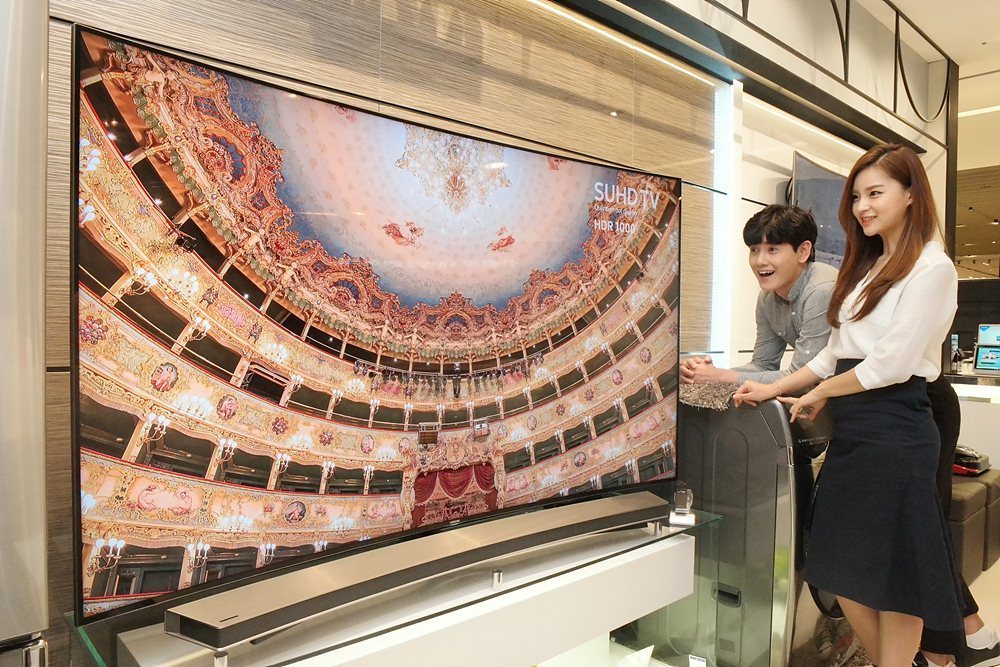
삼성전자가 퀀텀닷 SUHD TV 3종을 출시한다. (출처 = 삼성전자)
강현주 / jjoo@olednet.com
삼성전자는 퀀텀닷 디스플레이 SUHD TV 신제품 88형(223cm), 78형(198cm), 65형(163cm) KS9800 시리즈 3종을 출시한다고 30일 발표했다.
삼성전자는 최근 대형 TV를 찾는 소비자들의 선호에 맞춰 퀀텀닷 디스플레이 SUHD TV KS9800시리즈를 88형, 78형, 65형의 초대형 제품으로 출시한다.
이에 따라 삼성전자는 올해 퀀텀닷 디스플레이 제품을 49형(123cm)부터 88형까지 다양한 크기로 출시해 소비자 선택의 폭을 더욱 넓히게 된다.
올해 제품군은 △88형, 78형과 65형의 KS9800 시리즈, △78형, 65형과 55형(138cm)의 KS9500 시리즈, △65형, 55형과 49형의 KS8500 시리즈, △65형, 60형(152cm), 55형, 49형의 KS8000 시리즈로 다양하게 구성되어 소비자들이 필요에 맞춰 선택할 수 있다.
거실의 품격을 높여주는 고급스러운 디자인 KS9800와 KS9500, 현대적이고 모던한 디자인의 KS8500, KS8000 등 소비자 취향에 따른 디자인 선택의 폭 또한 더욱 넓어진다.
퀀텀닷 디스플레이 SUHD TV는 머리카락 굵기의 수 만분의 1에 불과한 나노 크기의 퀀텀닷 입자 하나 하나가 정확하고 순수한 색을 표현하며, 무기물 소재로 만들어져 오랜 시간 뛰어난 화질과 내구성을 자랑한다.
기존 TV보다 64배 많은 순도 높은 자연색을 보여주는 퀀텀닷 디스플레이 SUHD TV는 ‘HDR(High Dynamic Range) 1000’ 기술을 적용해 화면 밝기 1,000니트 기준의 프리미엄 UHD 영상을 왜곡없이 표현한다.
또 명암비를 획기적으로 개선시켜 어두운 부분에 감춰진 디테일 하나까지도 제대로 표현해주며, 눈부심 방지 패널로 반사광을 감소시켜 최상의 시청 환경을 제공한다.
또한, TV 리모컨 하나로 TV는 물론이고, 케이블 TV, IPTV, 인터넷 기반 동영상 서비스 등의 셋톱박스, 홈시어터, 블루레이 플레이어, 게임 콘솔 등 다양한 주변 기기들을 컨트롤 할 수 있는 획기적인 UX가 적용됐다.
새로운 UX를 통해 지금까지 기기 별로 별도의 리모컨을 구분해서 사용해야 했던 불편함에서 해방될 수 있게 됐다.
삼성전자 관계자는 “최근 대형 TV를 찾는 소비자들이 늘어남에 따라 대화면 신규 라인업을 통해 소비자의 니즈를 충족시키고자 한다”며, “앞으로도 TV 판매 10년 연속 세계 1위의 품질을 바탕으로 다양한 고객 취향에 맞춘 신모델을 지속적으로 선보일 예정이다”고 말했다.
삼성전자 ‘퀀텀닷 디스플레이 SUHD TV’ KS9800 시리즈 출고 가격은 88형 3,300만원, 78형 1,290만원, 65형 789만원이다.
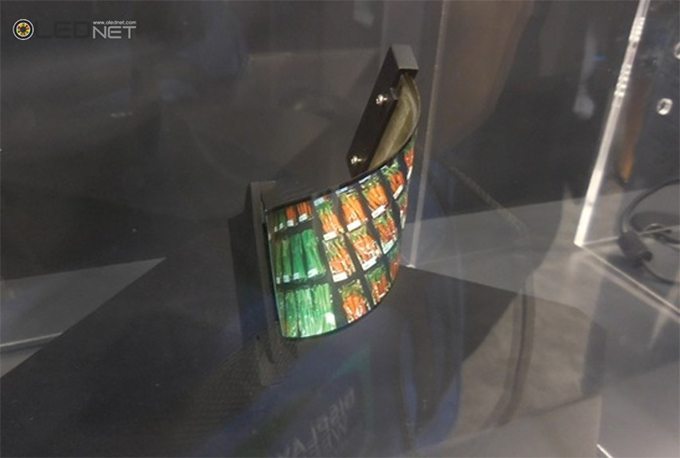
BOE 가 전시한 플렉서블 OLED(샌프란시스코=OLEDNET)
강현주 / jjoo@olednet
올해 ‘SID 2016’에서는 삼성디스플레이, LG디스플레이 뿐 아니라 BOE , 재팬디스플레이(JDI) , 티안마 등도 OLED를 선보여 한, 중, 일의 OLED 공세가 관심을 끌었다.
지난 5월 22일부터 27일까지 미국 샌프란시스코 모스콘 컨벤션센터에서 개최된 ‘SID(Society for Information Display, 국제 정보디스플레이 학회) 2016’에서 이 업체들은 스마트폰, VR, TV 등 다양한 기기를 위한 OLED 패널 신제품들을 대거 선보였다.
삼성디스플레이는 롤러블 패널 및 업계 최고 수치인 806ppi의 VR용 패널 및 블루파장을 최소화한 VR용 ‘바이오블루’ 등 다양한 5인치대 OLED 패널 신제품들을 전시하며 눈길을 끌었다.
LG디스플레이는 77인치 TV용 UHD OLED 패널, 사이니지용 55인치 양면 및 65인치 오목(Concave) OLED 등을 선보이며 대형 OLED 패널 최강자의 면모를 과시했다.
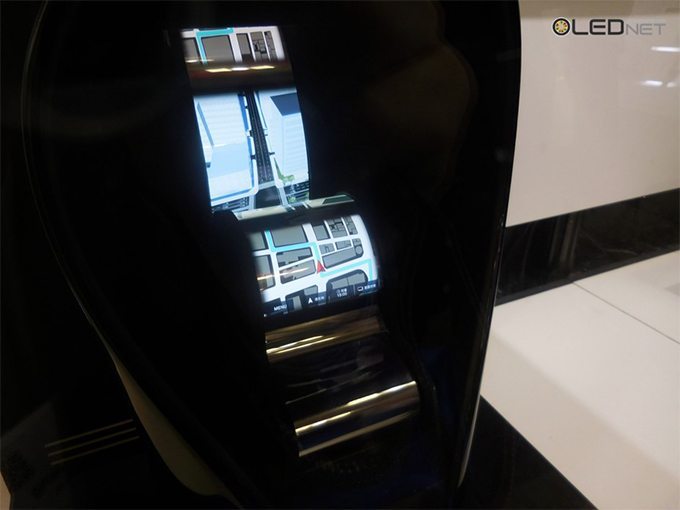
JDI가 전시한 플렉서블 OLED (샌프란시스코=OLEDNET)
BOE도 이번 전시에서 모바일용 플렉서블 OLED 디스플레이를 선보였다. 특히 4.35인치 폴더블 패널을 공개한 것은 이번이 처음이다. 이 제품은 5mm의 밴딩 반경(bending radius)을 갖췄으며 밝기는 350nit다.
티안마도 5.5인치 온셀터치 기술이 적용된 TFT-HD AMOLED 패널을 전시했다. 이 패널은 270ppi의 플렉서블 디스플레이로, 밴딩 반경은 20mm이다.
JDI는 플렉서블 플라스틱 OLED(POLED)를 전시했다. 5.2인치의 이 제품은 423ppi며 1080×1920의 해상도를 갖췄다.
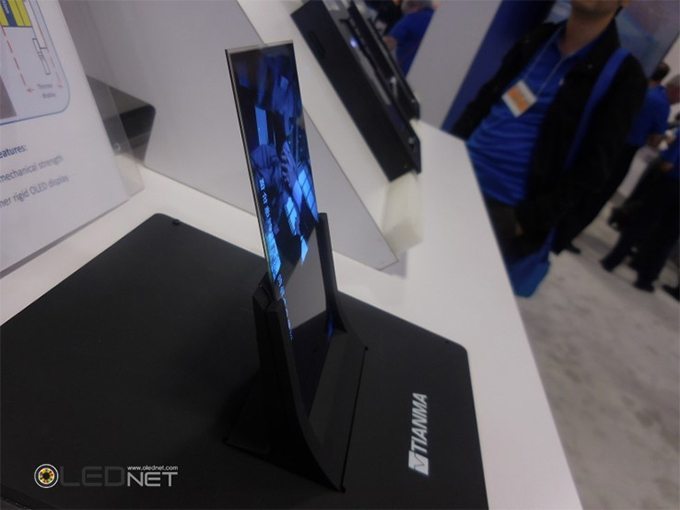
티안마가 전시한 모바일용 OLED(샌프란시스코=OLEDNET)
한편 이번 전시회에서는 OLED에 맞서 퀀텀닷 진영의 공세도 만만치 않았다.
나노시스와 QD비전은 OLED TV와 퀀텀닷 TV를 나란히 전시하며 퀀텀닷의 장점을 내세웠다.
QD비전에 따르면 퀀텀닷이 OLED보다 전력소모가 최대 50% 적다. 또 나노시스는 화이트OLED 패널 TV가 500니트의 밝기에 불과하지만 자사 퀀텀닷 기반 TV는1200nit를 구현한다고 강조했다.

삼성디스플레이가 SID 2016 에서 806ppi 의 VR 용 OLED 패널을 선보였다. (샌프란시스코 = OLEDNET)
강현주 /jjoo@olednet.com
삼성디스플레이가 5인치대 가상현실(VR) 기기용 디스플레이로는 업계 최고 수치인 806 ppi 패널을 공개해 눈길을 끈다. 또 눈에 해로운 블루 파장을 최소화 시킨 ‘바이오 블루’도 전시했다.
5월 22일부터 27일까지 미국 샌프란시스코 모스콘 컨벤션센터에서 개최되는 ‘ SID(Society for Information Display, 국제 정보디스플레이 학회) 2016’에서 삼성디스플레이는 VR용 OLED, 돌돌 말리는 롤러블 OLED 등 새로운 패널 제품들을 선보이며 참관객들의 관심을 모았다.
삼성디스플레이는 SID 2016 전시장 부스에서 5.5인치 VR 패널 신제품을 전시했다. 이 패널의 인치당 픽셀 수는 806ppi로 지금까지 공개된 5인치대 VR 패널 중 최고 높은 수치다. 해상도는 3840×2160이며 밝기는 306nit, 색역은 97%다.

삼성디스플레이가 SID 2016 에서 선보인 ‘바이오블루’ VR 용 패널 (샌프란시스코 = OLEDNET)
삼성디스플레이는 이와 함께 또 다른 VR용 OLED 패널 ‘바이오블루’를 선보였다. 바이오블루는 기존 RGB 픽셀구조에 라이트 블루를 추가하는 새로운 방식을 통해 눈에 해로운 블루파장을 최소화 시킨 패널이다.
삼성디스플레이는 바이오블루를 전시하며 LCD 에 비해 OLED 가 눈 건강에 좋다는 점을 강조했다. 전체 블루 스펙트럼 중 눈에 해로운 블루 라이트의 비중이 현재 LCD 는 66%며 AMOLED 는 그 절반인 32%다. AMOLED 는 향후 이를 6%까지 낮출 수 있다는 게 삼성디스플레이의 설명이다.
한편 삼성디스플레이는 이번 전시에서 5.7인치 롤러블, 노트북용 등 다양한 OLED 패널들을 대거 선보이며 모바일 OLED 세계 최강자의 면모를 과시했다.
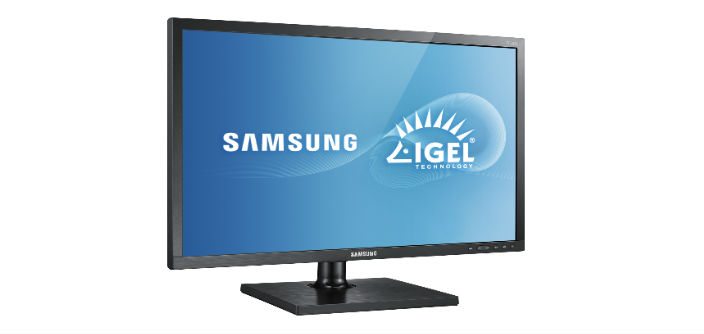
IGEL Monitor (Source = Samsung Elec.)
Hyunjoo Kang / jjoo@olednet.com
Samsung Electronics expanded its cloud monitor portfolio today with the release of the TC222L (21.5”) and the TC242L (23.5”) thin client displays. Powered by IGEL’s industry leading thin client software and combined with Samsung’s industry leading display technology, the new monitors offer businesses a highly unique desktop solution for remote access of critical documents and data through the cloud.
In partnership with IGEL, a leading global thin client vendor, Samsung’s TC222L and TC242L cloud monitors come with several embedded configuration, management and support tools. Both displays feature the Linux operating system, empowering remote network and internet program access. IGEL’s complementary Universal Management Suite 5 (UMS5) platform offers an easy-to-use console for added visibility of the clients’ configurations. The console also enables managers to automatically apply configuration adjustments to an entire deployment of thin client assets throughout the enterprise.
IGEL’s embedded software provides reliable multi-protocol connectivity to mainstream VDI environments and cloud resources, such as Citrix, VMware and Microsoft, added by a powerful management tool for remote configuration, monitoring, reporting and administrative automation. Through the integrated Linux Thin Client OS software platform, users can securely consolidate bulky desktop applications and equipment into a series of cloud-based virtual applications and desktops. The result is a sleek all-in-one design that minimizes cabling and consolidates I/O for a clean, clutter-free workspace.
“Businesses today need cutting-edge, cost-effective technologies that offer the flexibility to support remote operations yet safeguard against emerging data security threats,” said Seog-gi Kim, Senior Vice President, Visual Display Business at Samsung Electronics. “Our new TC222L and TC242L monitors bring the power, protection and capability of IGEL’s renowned remote automation tools to Samsung’s pioneering display technologies to create a cost-efficient, all-in-one solution for any business environment.”
“We are delighted about Samsung’s decision towards the best software solution provider on the market,” said Erhard Behnke, Managing Director at IGEL. “The Strategic partnership of Samsung and IGEL is a true win-win situation as Samsung will be enabled to deliver an innovative all-in-one thin client solution to their customers, and IGEL will benefit directly from the entrance into the enterprise display market. Combining our decades of experience in thin client software and management specialization with Samsung’s power in display technologies result in a secure, cost-effective and energy-efficient thin client solution.”
Samsung will showcase its TC222L and TC242L displays at the upcoming Citrix Synergy conference, taking place May 24-26 at the Sands Expo in Las Vegas.
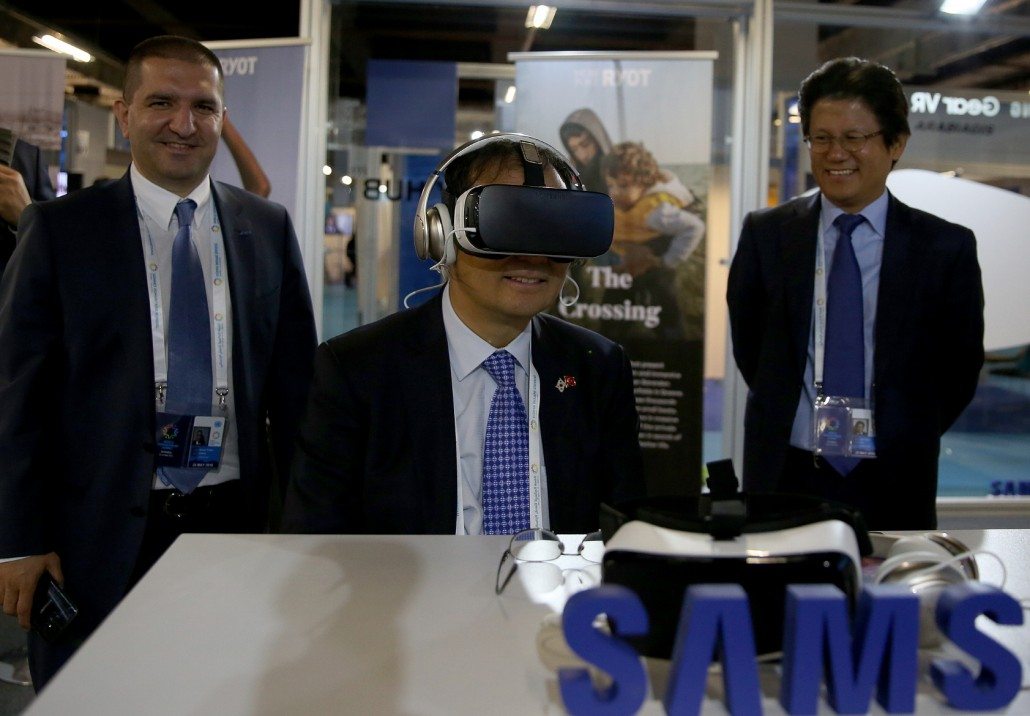
삼성전자가 WHS 에 VR 기기를 지원한다. (출처 = 삼성전자)
강현주 / jjoo@olednet.com
삼성전자가 세계 인도주의 정상회의에 VR 기기를 지원하고, 시리아 난민을 위해서는 초음파 기기를 지원한다.
삼성전자는 23일부터 24일까지(현지시간) 양일간 터키 이스탄불에서 터키 정부와유엔(UN)이 주관하는 제1회 ‘세계 인도주의 정상회의( WHS, World Humanitarian Summit )’에 참석했다.
삼성전자는 이 자리에서 유엔이 기어 360으로 제작한 휴머니즘 영상을 VR 기기를 통해 시연할 수 있도록 기어 VR과 갤럭시 노트5 등 제품을 지원했다.
유엔은 이를 통해 시리아 난민 위기와 기후 변화를 포함한 글로벌 세계 현안 과제를 보여주며 인도지원에 대한 인식 제고를 강조했다.
세계 인도주의 정상회의는 2차 대전 이래 최악의 난민 문제 발생 등 지속적으로 심화되는 인도적 위기를 해결하기 위해 유엔의 제안으로 개최한 인도적 지원분야 첫 정상회의다.
한편, 삼성전자는 터키 샨르우르파 지역의 시리아 난민과 시민을 위해 유엔인구기금과 총 15만 달러 상당의 초음파 기기를 지원하는 양해각서를 체결했다.
이번 사회공헌 활동을 통해 샨르우르파 지역 내 2만 여명의 임산부와 여성들이 의료 지원을 받을 예정이다.
김대현 삼성전자 터키법인장은 “삼성전자는 다양한 방법으로 지역사회 발전에 기여하고 있으며, 이번 유엔인구기금과의 협력을 통해 시리아 난민 여성들과 터키 시민에 첨단 의료서비스를 제공할 수 있게 됐다”며 “앞으로도 다양한 사회공헌 활동을 추진해 더욱 사랑 받는 기업이 되겠다”고 말했다.
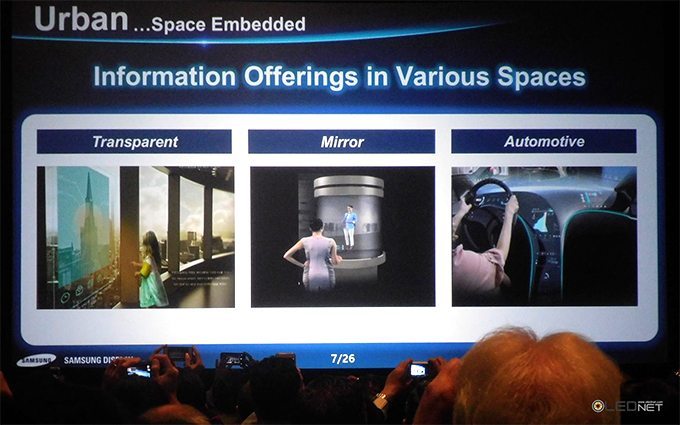
SID 2016 키노트세션. 김성철 부사장의 슬라이드 ( 샌프란시스코 = OLEDNET )
강현주 / jjoo@olednet.com
SID 2016 기조연설 연사로 선 삼성디스플레이( SDC )의 리서치 센터장인 김성철 부사장은 디스플레이는 자동차, 창문, 거울 등에 적용돼 인간 삶의 경험을 더 확장해주며 AMOLED 가 이를 위한 주요 솔루션이 될 것이라고 강조했다.
김성철 부사장은 5월 22일부터 27일까지 미국 샌프란시스코 모스콘 컨벤션센터( Moscone Convention Center ) 에서 개최되는 ‘ SID ( Society for Information Display, 국제 정보디스플레이 학회 ) 2016 ’ 의 키노트 세션에서 디스플레이 관련 기술 이슈 및 AMOLED 의 강점들을 설명했다.
김 부사장은 특히 ‘플렉서블’에 적합한 AMOLED 의 특성을 내세웠다.
평소에는 벽이나 창문으로 있다가 때로는 정보판이 되는 디스플레이는 유연성( flexibility )과 딱딱함( hardness )이 동시에 필요하다. 또 자동차 내에 적용되는 디스플레이는 ‘곡면의( curved ) 세상’이라는 게 그의 설명이다. 거울용 디스플레이의 경우 뛰어난 색의 영역( gamut )이 요구되므로 AMOLED 가 이에 적합하다.
김 부사장은 또 VR 등에 필요한 현실감 있는 이미지를 위해서는 구동회로 기술력이 요구된다는 점도 언급했다.
그는 “접히고( Foldable ) 돌돌말 수 있고( rollable ) 변형되고( deformable ) 펼칠 수 있는( stretchable ) 디스플레이는 기기들을 더 매력적으로 만들어 줄 것이며 가상현실( VR ), 자동차, 디지털사이니지 등을 통해 새로운 경험을 제공할 것”이라고 말했다.
김 부사장은 “디스플레이는 세계와 소통하는 창이며 우리의 삶을 확장해 준다”며 “AMOLED 는 미래 디스플레이의 주요 솔루션이며 AMOLED 는 생각보다 많은 기회를 가져다 줄 것”이라고 강조했다.
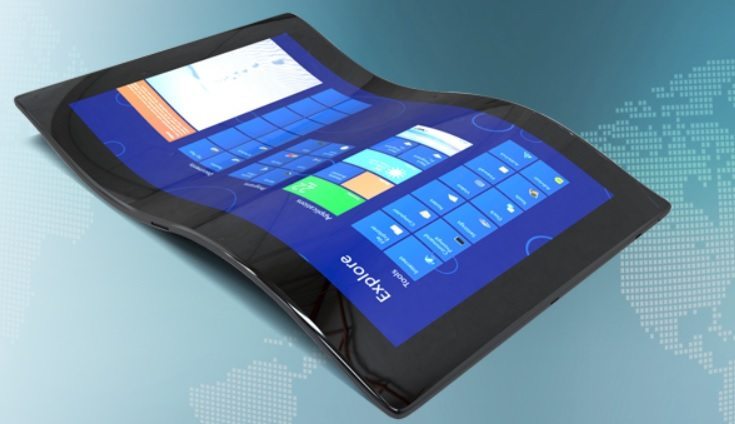
출처 = ICD
강현주 / jjoo@olednet.com
반도체용 기계 제조사인 아이씨디( ICD )가 23일 삼성디스플레이에 80억원 규모의 AMOLED 제조장비를 공급하기로 계약했다고 공시했다.
이번 계약금액은 약 80억3천900만원이며, 계약기간은 9월 30일까지다.
아이씨디는 자체 생산으로 해당 장비를 공급할 계획이다.

moscow 에 설치된 초대형 갤럭시 S7 모양 사이니지(출처: 삼성전자)
강현주 / jjoo@olednet.com
삼성전자가 지난 4월 부터 모스크바( Moscow ) 시내에 ‘갤럭시 S7’ 형태의 가로 48m, 세로 80m에 달하는 초대형 LED 사이니지를 선보였다.
‘갤럭시 S7’ 초대형 LED 사이니지가 설치된 지역은 모스크바 시내와 쉐르메티예보 공항이 이어지는 요간선도로가 놓여진 교통의 요충지다. 일일 통행인구수는 약 80만 명에 이른다.

SID 2016 에 전시된 삼성디스플레이의 롤러블 AMOLED(출처=삼성디스플레이)
강현주 / jjoo@olednet.com
삼성디스플레이와 LG디스플레이가 5월 22일부터 27일까지 미국 샌프란시스코 모스콘 컨벤션센터(Moscone Convention Center)에서 개최되는 ‘ SID (Society for Information Display, 국제 정보디스플레이 학회) 2016 ’ 에 참가, 차세대 디스플레이 제품을 대거 공개하며 기술력을 과시한다.
LG디스플레이는 별도의 부스를 마련하고 OLED TV, IT, Mobile, Auto 등 각각의 Zone을 운영하며 화질, 응용 범위, 디자인 등에 있어서 OLED의 장점을 강조한다.
이 회사는 77인치 TV용 UHD OLED 패널을 전시한다. 이 제품은 영화 편집 시 사용되는 전문가용 제품과 동등 수준의 색재현율을 구현하며, OLED만의 완벽한 블랙과 향상된 휘도로 HDR 기술이 적용됐다.
LG디스플레이는 사이니지용 55인치 양면 및 65인치 오목(Concave) OLED 등도 전시할 예정이다.
LG디스플레이는 “실물과 다름없는 화질”이라며31.5인치 8K4K모니터와 14인치UHD 노트북 패널을 비롯해 IT, Mobile, Auto 제품에서도 고해상도 및 터치 등의 기술력을 선보인다.
삼성디스플레이는 5.7인치 롤러블(Rollable) AMOLED와 노트PC, VR, 차량용 AMOLED부터 홀로그램까지 최첨단 디스플레이들을 대거 공개하고 기조강연에서는 미래 디스플레이의 비전을 제시한다.
롤러블 AMOLED는 롤스크린TV나 화면 확장형 태블릿 등에 활용될 수 있다. 이번에 삼성 부스에서 전시되는 5.7형 플렉서블 AMOLED는 업계 최고 해상도인 QHD(2560×1440)에 두께는 0.3mm인 초박형이다.
손가락 굵기로 말 수 있는 5.7형 롤러블(Rollable) AMOLED는 두께 0.3mm, 무게 5g이다. 풀HD(1920×1080), 곡률반경은 10R(10mm의 반지름을 가진 원의 휘어진 정도)로 지금까지 공개된 롤러블 제품 중 해상도와 곡률 면에서 가장 뛰어난 사양이라는 게 이 회사의 설명이다.
노트PC용 13.3형과 14형 QHD AMOLED는 터치센서를 AMOLED 패널에 내장하는 On Cell 터치 방식을 도입해, 두께는 LCD 대비 45% 줄어든 1.01mm, 무게는 33% 감소한 120g(13.3형 기준)을 구현했다. 삼성디스플레이는 VR용 5.5형 UHD(3840×2160, 806ppi)의 시제품도 선보였다. 픽셀수가 현재 주로 쓰이는 QHD보다 약 2.3배 높아졌다.
삼성디스플레이는 발전된 LCD도 선보인다. 65형 UHD 블랙크리스탈 제품은 삼성디스플레이의 VA기술을 활용해, 명암비를 6천대 1까지 높이고, 화면 반사율은 2.3%로 크게 낮춰 보급형 제품에서 HDR 구현이 가능하다. 또한 두께가 5.9mm로 얇으면서도 커브드 디자인을 동시에 구현한 65형 UHD 커브드 슬림 제품도 함께 전시한다.
삼성은 SF영화에 자주 등장하는 입체 영상 관련 ‘라이트 필드’ 기술도 선보인다. 이 기술은 보는 사람의 위치에 따라 조금씩 다르게 보이는 실물의 모습을 디스플레이에서 구현해, 완성도 높은 3차원 영상을 표현한다. 또한 3차원 공간에 입체 영상을 구현할 수 있는 디지털 홀로그램 기술도 전시한다. 빛의 간섭성을 활용해 볼륨있는 3차원 이미지를 공간에 띄워 동영상도 구현할 수 있다. 이 기술들은 앞으로 3D팝업북, 3D게임, VR, AR, HUD 등에 활용될 수 있다.
◆양사 모두 차량용 OLED 기술 과시
LG는 자동차용 AMOLED 코너에서 향후 HUD(헤드업디스플레이)와 룸미러 등에 활용이 기대되는 투명·미러 AMOLED를 비롯해 자동차 계기판을 형상화한 AMOLED 제품이 함께 전시된다. AMOLED는 운전자의 눈 피로도를 줄이고 시인성을 높이며 향후 입체적인 디자인도 가능하다고 LG는 강조한다.
삼성 역시 자동차용 플라스틱 올레드를 적용한 12.3인치 커브드 디스플레이, 고해상도와 1,000 니트 이상의 고휘도를 구현하는 12.3인치 등 중앙정보디스플레이(Center Information Display)에서 계기판(Cluster)까지 다양한 라인업을 선보인다.
한편 SID 2016 기조강연에서는 김성철 삼성디스플레이 연구소장(부사장)이 ‘AMOLED 디스플레이의 미래와 기술적 과제’라는 주제로 강연을 펼친다.

Samsung Amplifies Partnership with Fox (Sorce : Samsung)
Hyunjoo Kang / jjoo@olednet.com
Samsung Electronics unveiled today a shared vision with 20th Century Fox to further elevate the consumer viewing experience, and the TV industry at large.
A new video released by the company highlights its longstanding partnership with industry leading film studio and underlines the importance of TV in today’s larger content ecosystem, featuring executives from both Samsung and Fox who share their collective vision for the future.
The partnership between Samsung and Fox began in 2013, when Samsung joined the Secure Content Storage Association (SCSA) — a consortium of companies in the entertainment and storage space that aim to provide consumers with new ways to access high-quality digital programming across devices — and did so with the backing of Fox. Samsung has since launched a UHD download service with Fox content, as well as an expanded service that includes High Dynamic Range (HDR) titles, which is available to consumers globally.
“Our goal is to offer the best consumer experience while preserving the filmmaker’s intent with no distortion, no compromises,” said Won Jin Lee, executive vice president, service business team, visual display at Samsung Electronics. “We are answering industry, market and user demand with this continued partnership.”
In 2014, Samsung launched its first ever branded “Video Pack” that provided users with five titles licensed by the studio. That same year, Samsung and Fox established the Fox Innovation Lab, with the first project integrating accessible content into Samsung’s Ultra High Definition (UHD) TVs.
“We share a common goal of delivering the best user experience at home,” said Won Jin Lee. “Our complimentary skill sets have helped us continuously raise the bar for ourselves, as well as the industry.”
In 2015, they co-announced the UHD Alliance — a coalition of companies united to set the bar for next generation video entertainment by establishing standards to support innovation in video technologies. The Alliance is dedicated to furthering this commitment in 2016 and beyond.
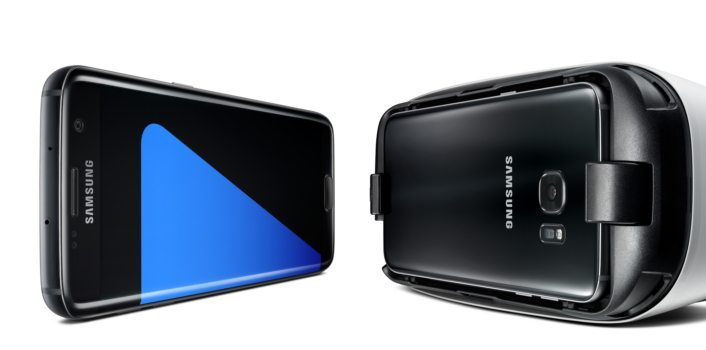
Gear VR (Source = Samsung Elec.)
Hyunjoo Kang / jjoo@olednet.com
Following record pre-orders in Europe for the Galaxy S7 and S7 edge, Samsung Electronics Europe today announced an exclusive Gear VR content package for new Galaxy S7 customers.
For a limited period only*, new Galaxy S7 and S7 edge customers in Europe will be able to purchase the Samsung Gear VR, powered by Oculus, at a special price and get free access to exclusive premium games and experiences, available from the Oculus Store. The bundle includes some of the Oculus Store’s most popular paid-for content, such as Anshar Wars 2, Darknet, Drift, Keep Talking and Nobody Explodes, Ocean Rift and Starchart.
This new reward, in partnership with Oculus, the pioneering virtual reality firm that helps to power the Gear VR, comes as the Galaxy S7 and S7 edge continue to perform strongly across Europe. This strong Galaxy S7 performance has also driven an upsurge of adoption in the mobile VR market in Europe. According to CCS Insight**, the Western European VR market is expected to grow 168% year-on-year in 2016. Samsung has already sold over 300,000 Gear VR headsets in Europe this year, a significant figure given that CCS Insight** estimates that the total number of VR devices sold in Europe last year was 1.8mn.
David Lowes, Chief Marketing Officer, Samsung Electronics Europe, commented: “Our Galaxy S7 and S7 edge are performing extremely well, demonstrating continued strong demand for our premium flagship devices. The smartphone is already so fundamental to our lives but connecting it with a product like the Gear VR opens up incredible new experiences that are often as emotional as they are immersive. With this new incentive, we’re encouraging broader VR adoption so that more people can experience this amazing new technology for themselves.”
“At Oculus, we want people to experience anything, anywhere through the power of virtual reality and we’re starting to see that happen with Gear VR,” said Max Cohen, Head of Mobile at Oculus. “We recently announced that one million people used Gear VR in April – this is an important milestone, which speaks to the great experience that Samsung and Oculus can deliver. Together, the hardware and software provides the absolute best VR experience on mobile available today and we’re looking forward to continuing to excite and engage European consumers.”
Industry analyst house CCS Insight forecasts that revenues for VR headsets globally will reach $10bn by 2020, with Western Europe accounting for $3bn. 4.7mn headsets are expected to be shipped in Western Europe in 2016, with value-priced smartphone VR headsets such as the Gear VR expected to account for 90% of the volume.
Ben Wood, Chief of Research at CCS Insight, noted: “We are at the beginning of an exciting journey with VR. We believe consumers will be keen to experience the wealth of professionally curated 360-degree content that will emerge in 2016. Furthermore, the growth in self-created content generated by the growing number of 360-degree cameras and shared via Facebook and YouTube will only serve to take awareness levels to new heights as the year progresses.”
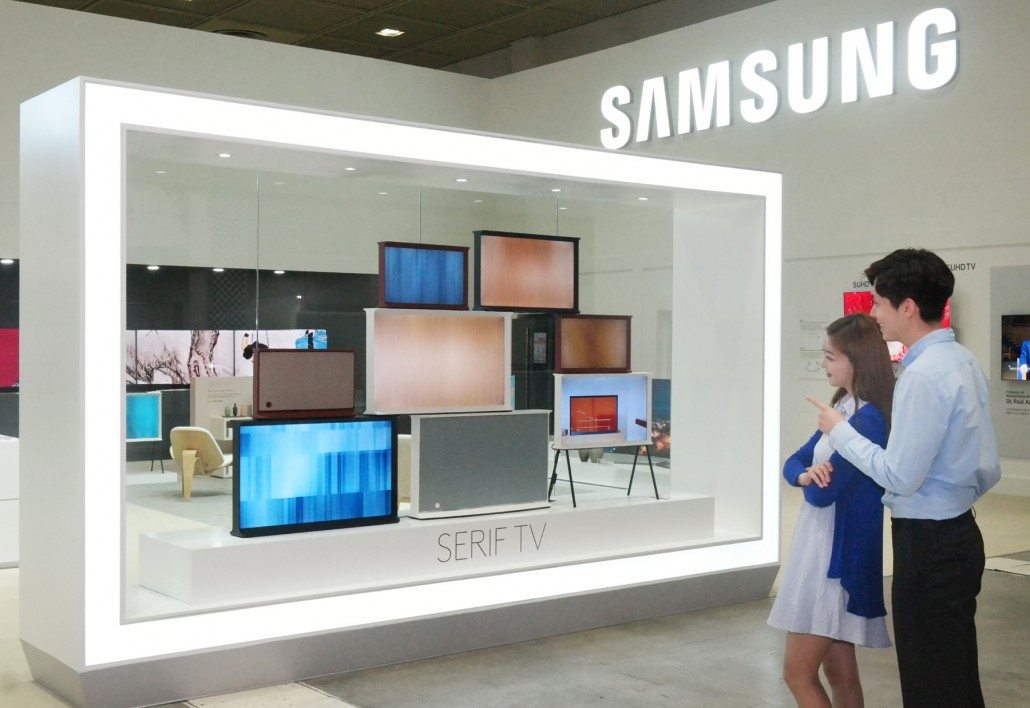
Source = SAMSUNG Elec.
강현주 / jjoo@olednet.com
삼성전자( Samsung Elec.)가 17일부터 20일까지 서울 코엑스에서 열리는 월드IT쇼 2016(World IT Show 2016)에서 ‘갤럭시 S7 엣지’, ‘갤럭시 S7’, ‘기어360’, ‘기어 VR’, ‘퀀텀닷 디스플레이 SUHD TV’, 감각적인 디자인의 ‘세리프TV(Serif TV)’, ‘패밀리 허브’, ‘노트북9’ 등의 제품을 관람객들이 직접 체험해 볼 수 있도록 전시했다.
Samsung Elec.은 저조도 환경에서도 밝고 선명한 사진을 담을 수 있는 ‘갤럭시 S7 엣지’, ‘갤럭시 S7’의 카메라 기능을 비교 체험할 수 있게 구성했다. 또한 관람객들이 직접 물 속에 제품을 넣어보는 방수기능, 게임을 편리하고 몰입감 있게 즐길 수 있도록 해주는 ‘게임 런처’, ‘게임 툴즈’ 기능도 직접 경험할 수 있도록 전시 공간을 마련했다.
최근 주목 받고 있는 가상현실(VR) 관련 제품 전시도 특화했다. 관람객들은 ‘기어 360’으로 직접 상하좌우 360도 모든 공간을 촬영해 볼 수 있으며, ‘기어 VR’을 통해 에버랜드가 새롭게 선보인 판다월드를 보다 생생하고 실감나게 경험해 볼 수 있다.
‘갤럭시 S7’의 특화된 카메라 기능을 더욱 흥미롭게 만나볼 수 있는 이색적인 전시 공간도 운영한다. ‘갤럭시 S7’으로 세계적 현대무용단 네덜란드 댄스 시어터 무용수들의 아름다운 퍼포먼스를 담은 예술사진 전시와 전문 포토그래퍼들과 20대 소비자들이 서울, 진해, 광주, 전주, 부산, 대구, 울산, 춘천, 제주, 캠퍼스 등 전국 곳곳에서 촬영한 ‘♥7 Day & Night with S7’ 사진전의 작품도 감상할 수 있다.
삼성전자는 지난 3월 국내에 출시한 이후 소비자들의 큰 호응을 얻고 있는 ‘퀀텀닷 디스플레이 SUHD TV’와 세계적인 가구 디자이너 로낭&에르완 부훌렉 형제가 디자인한 가구 같은 TV ‘삼성 세리프 TV’를 함께 전시했다.
퀀텀닷 디스플레이 SUHD TV는 순도 높은 자연색을 정확하게 표현해 주는 장점뿐만 아니라 오랜 시간이 지나도 순수한 색과 빛을 잃지 않는 내구성까지 갖춘 제품이다. 빛 속에 속에 숨어 있는 다양한 자연 그대로의 컬러들을 표현할 뿐 아니라 빛과 그림자 속에 가려진 디테일까지도 제대로 표현하는 ‘HDR 1000’도 지원한다.
특히, ‘퀀텀닷 디스플레이 SUHD TV’의 뛰어난 화질을 4K UHD 영상으로 제작된 간송 문화전, 에버랜드 판다 영상 등을 통해 생생하게 감상할 수 있다.
리모콘 하나로 공중파 방송, 케이블 TV, IPTV, 인터넷 기반 동영상 서비스 등 다양한 TV 사용 환경을 한 화면에 통합해 빠르고 쉽게 찾아 즐기는 스마트 TV 기능도 바로 확인해 볼 수 있다.
삼성전자는 실제 거실 공간을 마련해 품격 있는 인테리어 오브제로서 TV 디자인을 소개했다. 뒷면에 불필요한 나사구멍을 없애고 복잡한 단자들을 정리할 수 있는 커버를 도입해 어느 각도에서나 깔끔한 360도 디자인을 자랑하는 ‘퀀텀닷 디스플레이 SUHD TV’와 감각적인 디자인의 ‘삼성 세리프TV’가 관람객들의 시선을 사로잡았다.
하나의 가구처럼 어느 공간에나 자연스럽게 어울리는 ‘삼성 세리프TV는’ 이음새 하나 없이 만들어진 프레임, 패브릭으로 처리된 뒷면과 스마트 기능을 감각적으로 표현해 주는 세리프 TV만의 ‘커튼모드’ UI 등으로 트렌디한 감성을 표현했다.
삼성전자는 지난 1월 미국 라스베이거스에서 열린 ‘CES 2016’에서 ‘CES 혁신상’을 수상한 삼성 ‘패밀리 허브’도 전시했다.
이번 전시회에서는 ‘패밀리 허브’와 스마트 TV와 ‘갤럭시 S7’과의 연동을 통해 주방에서도 TV 화면을 실시간으로 볼 수 있는 ‘키친 TV’와 스마트폰으로 냉장고 내부를 볼 수 있는 ‘푸드 알리미’ 기능을 보다 생생하게 경험할 수 있다.
국내 PC 시장에서 22년 연속 시장점유율 1위를 자랑하는 삼성전자는 ‘노트북 9 메탈(metal)’ 아이언 실버, 미네랄 화이트 모델과 ‘노트북 9 스핀(spin)’ 등을 전시했다. 최신형 초경량 인기 모델인 노트북 9 메탈 900X3L은 저울로 가벼운 무게를 체험할 수 있는 이벤트도 진행한다.
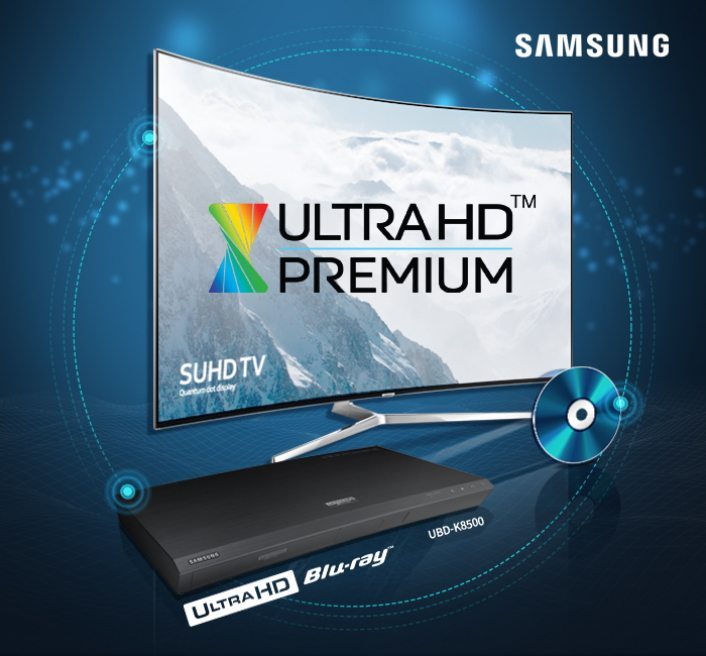
Samsung`s UHD Blu-ray player(Source=Samsung)
Hyunjoo Kang / Reporter / jjoo@olednet.com
Samsung Electronics announced today that its UBD-K8500 UHD Blu-ray player has been certified as ‘UHD Premium’ by the UHD Alliance (UHDA). Now a part of Samsung’s total UHD ecosystem, the UBD-K8500 joins the 2016 Samsung SUHD TV lineup in UHDA Premium Certifications.
Samsung’s recently released HDR-compatible UBD-K8500 offers four times the resolution and 64 times higher color expression than conventional Blu-ray players. When paired with Samsung SUHD TV’s Quantum Dot Display, the UBD-K8500 delivers a level of picture quality never before seen in the home. Its built-in upscaling technology enhances the picture quality from standard Blu-ray discs and DVDs.
The UBD-K8500 was tested to see if it could precisely read all of the information on a Blu-ray disc, which also bears the UHDA Premium logo, and reproduce what exactly is needed to meet true premium UHD picture quality. Moving forward, ULTRA HD PREMIUM logo from the UHDA will be included on all Samsung Ultra Blu-ray players to help consumers easily identify premium technologies and choose products with confidence.
“We are thrilled that the Samsung UBD-K8500 Ultra HD Blu-ray player has received the Premium Certification from the UHDA, and even more thrilled to offer our consumers a complete premium UHD home entertainment experience through the Samsung Ultra HD Blu-ray player and the 2016 SUHD TV lineup” said John JY KIM, Vice President of AV Product Marketing Group at Samsung. “Thanks to the industry’s continued focus on growing the UHD ecosystem to the fullest, consumers can expect more premium options with the best picture quality available – all at the comfort of their homes.”
As a trusted authority in UHD picture quality, the UHDA Premium Certification is designed to help consumers identify televisions, content and now playback devices that are capable of delivering a premium viewing experience at home. The certification is reserved for products, content and services that align with the rigorous performance metrics set by the UHDA for resolution, high dynamic range, peak luminance, black levels and wide color gamut.
The UHDA’s Premium Certification was adopted to TV products and UHD contents, but has now expanded to include Ultra HD Blu-ray players. Inclusion in this prestigious certification marks a meaningful step forward for Ultra HD Blu-ray players as it insures exacting video specifications are met to insure the players video output signal maintains artistic intent.
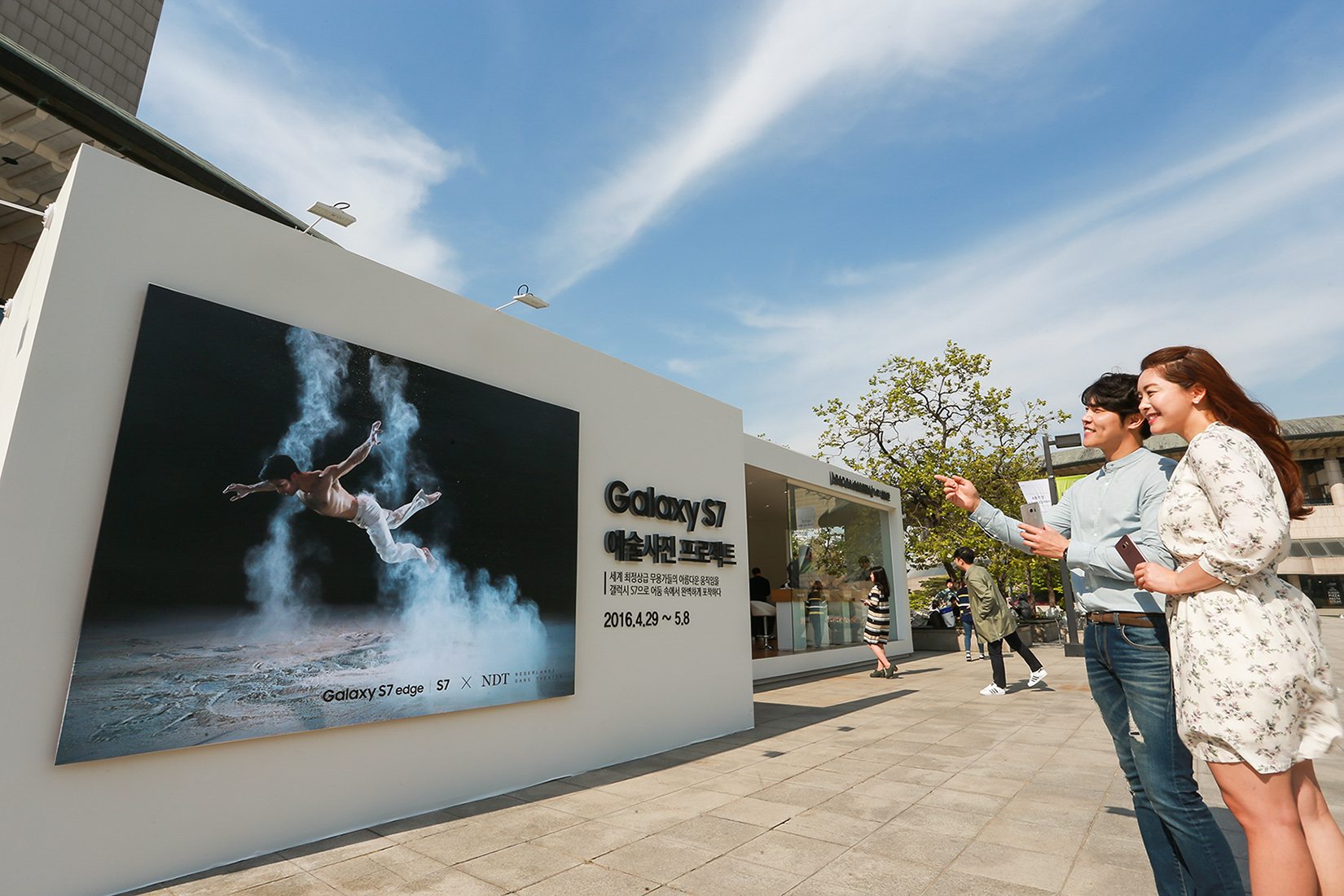
삼성전자가 Galaxy S7과 기어 VR 로 즐기는 문화예술 갤러리를 운영한다(출처=삼성전자)
강현주 기자 / jjoo@olednet.com
삼성전자가 예술의전당과 함께 갤럭시 S7, 기어 VR 로 즐기는 문화 예술 갤러리를 운영한다.
8일까지 예술의전당 음악광장에서 진행되는 이번 갤러리는 ‘갤럭시 S7 예술 사진 갤러리’, ‘예술의전당 VR 컨텐츠 체험존’ 등 최첨단 IT 제품에 예술 컨텐츠를 더해 구성됐다.
지난 달 신사동 가로수길 팝업 갤러리에서 진행된 전시에 이어 두 번째로 예술의전당에서 진행되는 ‘갤럭시 S7 예술사진 갤러리’는 세계적인 무용단 네덜란드 댄스 시어터(Nederlands Dans Theater) 와 협업했다.
이번에 전시된 작품은 역동적인 무용수들의 아름다운 퍼포먼스를 듀얼 픽셀 이미지 센서와 F1.7렌즈가 탑재된 ‘갤럭시 S7’로 촬영했다.
또한, 지난 4월 예술의전당에서 시연된 다양한 문화 컨텐츠를 ‘기어 VR’로 생생하게 체험할 수 있는 ‘SAC(Seoul Arts Center) on Screen VR 체험관’도 운영된다.
체험관에서 관람객들은 기어 VR로 웅장한 오케스트라와 서예박물관 등 공연장과 전시 현장에 실제로 있는 것과 같은 가상 체험이 가능하며 ‘갤럭시 S7’, ‘기어 360’, ‘기어 VR’ 등 최신 IT 제품도 경험할 수 있다.
지난 29일 출시된 ‘기어 360’은 제품 앞뒤에 탑재된 2개의 어안 렌즈로 상하좌우 360 도의 모든 공간을 촬영할 수 있는 기기이다.
특히, 듀얼 이미지 센서를 사용해 UHD급(3840×1920)의 고해상도 동영상 촬영과 최대 3천만 화소의 사진 촬영이 가능하며, F2.0의 렌즈를 탑재해 저조도에서 보다 밝고 선명한 화질의 영상과 사진 촬영이 가능하다.
삼성전자 관계자는 “최신 IT기기를 통해 예술 컨텐츠를 즐기는 방식이 더욱 다양해 질 것”이라며 “앞으로도 다양한 협업을 통해 소비자들의 흥미를 끌 수 있는 마케팅을 운영해나갈 계획”이라고 말했다.
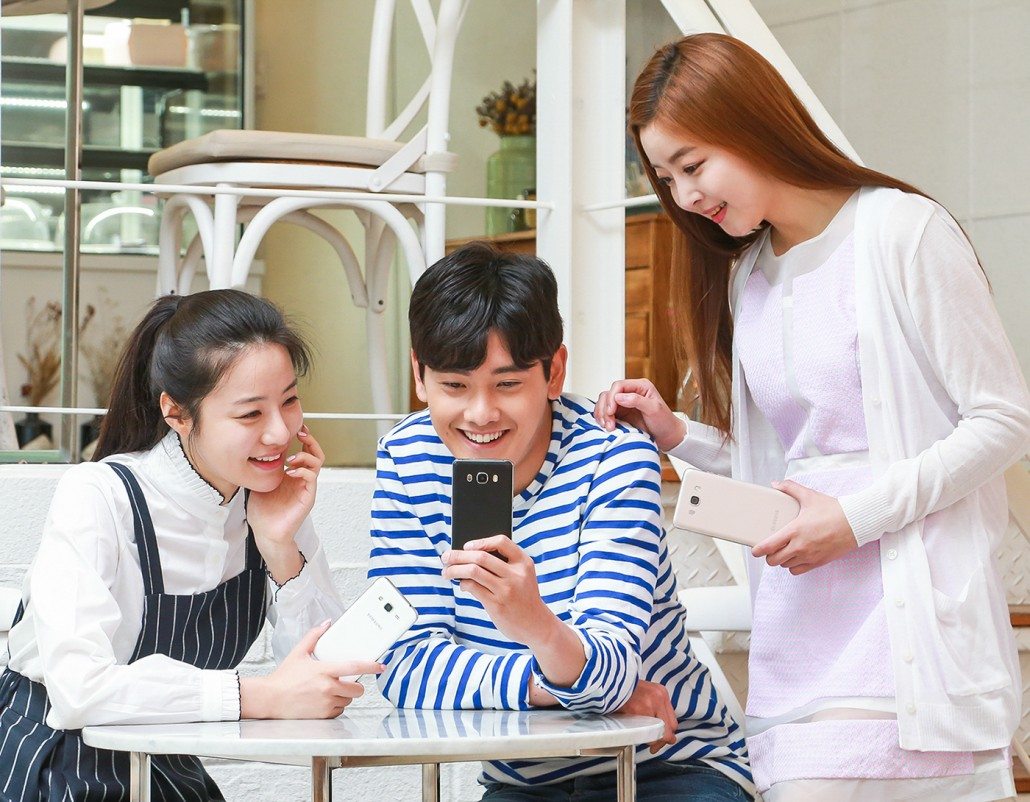
galaxy J 시리즈(출시=삼성전자)
강현주 기자 / jjoo@olednet.com
삼성전자가 2016년 형 ‘갤럭시 J( galaxy J )’ 시리즈를 29일 한국에 출시했다.
통신 3사를 통해 출시되는 ‘갤럭시 J5’는 블랙ㆍ화이트 두 모델, KT로 출시되는 ‘갤럭시 J7’은 블랙ㆍ골드 두 모델이며 가격은 각각 29만7천원과 36만3천원이다.
강력한 성능과 합리적인 가격을 자랑하는 2016년형 ‘갤럭시 J’ 시리즈는 감각적인 디자인에 대화면 디스플레와 메탈 프레임 적용했다. 5.2형(131.8mm)의 ‘갤럭시 J5’, 5.5형(139.5mm)의 ‘갤럭시 J7’은 슈퍼 아몰레드 디스플레이를 장착해 보다 선명하고 생생하게 멀티미디어 콘텐츠를 즐길 수 있다.
특히, ‘갤럭시 J5’는 전작(126.3mm)보다 커진 화면으로 사용 편의성을 높였다. 2016년형 ‘갤럭시 J5’와 ‘갤럭시 J7’은 카메라 기능이 한층 업그레이드됐다.
전면 500만 화소, 후면 1300만 화소의 카메라를 장착했으며, 전후면 모두 조리개값 F1.9 렌즈를 채용해 저조도 환경에서도 밝고 또렷한 사진 촬영이 가능하다. 또한, 전면에 LED 플래시를 적용해 어두운 곳에서도 화사하고 자연스러운 셀피 촬영을 할 수 있고,
화각을 120° 까지 넓혀주는 ‘와이드 셀피’, 손바닥을 펴는 동작으로 사진 촬영을 하는 ‘팜 셀피’, 단계별로 피부 톤과 눈 크기, 얼굴형을 설정할 수 있는 ‘뷰티 효과’ 등 다양한 셀피 효과를 지원한다.
‘갤럭시 J’ 시리즈는 홈 버튼을 더블 클릭하면 1초 이내에 카메라가 실행되는 ‘퀵 카메라’ 기능을 탑재했다.
‘갤럭시 J5’와 ‘갤럭시 J7’은 외장 메모리 슬롯을 지원해 용량 확장이 가능하며 각각 3,100mAh와 3,300mAh로 동급 최대 용량의 착탈식 배터리를 적용했다.
‘갤럭시 J3’도 곧 출시될 예정이다. 화이트 색상의 2016년형 ‘갤럭시 J3’는 5형(126.3mm) 슈퍼 아몰레드 디스플레이와 후면 800만 화소 카메라를 장착했다.
삼성전자 관계자는 “2016년 새롭게 출시되는 ‘갤럭시 J’ 시리즈는 실용적이고 강력한 기능과 합리적인 가격을 모두 갖춰 가성비를 극대화한 제품”이라며, “앞으로도 소비자들의 다양한 취향을 만족시킬 수 있는 차별화된 라인업을 선보일 계획”이라고 말했다.
한편, 삼성전자는 360도 영상과 사진을 촬영할 수 있는 ‘기어 360’도 29일 함께 출시한다.
‘기어 360’ 의 판매 매장은 삼성전자 마이크로사이트 (www.samsung.com/sec/gear360) 에서 확인할 수 있으며, 5월 초부터 전국 약 450여개의 매장으로 확대될 예정이다. 가격은 39만 9천3백원이다.
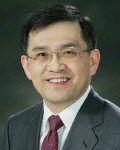
SDC 대표로 선임된 권오현 부회장(출처=네이버)
삼성디스플레이는 4월 29일 주주총회 및 이사회를 개최하여 삼성전자 대표이사인 권오현 부회장을 삼성디스플레이 대표이사로 선임했다.
삼성전자 DS부문장을 겸직하고 있는 권오현 부회장이 이번 인사를 통해 삼성디스플레이 대표이사까지 추가로 겸직하게 되면서 부품 양대 축인 반도체와 디스플레이 사업이 본격적인 시너지를 낼 수 있을 것으로 전망된다.
메모리와 디스플레이를 두로 경험한 박동건 사장은 삼성전자 DS부문으로 자리를 옮겨 미래사업 준비와 부품 사업의 핵심인 설비 및 제조 경쟁력 강화에 주력할 예정이다.

Samsung Elec.이 2016년 1Q 실적을 발표했다. (출처=삼성전자)
강현주 기자 / jjoo@olednet.com
삼성전자( Samsung Elec.)가 2016년 1분기 TV 판매 호조로 CE 사업 이익 개선을 달성한 반면 디스플레이 부문에서는 적자를 기록했다.
삼성전자는 28일 연결기준으로 매출 49조7800억원, 영업이익 6조6800억원원의 2016년 1분기 실적을 발표했다.
1분기는 ▲갤럭시S7의 조기 출시와 판매 호조, ▲메모리 고부가 제품 판매 확대, ▲시스템LSI 14nm 공급확대, ▲OLED 판매량 증가, ▲SUHD TV 등 프리미엄가전 판매확대 등을 통해 전년 동기 대비 매출은 5.7%, 영업이익은 12% 증가했다.
하지만 디스플레이 사업은 부진했다. 삼성디스플레이는 2016년 1분기 매출이 전년동기 대비 12% 하락한 6조400억원이며 영업이익은 전년동기보다 7900억원 하락한 -2700억원을 기록했다.
CE 부문은 SUHD TV와 커브드(Curved) TV 등 프리미엄 TV 판매 확대와 북미 중심 프리미엄 가전 판매 호조로 판매량이 증가해 전년동기 대비 실적이 큰 폭으로 개선됐다.
하지만 디스플레이의 경우 갤럭시S7 효과 등으로 OLED 실적이 개선됐지만, LCD의 경우, TV 패널 판가 하락과 신공법 적용 과정에서의 일시적인 수율 이슈로 실적이 감소했다.
LCD는 계절적인 비수기 수요 감소와 판매 가격 하락으로 전분기 대비 실적이 악화됐다. 반면 OLED의 경우, 신규 하이엔드용 패널 출시와 중가대 스마트폰 채용 확대에 힘입어 전분기 대비 실적이 개선됐다.
이 회사는 2분기에는 OLED 신제품 수요에 적극 대응하는 한편 고객 기반을 확대하고, UHD/초대형 등 프리미엄 LCD 판매를 강화해 실적 개선에 나설 계획이다.
삼성전자는 1분기 시설투자에 4조6000억원을 썼으며, 그 중 디스플레이 부문에는 1조8000억원을 지출했다.
2016년 디스플레이 시장은 OLED 패널 수요는 지속적으로 증가하지만, LCD 공급 과잉으로 전반적으로 시황이 어려울 것으로 예상된다.
하지만 플렉시블/고해상도 패널 증대로 OLED 실적 개선이 전망되며, LCD의 경우 하반기 시장의 수급이 개선되는 가운데, 고부가 제품 비중 확대를 통해 수익성이 좋아질 것으로 예상된다는 게 삼성의 설명이다.
